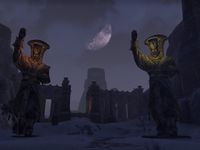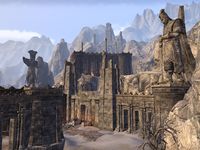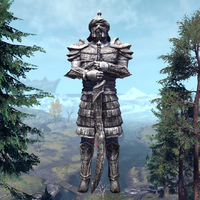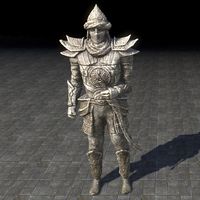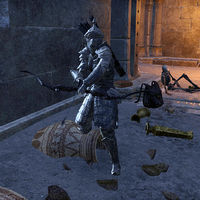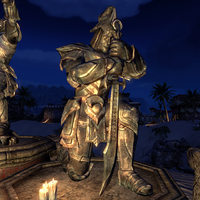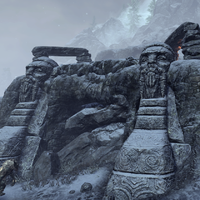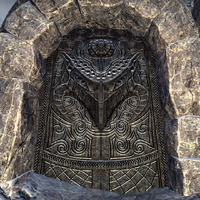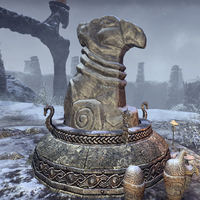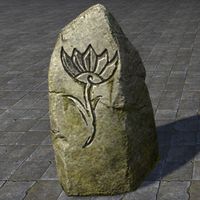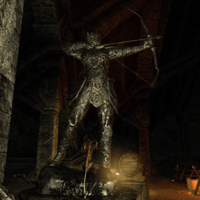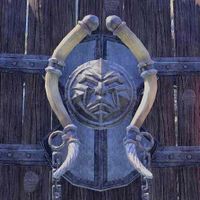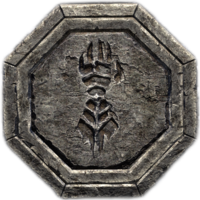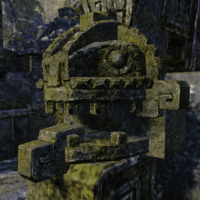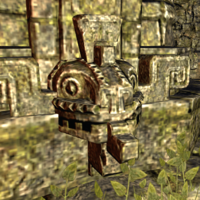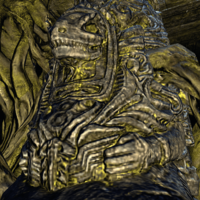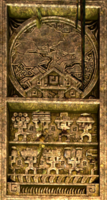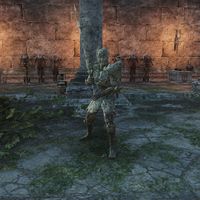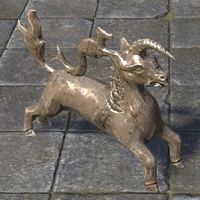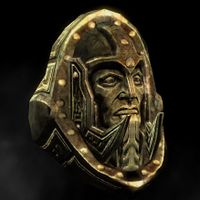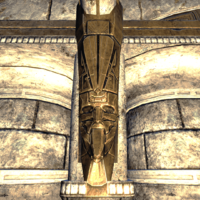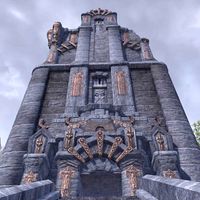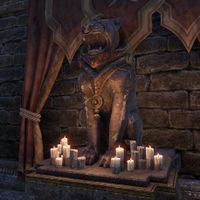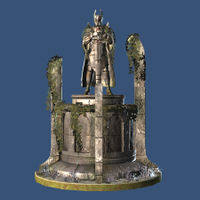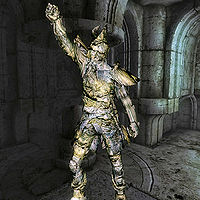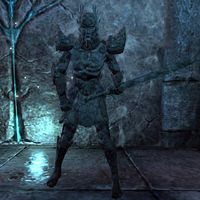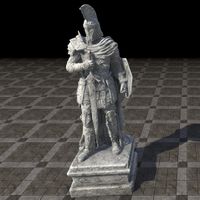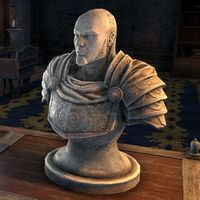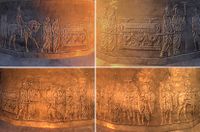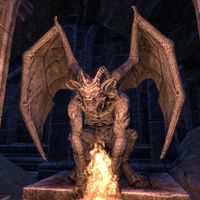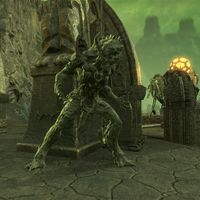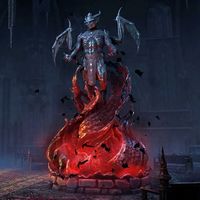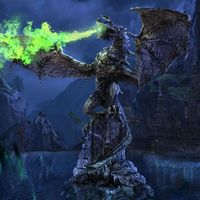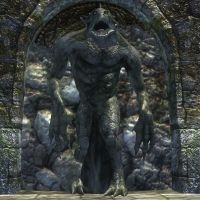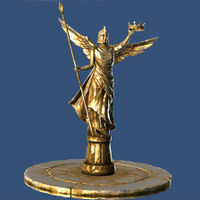User:Jimeee/Sandbox3
Contents
- 1 Table of Contents
- 2 Notable Figures
- 2.1 Alessia
- 2.2 Anahbi
- 2.3 Antus Pinder
- 2.4 Arthosiis
- 2.5 Baloth Bloodtusk and Gaiden Shinji
- 2.6 Bendu Olo
- 2.7 Brazzefk
- 2.8 Byric
- 2.9 Champions of the Blessed Crucible
- 2.10 Durak gro-Batul
- 2.11 Durcorach
- 2.12 Ettiene Volusus
- 2.13 Frandar Hunding
- 2.14 Ghelin-Brol
- 2.15 Gray Fox
- 2.16 Hubalajad
- 2.17 Ja'darri
- 2.18 Jaiv-Yora
- 2.19 Katariah
- 2.20 Khunzar-ri
- 2.21 Martinne Guimard
- 2.22 Morihaus
- 2.23 Morkuldin Trio
- 2.24 Nemfarion
- 2.25 Order of the Hour
- 2.26 Pelagius I or IV
- 2.27 Reman
- 2.28 Rislav the Righteous
- 2.29 Sai Sahan
- 2.30 Savior of Bruma
- 2.31 Shalidor
- 2.32 Thassad II
- 2.33 Topal the Pilot
- 2.34 Uriel Septim III
- 2.35 Valentis
- 2.36 Vanus Galerion
- 2.37 Vashu-Pir
- 2.38 Viridian Sentinel
- 2.39 Ylgar and Yngol
- 2.40 Ysgramor
- 3 Tribunal
- 4 Saints
- 5 Ansei Warriors
- 6 Aedra
- 6.1 Akatosh
- 6.2 Arkay
- 6.3 Auri-El
- 6.4 Dibella
- 6.5 Jephre
- 6.6 Jhunal
- 6.7 Julianos
- 6.8 Kyne
- 6.9 Kynareth
- 6.10 Magnus
- 6.11 Mara
- 6.12 Morwha
- 6.13 Orkey
- 6.14 Phynaster
- 6.15 Satakal
- 6.16 Shor
- 6.17 Stendarr
- 6.18 Stuhn
- 6.19 Syrabane
- 6.20 Tava
- 6.21 Tiber Septim / Talos
- 6.22 Trinimac
- 6.23 Tsun
- 6.24 Tu'whacca
- 6.25 Z'en
- 6.26 Zenithar
- 6.27 Xarxes
- 7 Daedric Princes
- 8 Other Deities
- 9 Other Statues
- 9.1 Alduin's Wall
- 9.2 Battle of the Bones Memorial
- 9.3 Broken Statue of Fanacasecul
- 9.4 Brothers of Strife
- 9.5 Bruma Warrior
- 9.6 Dragon Bridge
- 9.7 Great Statue of Irkngthand
- 9.8 Leki's Blade
- 9.9 Mermaid of Anvil
- 9.10 The Sentinel
- 9.11 The Skyforge
- 9.12 Standing Stones
- 9.13 Ten Ancestors
- 9.14 Weeping Giant
- 10 Generic Statues
- 10.1 Yokudan and Redguard
- 10.2 Nordic
- 10.3 Orcish
- 10.4 Argonian
- 10.5 Altmeri
- 10.6 Druidic
- 10.7 Dwemeri
- 10.8 Khajiiti
- 10.9 Ayleid
- 10.10 Imperial
- 10.11 Bretonic
- 10.12 Dunmeri
- 10.13 Gargoyle
- 10.14 Nedic (Duraki)
- 10.15 Maormeri
- 10.16 Bosmeri
- 10.17 Reachmen
- 10.18 Akaviri
- 10.19 Apocrypha Statues
- 10.20 Decorative Statues
- 11 Notes
- 12 References
- 13 Refs
Statues and sculptures play an important role for many races and cultures across Nirn, and have been used for various purposes throughout history. They serve as a testament to the artistic and creative abilities of various peoples and have been created to express a wide range of ideas, beliefs, and emotions. One of the most significant aspects of statues is their ability to preserve history. They offer a visual representation of past events, people, and cultures that have shaped Nirn - especially for extinct races (such as the Dwemer and Ayleids) where first-hand sources are non-existent. Sometimes, ancient or lost knowledge is recorded in statuary and bas-reliefs and has been re-discovered in later eras.
Statuary and sculptures allow some to gain a deeper understanding of their history and heritage and connect with their ancestors in a tangible way. This is especially true for Redguards, who maintain a connection with their original homeland of Yokuda through the numerous forms of art. Statues and sculptures can also serve as a symbol of hope, strength, and resilience. For the Altmer they can inspire individuals to strive towards greatness and can act as a reminder of the accomplishments and contributions of the people who came before. Statues of great leaders and heroes, for instance, encourage the Nords to emulate their qualities and work towards achieving their greatness. Moreover, statues and sculptures can also serve an important role in the various religions on Nirn, from the worship of the Aedra, the Daedric Princes, the Tribunal and many others. These can be a source of pride for communities and help to create a sense of identity and belonging, and act as a reminder of the unique qualities and characteristics of a particular region or culture.
Table of Contents[edit]
- Notable Figures — Statues of famous or important people throughout history.
- Aedra — Statuary and bas-reliefs of deities from the various pantheons of men and mer.
- Daedric Princes — Statuary and bas-reliefs of the eighteen infamous Daedra Lords.
- Tribunal & Saints — Statues dedicated to the Tribunal gods, Temple, Imperial and Breton saints, and notable sword-singers.
- Other Deities — Statues of uncommon and obscure deities.
- Other Statues — Assorted statues and sculptures of memorials, events, and unknown figures.
- Generic Statues — Decorative statues to illustrate the wide variety of styles across different cultures and time.
Notable Figures[edit]
Alessia[edit] | |
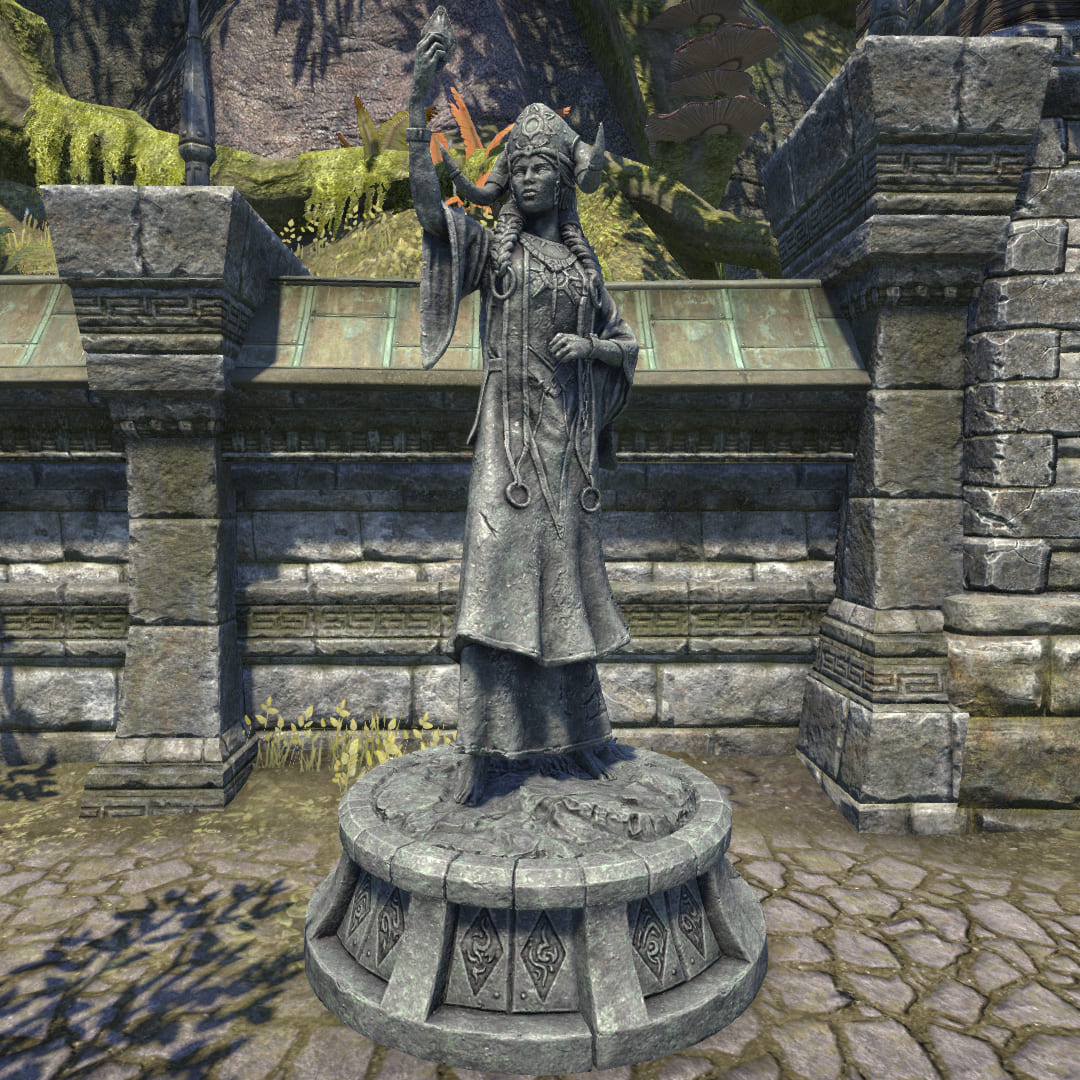 ESO |
 Oblivion |
|---|---|
|
A statue of Saint Alessia, mother of the First Empire, was uncovered in the mid-Second Era by the Antiquarian Circle in Grahtwood. This discovery was of particular note, given the Alessian Order had placed tight restrictions on graven images of Alessia and historians have never fully known what she really looked like. The statue depicts her bearing the shackles from Ayleid enslavement as she holds aloft the Amulet of Kings.[1] |
During the late-Third Era, a large statue of Queen Alessia could be seen in the Arena district of the Imperial City.[2]:344 While she still wears shackles as seen in older statuary, she is depicted wearing a dress as opposed to robes.[3] |
Anahbi[edit] | |
|
A statue of Anahbi, an ancient thief from Quin'rawl, could be found in her trap-littered tomb beneath the Redfur Trading Post. The statue functioned as a locking mechanism as her reliquary was rumored to contain untold riches, which led many treasure hunters to perish in the relentless gauntlet that guards them. Her prized treasure was, in fact, an amulet containing Jone's Tear, a jewel cut from a Varla Stone by a legendary First Era jeweler.[4][5] |
 ESO ESO
|
Antus Pinder[edit] | |
|
At the center of Kvatch stands a statue of Antus Pinder, a hero who led the defense of the city against a superior force.[6] It's unclear who this superior force refers to, but what is known is that the statue was built at some point between the mid-Second Era and the late-Third Era.[7] This fact narrows down the number of conflicts this statue stands to commemorate. Arguably the most notable conflict Kvatch endured during this period was invasion of western Tamriel in 3E 249, where the city was brutally sacked.[8] Despite being defeated gravely, a statue of Antus Pinder was erected to remember his courage and spirit.[6] |
 Oblivion Oblivion
|
Arthosiis[edit] | |||
 ESO |
 ESO |
 ESO |
 ESO |
|---|---|---|---|
|
Four bas-reliefs found in Exile's Barrow in Wrothgar tell the tale of an ancient Dragon Priest known as Arthosiis. The story begins with the priest surrounded by his devoted followers, swords raised in a celebration of some sort around the time of the Dragon War. The next panel depicts a Dragon, the priest and his followers leaving Skyrim in an exodus to Wrothgar, likely as a result of losing the war after Alduin's banishment. Next is shown the exiles building a grand temple for the dragon and his priest. The last panel is named "Ascension" and shows that after the dragon died, the priest killed himself and his followers sealed themselves in this barrow.[9][10] | |||
Baloth Bloodtusk and Gaiden Shinji[edit] | |
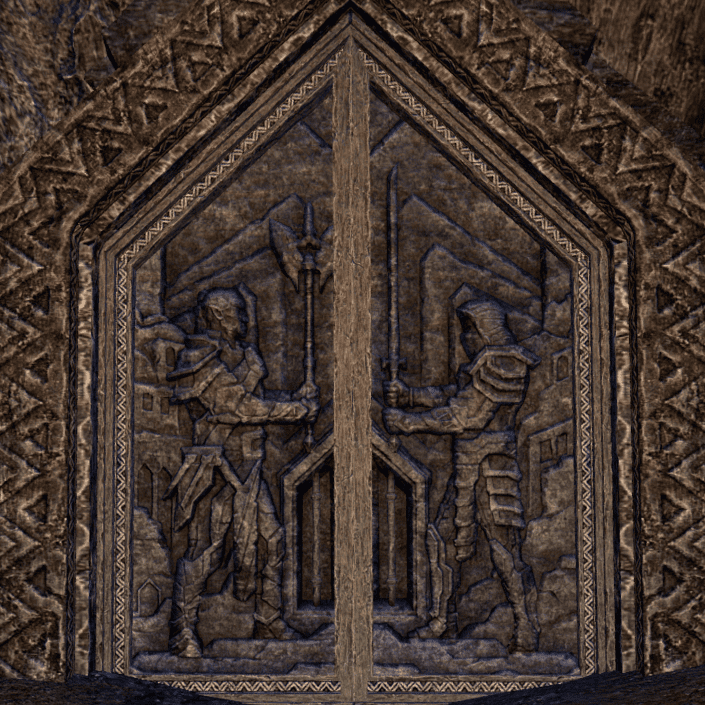 ESO |
 ESO |
|---|---|
|
Honor's Rest in Wrothgar serves as the tomb of Baloth Bloodtusk and Gaiden Shinji, two great heroes and rivals, buried together side by side. It is here various depictions of both heroes and their epic duel in the First Era can be found.[11] The duel came about after King Joile manipulated Shinji into having a duel with Bloodtusk to decide the fate of their war on Orsinium. The duel was in fact a ruse set up by King Joile to assassinate Orsinium and Hammerfell's greatest champions and leave them weakened. The plot was largely successful, leading to both heroes being cut down in the middle of their duel. After their deaths, Bloodtusk's brother Rakoug and Shinji's friend, Lord Trystan discovered King Joile treachery and decided to build them both a tomb in western Wrothgar. The tomb was built by Orcish, Redguard, and Breton masons after the destruction of the First Orsinium. Although it was primarily Orcish in design, Redguard and Breton statuary could be throughout the tomb.[12] However the fate of both heroes and the location of the tomb was lost over centuries.[13][14] Of note was the large door of the tomb that featured depictions of Baloth and Shinji. Deeper in the tomb a grand statue immortalizing the sacrifice of both warriors could be found, locked in battle. The tomb was discovered in 2E 582 by a pair of scholars who disagreed on whose tomb it was. With the help of the Vestige, they managed to unseal the tomb and experienced visions of Gaiden Shinji's and Baloth Bloodtusk's final moments during the Siege of Orsinium, and discovered the tomb belonged to both heroes.[12] | |
Bendu Olo[edit] | |
|
The Colossus of Gonfalon Bay is the name given to three-hundred foot statue dedicated to Baron-Admiral Bendu Olo. Built in the harbor of Gonfalon Bay in High Isle, it is known simply as the Colossus to High Islanders and is seen as both a wonder and a source of pride for the citizenry, and gives a sense of comfort to all who fall beneath its gaze. According to legend, as long as the Colossus stands, no harm will ever befall High Isle or the Systres archipelago.[15] The Colossus started life as an idea for the primary monument for the All Flags Navy after the remnants of that massive fleet returned to High Isle. Bendu Olo initially rejected the plans for the monument because he wanted it to honor all the ships and sailors that made up the All Flags Navy, and not just him. The plans for the Colossus were set aside while the monuments on the All Flags Islet were constructed. As the monuments were nearing completion in 1E 2274, it was decided Bendu Olo had to be properly recognized for leading the All Flags Navy against the Sload. A massive, jagged rock jutting out of Gonfalon Bay was selected, and a team of expert stone carvers and craft-mages were assembled to turn the looming peak into a work of art. The dedication ceremony and unveiling took place in 1E 2290. Elderly and in failing health, Bendu Olo nevertheless made the trek from Anvil to accept the honor. While most High Islanders continued to look upon the great Colossus with a sense of awe and wonder, by the mid-Second Era few actually knew the history behind its construction or what the statue actually represented. [15] |
 ESO ESO
|
Brazzefk[edit] | |
|
According to legend, Brazzefk was a Dwemer alchemist of great renown. His search for immortality culminated in him creating a potion designed to turn him into a living giant of stone, free from the failings of flesh. The potion was said to have worked all too well, turning his entire body into a statue, immortal but immobile. Around 2E 582, the supposed head of the Brazzefk's statue was displayed in the Endarwe's Museum of Wonder and Antiquities in Rulanyil's Fall. Speculation arose among its members if this was indeed head of Brazzefk and if he was still aware of his surroundings.[16] |
 ESO ESO
|
Byric[edit] | |
|
A statue dedicated to Sir Byric was built in the grounds behind Alcaire Castle during the mid-Second Era. It was built to commemorate his actions against Reachmen invaders in 2E 542, when he set fire to the fields surrounding Alcaire Castle and successfully held back the invaders. The Alcaire Knights were renamed Knights of the Flame to honor his bold action and determination.[17][18] |
 ESO ESO
|
Champions of the Blessed Crucible[edit]Ten statues of ten previous champions stood in an antechamber inside the Blessed Crucible in the Rift. | ||||
 Aleris the Shroud, ESO Aleris the Shroud, ESO
|
 Crow Bringer, ESO Crow Bringer, ESO
|
 Hagrof the Righteous, ESO Hagrof the Righteous, ESO
|
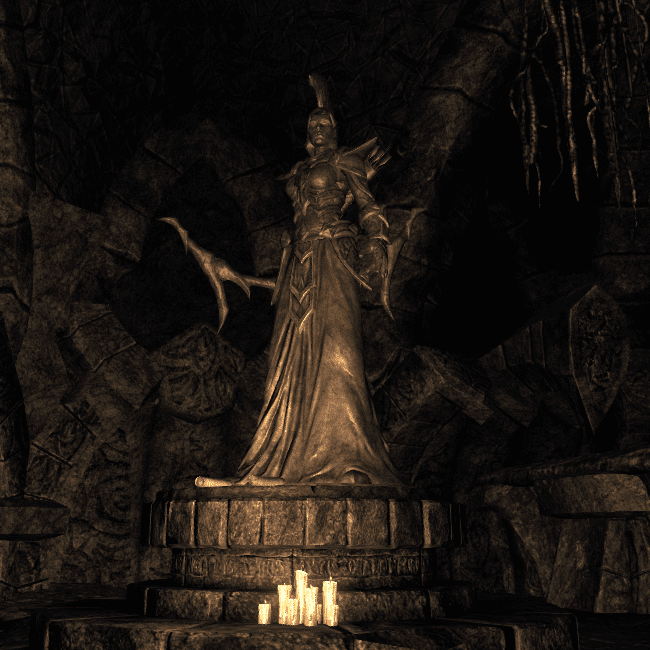 The Thousand Arrow, ESO The Thousand Arrow, ESO
|
 Lucius the Stalwart, ESO Lucius the Stalwart, ESO
|
|---|---|---|---|---|
|
Aleris, the first Champion of the Blessed Crucible, held the title for four decades. She was renowned for her skill with illusion magic and her deft swordplay. Few were able to match her skill in the arena or her favor with the crowd.[19] |
Crow Bringer was said to possess the powers of the Hagravens, allowing him to transform into a murder of crows and attack his foes from a hundred directions at once. His reign as Champion would be cut short by Hagrof the Righteous, who utilized the powers of light, incinerating the crow forms.[20] |
Hagrof was known for his honor, humility, and respect for his fellow gladiators as Champion. He was known to honor his vanquished foes with proper burials in accordance with the customs of their people. When he was finally defeated, it is said that the gladiators of every race stood in silent salute, then carried his body to an ancient pyre and gave him a funeral worthy of a Nord king.[21] |
The Thousand Arrows bested all the other gladiators with skill and precision and didn't suffer a single wound herself. After Hagrof the Righteous fell, the Thousand Arrows remained in seclusion, only emerging when a new challenger entered the arena. Her favored weapon was a bow equipped with poison-tipped arrows of her own creation, the recipe of which is hotly debated by alchemists to this day.[22] |
Lucius the Stalwart was the protege of Hagrof the Righteous. Initially, a scholar who was hired to write Hagrof's legacy, he flew into a rage at the loss of his mentor and swore to avenge him. The fight between Lucius and The Thousand Arrows was long and bloody. In the end, Lucius' ability to withstand the champion's poison allowed him to claim victory, but the process left him permanently weakened.[23] |
 Whitebear, ESO Whitebear, ESO
|
 Ferian Darkstorm, ESO Ferian Darkstorm, ESO
|
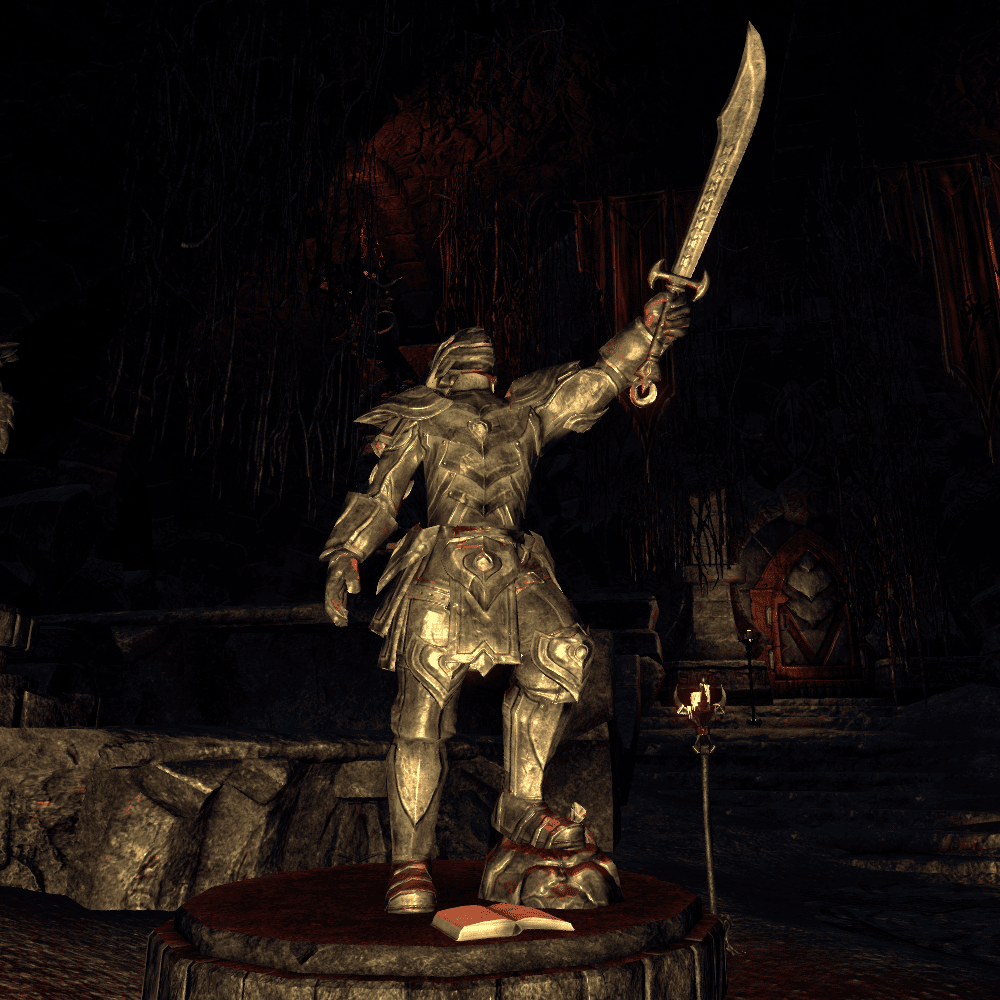 Felhorn, ESO Felhorn, ESO
|
 Sanarel the Great, ESO Sanarel the Great, ESO
|
 The Lava Queen, ESO The Lava Queen, ESO
|
|
Whitebear defeated Lucius in his weakened state and founded the first organized gladiator clan, the Bear clan. Since its founding, other renowned gladiators began to form their own clans, and thus the tradition of competing in organized groups was born.[24] |
Ferian the Passive reigned as Champion for a very short time. It is said that he grew soft and complacent once he was crowned Champion. His lack of willingness to defend his crown led to the first Gladiator Uprising, when a prominent gladiator named Felhorn led his clan into the Arena to force Ferian's hand, resulting in his eventual defeat.[25] |
Felhorn claimed the Brimstone Crown in the bloody revolt known as the Gladiator Uprising. After a monumental fight with Ferian Darkstorm, the former Champion was cleaved in two by Felhorn's enchanted sword. Humbled by his near defeat, Felhorn disbanded his army and took his seat as Champion of the Blessed Crucible. He later erected great monuments to Malacath within the arena.[26] |
Sanarel the Great reigned as Champion for nearly two centuries. His command of shield and blade were unmatched and his victories were swift and merciless. It was said that he carried a magical shield enchanted by Trinimac himself. As his legend and his arrogance grew, favor with his patron deity waned, leading to his eventual defeat at the hands of the Lava Queen.[27] |
The Lava Queen was said to be the greatest Champion the Blessed Crucible has ever known. Reigning for nearly four centuries, all challengers who dared face her in the Arena were overwhelmed by her fiery magic, as if they were fighting a living volcano. Its said her mastery of the arena was so complete that the very ground shaped and molded itself to her will.[28] |
Durak gro-Batul[edit] | |
|
A statue known as the King's Sepulcher was built in the town of Rivercrest during the Fourth Era. It pays homage to Durak gro-Batul, a figure of much respect in the region who served as the first Bloodfall King and was also the grandfather of the Bloodfall Queen Urzoga gra-Batul. The statue depicts Durak wielding two war-axes as a serpent is wrapped around the plinth.[29] |
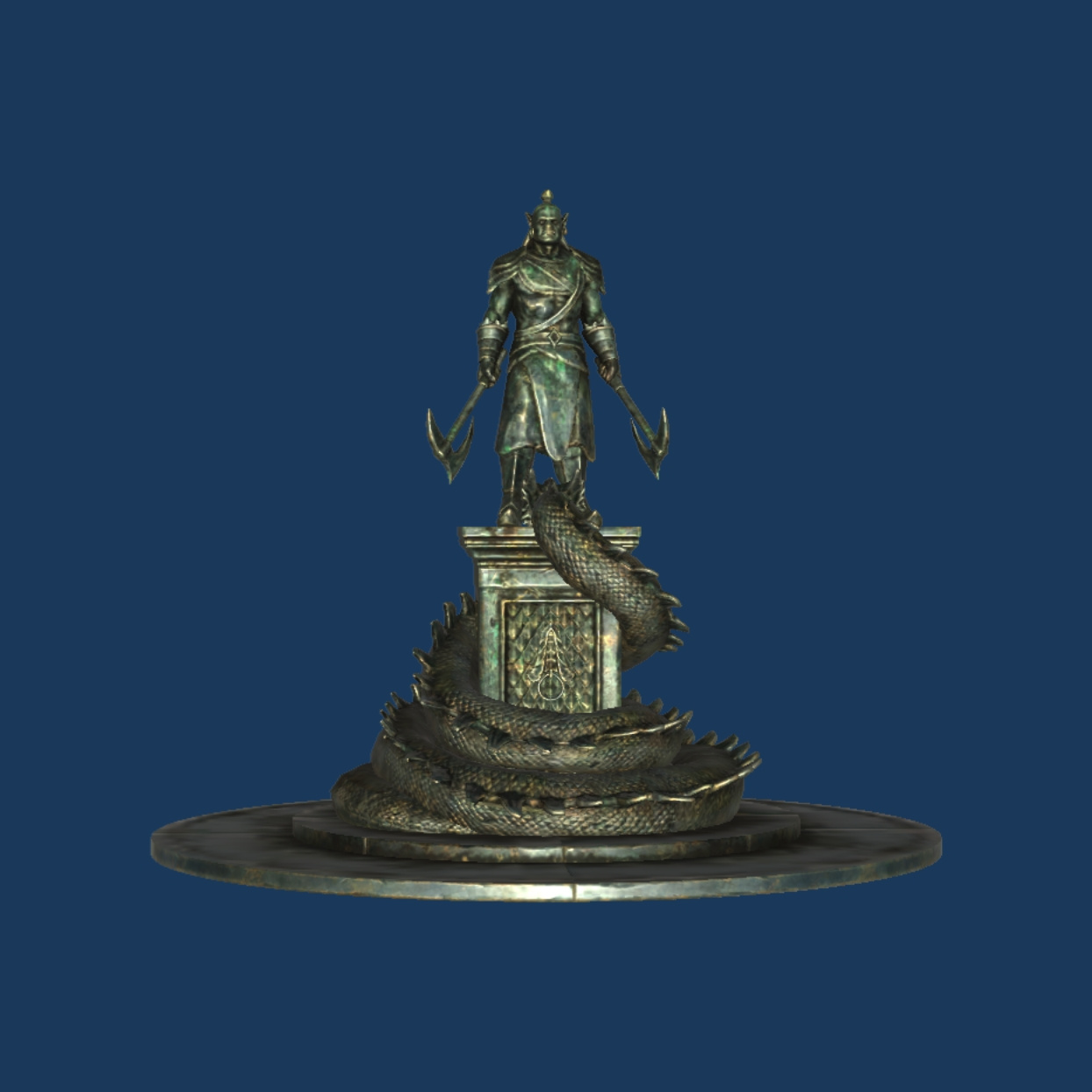 Blades Blades
|
Durcorach[edit] | |
|
Despite ruling as emperor, the only known artistic depiction of Durcorach is found in the athenaeum of Black Drake Villa, his grand retreat on the Gold Coast. The bas-relief depicts Durcorach conquests as he and his Reachmen army march on the Imperial City.[30] |
 ESO ESO
|
Ettiene Volusus[edit] | |
|
Ettiene Volusus was one of the four greatest grandmasters of the Dragonguard in the late-First Era. She was the chronicler of their history and is remembered as being modest, honest, and astute. After her death, a statue of her was built in Wind Scour Temple alongside the other great grandmasters.[31][32] During the return of Kaalgrontiid, Sai Sahan briefly traveled to the temple during his quest to learn the old ways of dragon slaying. Ettiene's statue was discovered to be part of a mechanism that allowed Sai to reach the hidden Dragonguard archives, wherein he learned about the fabled Horn of Ja'darri.[33] |
 ESO ESO
|
Frandar Hunding[edit] | |
 ESO ESO
|
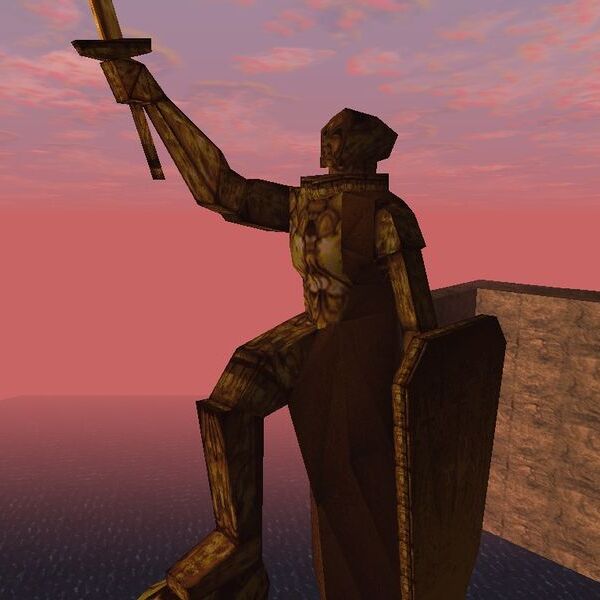 Redguard Redguard
|
|---|---|
|
The Statue of Hunding is a monument found west of Stros M'Kai's harbor. It is dedicated to the legendary Yokudan hero, Frandar Hunding, who is said to have driven the goblins of Hammerfell back into the earth. The statue depicts Hunding armed with a sword, resting his foot on a goblin's head. According to local legends, the statue's presence keeps the goblins underground.[34] Inside the statue is a hidden room that was discovered by Cyrus in 2E 864. Here he found the Talisman of Hunding, which he used to open a crack in the wall in the Goblin Caverns.[35] | |
Ghelin-Brol[edit] | |
|
Ghelin-Brol was one of the four greatest grandmasters of the Dragonguard in the late-First Era. He is remembered as the first grandmaster of the order and was appointed by Reman I himself. After his death, a statue of him was built in Wind Scour Temple alongside the other great grandmasters.[36][32] During the return of Kaalgrontiid, Sai Sahan briefly traveled to the temple during his quest to learn the old ways of dragon slaying. Ghelin-Brol's statue was discovered to be part of a mechanism that allowed Sai to reach the hidden Dragonguard archives, wherein he learned about the fabled Horn of Ja'darri.[33] |
 ESO ESO
|
Gray Fox[edit] | |
|
The leader of the Thieves Guild, Mercer Frey, kept a small bust of the Gray Fox in Riftweald Manor in Riften. It depicts a figure wearing the infamous Gray Cowl of Nocturnal. The bust was stolen in the early-Fourth Era after Mercer Frey betrayed the guild, and later put on display in the thieves guildhall.[37] |
 Skyrim Skyrim
|
Hubalajad[edit] | |
|
Prince Hubalajad, more commonly known as Prince Hew, was a Yokudan noble who colonized Hew's Bane during the First Era. He is believed to have commissioned a colossal idealized statue of himself, named "Hubalajad's Reflection", near the docks of Abah's Landing that depicts him holding a sword while a large Sep Adder is wrapped around his torso.[38][39] Some Second Era apologist historians however claim the statue does not represent Hubalajad and that this belief is erroneous.[40] |
 ESO ESO
|
Ja'darri[edit] | |
|
Ja'darri the Endless was an ancient Khajiiti hero who founded Pridehome and formed the Pride of Alkosh.[41][42] She bore the Mask of Alkosh, a relic capable of granting the bearer immense power when tapped into by a Dragon. She is best remembered as the one who succeeded in imprisoning the dragon Laatvulon in ancient times, however it cost Ja'darri her life.[43][44][45] She was buried in Halls of the Highmane in Elsweyr with the Mask of Alkosh, and a statue of her holding an hourglass and wearing the mask was erected in her burial chamber. A plaque with an inscription briefly gave details of her life.[41] Another statue of her was built in Pridehome that bore an inscription in honor of her sacrifice.[46] |
 ESO ESO
|
Jaiv-Yora[edit] | |
|
Jaiv-Yora was one of the four greatest grandmasters of the Dragonguard in the late-First Era. She is remembered for overseeing the construction of the Alduin's Wall in Sky Haven Temple under the rule of Emperor Reman II. After Jaiv-Yora's death, a statue of her was built in Wind Scour Temple alongside the other great grandmasters.[47] During the return of Kaalgrontiid, Sai Sahan briefly traveled to the temple during his quest to learn the old ways of dragon slaying. Jaiv-Yora's statue was discovered to be part of a mechanism that allowed Sai to reach the hidden Dragonguard archives, wherein he learned about the fabled Horn of Ja'darri.[33] |
 ESO ESO
|
Katariah[edit] | |||
|
A golden figurehead bearing the likeness of Empress Katariah graced the eponymously named flagship of Emperor Titus Mede II during the early-Fourth Era.[48] Katariah was proclaimed Empress upon the death of her husband in 3E 153, and her almost fifty-year reign is remembered as a happy one.[49] |
 Skyrim Skyrim
| ||
Khunzar-ri[edit] | |||
 ESO ESO
| |||
|---|---|---|---|
|
In the Halls of Colossus in Elsweyr, a series of bas reliefs depict the legendary hero Khunzar-ri and his epic battle with Kaalgrontiid and his rage of dragons during the Merethic Era. The reliefs then shows the dragon being imprisoned in the Halls of Colossus.[50][51][52] The last panel depicts Khunzar-ri's betrayal at the hands of Cadwell, who sought the power of Jode's Core.[53] | |||
Martinne Guimard[edit] | |
|
A statue of Duchess Martinne of the Guimard family was built on High Isle at some point before the mid-Second Era. She is best remembered as the leader of a consortium of coin-barons that purchased the Systres archipelago from the Colovian kings during the late-First Era. She dubbed the largest island "High Isle," in honor of High Rock, the Bretons' ancestral homeland.[54] |
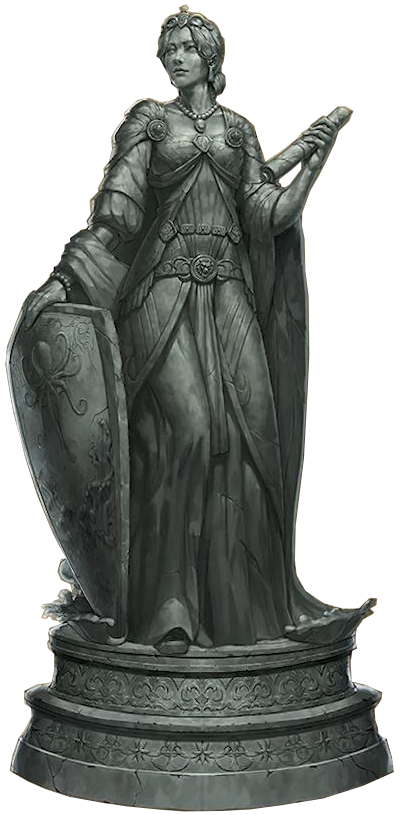 ESO ESO
|
Morihaus[edit] | |
 ESO ESO
|
 Oblivion Oblivion
|
|---|---|
|
Golden statuettes and a bust of Morihaus was uncovered in the mid-Second Era by the Antiquarian Circle in Cyrodiil.[55][56] Although numerous sources describe Morihaus as a winged bull, be it a bull-man,[57] man-bull,[58] or the Bull of Kyne,[59] there was heated debate in scholarly circles during this time arguing what Morihaus actually looked like, and if depictions of him as literally bull-like were accurate or specious. Some argued that the winged bust was a symbolic representation of the subject, given the vacant, bovine expression bore no heroic personality and the wings were far too small. Others claimed that the existence of minotaurs was proof enough that chimeric creatures existed, and that a demigod exhibiting those traits was well within the realm of possibility.[55] This dispute has roots going back to the early years of the Alessian Order where horned depictions of Morihaus' son, Emperor Belharza the Man-Bull, were considered heretical as early as the 1E 1300s. Some scholars explain this shift by suggesting the Alessian Doctrines were applied to any non-human races xenophobic Alessians felt like persecuting. One controversial interpretation of an ancient tablet fragment called the Belharza Stone goes as far as asserting that the precursors of the Order may have murdered Belharza, and violently purged minotaurs from the Empire.[60] Conversely, Alessian vessels containing sacramental oil bore etchings of horns, adding to the confusion and leading some scholars to speculate this was how early Alessian priests honored Morihaus and Belharza. Similarly, Nibenese depictions of Morihaus and Belharza, albeit rare, were said to bear horns.[61] By the mid-Second Era, claims that minotaurs were descendants of Alessia and her consort Morihaus, were seen as lightly heretical and absurd among some scholars.[57] |
In the Third Era, a statue of "Pit Fighter" Morihaus was seen in the Arena District of the Imperial City but, unlike the previous depiction, he was fully human, dressed in gladiatorial attire and holding a set of shackles.[3][62]:344[nb 1] |
Morkuldin Trio[edit] | ||
 Baloth Bloodtusk, ESO Baloth Bloodtusk, ESO
|
 Mazghar Many-Tongues, ESO Mazghar Many-Tongues, ESO
|
 Lakora of the Hunt, ESO Lakora of the Hunt, ESO
|
|---|---|---|
|
Morkuldin in Wrothgar was the ancestral stronghold of Morkul Clan. Old Orcish poems claim it was founded by a heroic trio, Baloth Bloodtusk, Mazghar Many-Tongues and Lakora of the Hunt, who "rebuffed winter's grasp" and "found haven beneath."[63] Large statues were erected of the three heroes deep in Morkuldin, which also served as a locking mechanism for Morkuldin's great blood-forge.[64][65][66] Later Orcish poems tell that Morkuldin was "buried in ice, and stone-marked thrice", which alludes to the ancient stronghold falling to the elements and abandoned.[63] | ||
Nemfarion[edit] | |
|
A statue of Kinlord Nemfarion could be found in the sunken ruins of Corgrad, the city he founded and once ruled on Summerset Isle. During the Thrassian Plague circa 1E 2200, he drowned the city in an effort to stop the disease from spreading, then used blood sacrifices from the city's survivors to prolong his and his family's lives.[67][68] |
 ESO ESO
|
Order of the Hour[edit]The first reformation of the Order of the Hour in 2E 432 began with four founders, whose statues were built in Knightsgrave in Cyrodiil.[69][70][nb 2] | |||
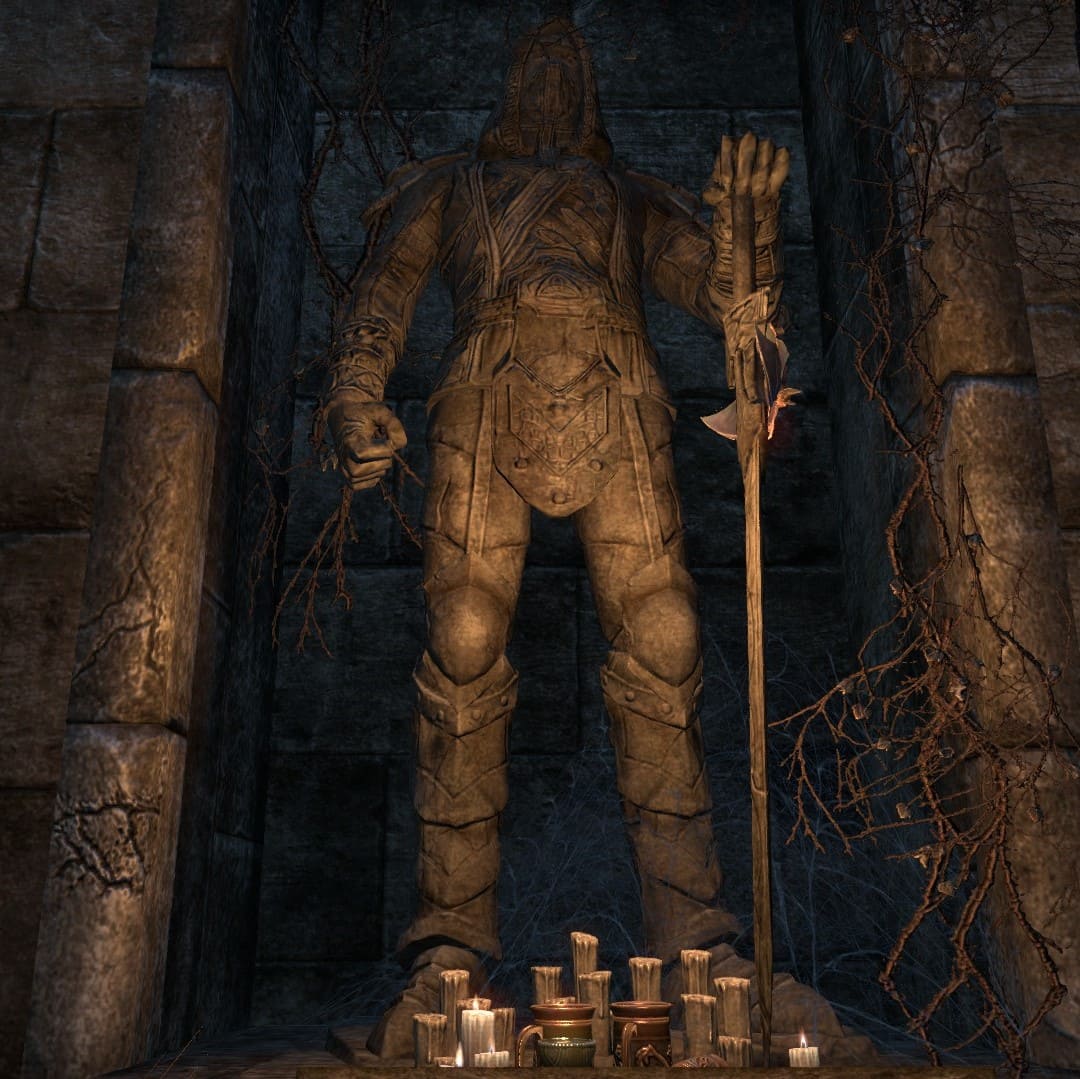 Cavor Merula, ESO Cavor Merula, ESO
|
 Justia Desticus, ESO Justia Desticus, ESO
|
 Rusio Olo, ESO Rusio Olo, ESO
|
 Amminus Entius, ESO Amminus Entius, ESO
|
|---|---|---|---|
| Cavor Merula was a warrior-priest who formed the order from Kvatch in response to the fall of the Second Empire, fearing for the safety of the Akatosh Chantry and its many historic and religious memorabilia. He gathered a group of warrior-priests to defend the cathedral, and thus the Order of the Hour was reborn.[71] | Justia Desticus was the original First Sword of the Order of the Hour and stood by Cavor's side and devised the Rigors of Akatosh, eight traits to which all members must aspire. She is considered the second in devotion in Akatosh's eyes.[72] | The third pillar of the Order of the Hour's original complement of warrior-priests, Rusio Olo, was instrumental in ending the Order of the Black Worm's infestation of Kvatch in 2E 437. He dispatched eight cultists and their leader singlehandedly.[73] | Amminus Entius was known as the fourth pillar of the Hour and was Cavor's oldest friend and the Order's first quartermaster. He established the infrastructure for ensuring that Akatosh's knights were the best-fed, best-equipped, and best-trained force in Kvatch.[74] |
Pelagius I or IV[edit] | |
|
A statue described confusingly as "Pelagius IV: Son of Tiber Septim"[75]:347 was built in the Market District of the Imperial City at some point in the Third Era. Which ruler the statue depicts is unclear because Pelagius I is described as Tiber's eldest son in some sources,[76] and his grandson in others.[77] Further, Pelagius IV was born around 300 years after Tiber Septim.[78] |
 Oblivion Oblivion
|
Reman[edit] | |
|
A large sculpture of Reman's head could be found in Sky Haven Temple.[79] It was built around the same time as Alduin's Wall in 1E 2812 and was connected to a magical Blood Seal that served as the locking mechanism to the temple's entrance.[80] |
 Skyrim Skyrim
|
Rislav the Righteous[edit] | |
|
A statue of King Rislav Larich, known also as Rislav the Righteous, could be found in Skingrad during the late-Third Era. He is depicted on his horse with his hawk perched upon his hand.[81]:365 He is noted in history after he liberated Skingrad from under the rule of Emperor Gorieus, after which he was crowned king.[82] |
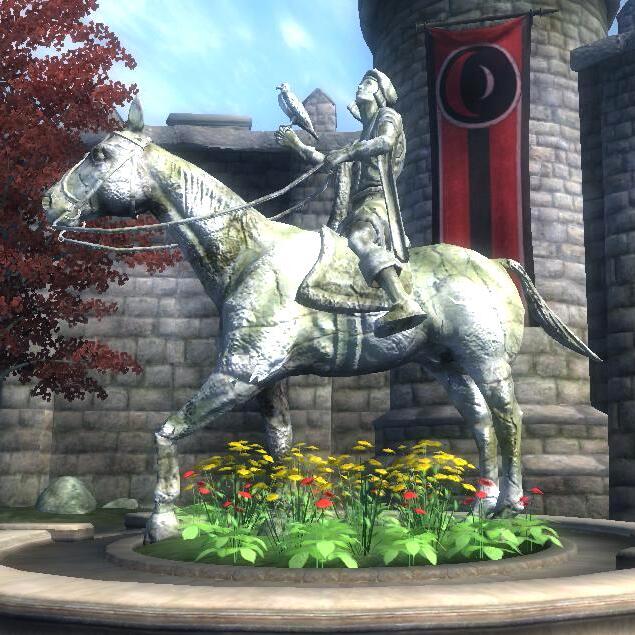 Oblivion Oblivion
|
Sai Sahan[edit] | |
|
A statue of Sai Sahan was built in Leyawin during the mid-Second Era to honor of the sword-master after he freed the city from Reachmen occupation. According to some, he emerged victorious, returning to the rebellion base at Bruma weeks later with eighty-six enemy scalps. Accounts of the battle vary: some believe he single-handedly liberated Leyawiin in one battle, while others say he murdered the guards for days until the Reachmen eventually left the settlement with their mercenaries.[83] |
 ESO ESO
|
Savior of Bruma[edit] | |
|
A statue of the Savior of Bruma, also known as the Hero of Kvatch, was erected in the city of Bruma during the Oblivion Crisis in the late-Third Era. After Mehrunes Dagon opened a Great Oblivion Gate outside the city walls, the hero ventured into the Deadlands and closed it before a Daedric siege engine could destroy Bruma and Cloud Ruler Temple. Bruma was saved from destruction and the hero was named the "Savior of Bruma". A statue was built in their honor and many songs and stories were told of this battle thereafter.[84][85][nb 3] |
 Oblivion Oblivion
|
Shalidor[edit] | |
|
A large statue of Arch Mage Shalidor could be found in the courtyard of the College of Winterhold.[86] According to legend, Shalidor built the city of Winterhold with a whispered spell.[87] |
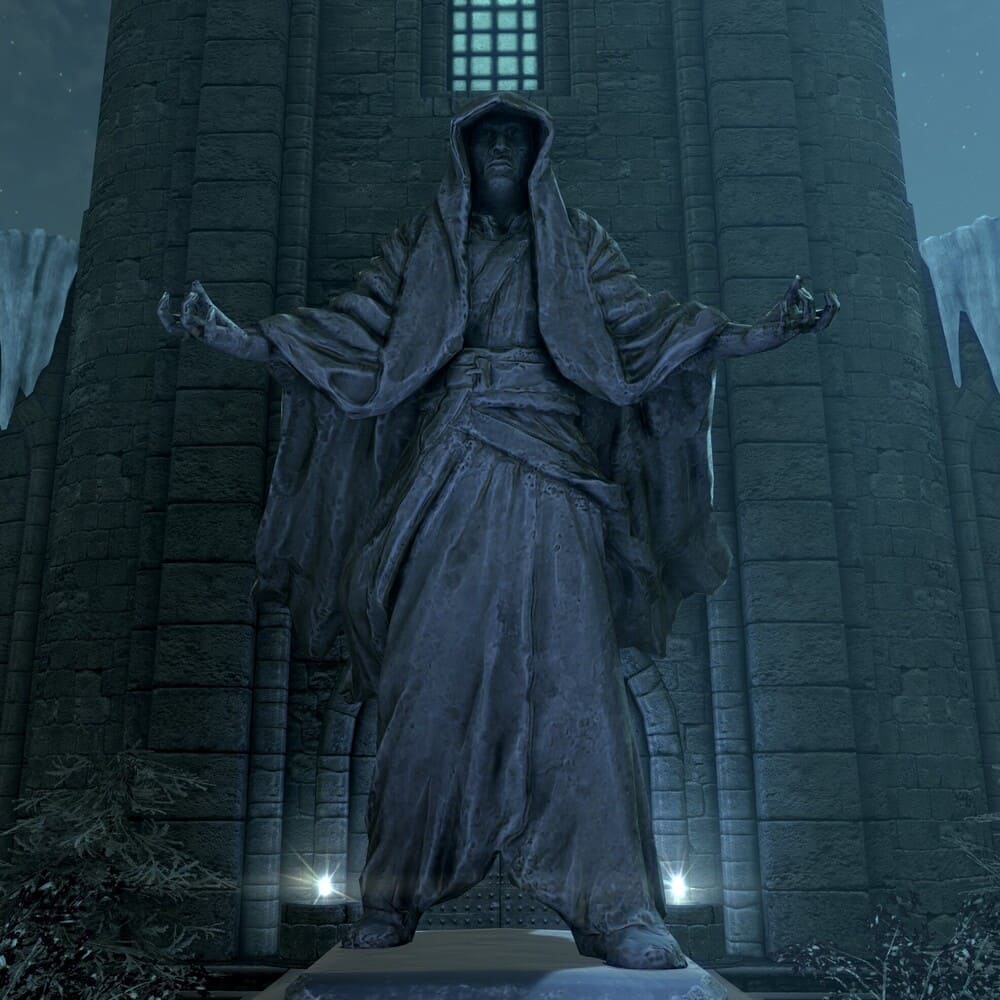 Skyrim Skyrim
|
Thassad II[edit] | |
|
The headless statue of High King Thassad II could be found northwest of Port Hunding on Stros M'kai. Upon his death, the city of Sentinel was taken by the Forebears, despite Thassad's truce with Baron Volag. Thassad's son, Prince A'tor, attempted to recapture the city but was eventually defeated by combined forces of the Forebears and Tiber Septim's fleet at the Battle of Hunding Bay.[88][89][90] |
 Redguard Redguard
|
Topal the Pilot[edit] | |
|
A statue of Topal the Pilot was erected in the city of Leyawiin at some point after the mid-Second Era. He is depicted holding a map.[91]:363 He was the first known Aldmer to explore Tamriel, charting its sea lanes in the Merethic Era on his ship the Niben, after which the Niben River was named.[92] By the late-Third Era he was recognised as the patron saint of Leyawiin.[93] |
 Oblivion Oblivion
|
Uriel Septim III[edit] | |
| A statue of Uriel Septim III was built in the Market District of the Imperial City at some point in the Third Era. It stood as a monument to Uriel III's victory in the War of the Red Diamond.[94]:347 | 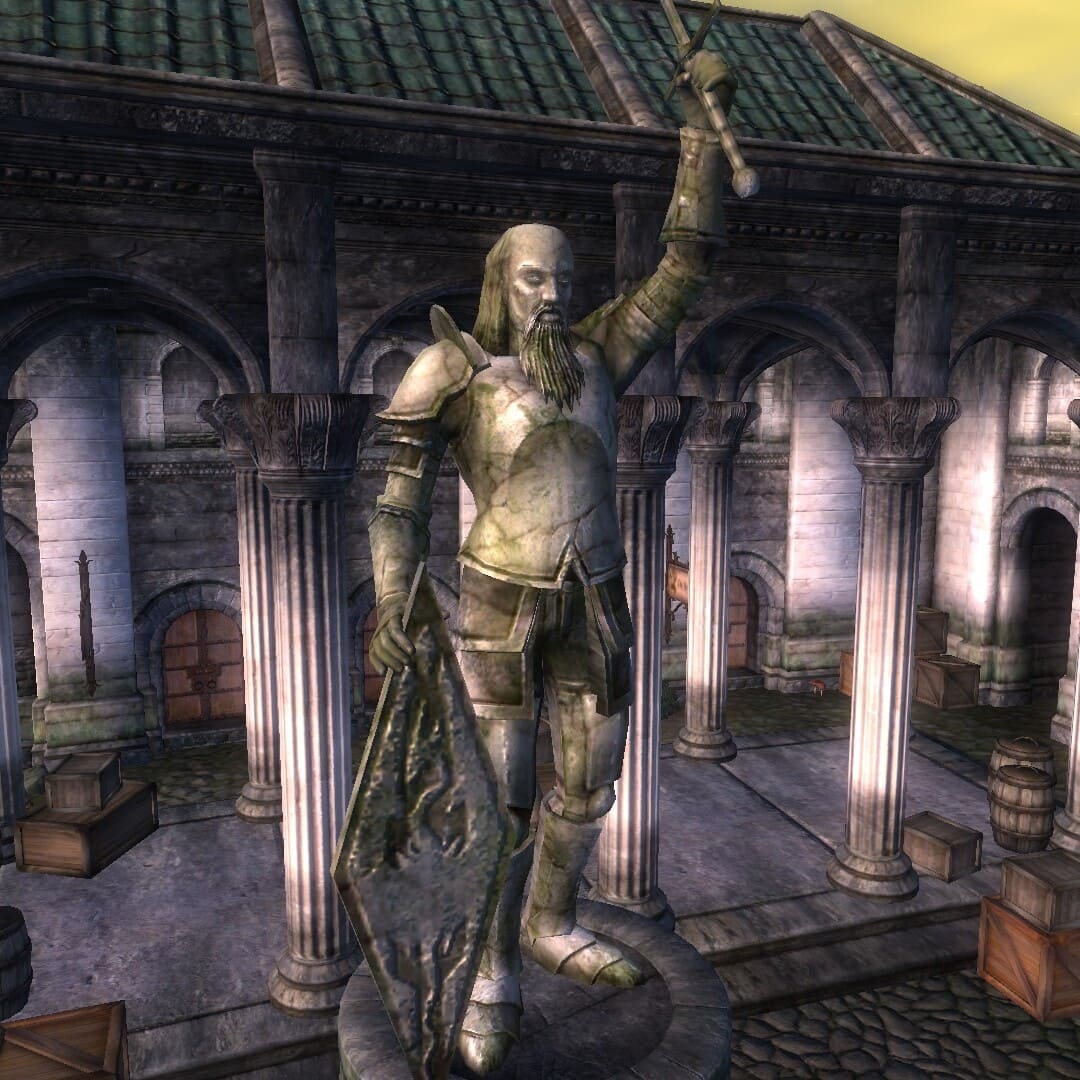 Oblivion Oblivion
|
Valentis[edit] | |
|
A marble statue of the Ayleid ruler named King Valentis riding a Gryphon was built above an ancient and mysterious crypt in Cyrodiil. Known as the Founder's Statue or Elder Statue, the enchanted statue's origins and significance was lost to time for centuries until the early-Fourth Era. During the First Era when the Ayleids ruled Cyrodiil, a powerful and feared sorcerer-king known as Celemaril Light-Bringer sought to conquer Tamriel with an undead army. Celemaril's own brother, Valentis, led other Ayleid kings in a rebellion against Celemaril. By performing a ritual incantation using varla stones and an Elder Scroll, Valentis sealed his immortal brother within a crypt beneath a statue bearing his likeness. He then placed a warding enchantment upon the statue to ensure Celemaril's spirit remained sealed in the crypt.[95][96][97] Valentis ruled as king and went to great length to have Celemaril's name and conquest erased from historical records. He also founded the town of Rivercrest at the site of the statue that sealed Celemaril.[98][97] Centuries passed and most records of the brother's conflict and who the statue represented was lost to time. By the Fourth Era the statue became known as the "Founder's Statue" by the citizenry.[99][97] Around 4E 180 an Imperial vassal known as the Bloodfall Queen hired mercenaries to collect taxes from Rivercrest. Things escalated and one of the mercenaries smashed the ancient statue, which in turn wrought destruction upon the town and released Celemaril from his ancient bindings. To rebind the Celemaril, the Warrior retrieved the same items that were used to originally seal him and rebuilt the destroyed statue in the town square.[100] Around the same time Celemaril had amassed another undead army and launched a final assault upon Rivercrest. The Warrior fought against the Sorcerer-King and was ultimately victorious and sealed Celemaril beneath Rivercrest once more.[101] |
 Blades Blades
|
Vanus Galerion[edit] | |
|
A statue of Vanus Galerion was found outside the Mages guildhall in Cheydinhal during the late-Third Era.[102]:359. Vanus is best remembered as the founder of the Mages Guild and one of the most famous practitioners of magic in the history of Tamriel.[103] He is depicted holding a torch and wears a long beard (contrary to his appearance during the mid-Second Era). |
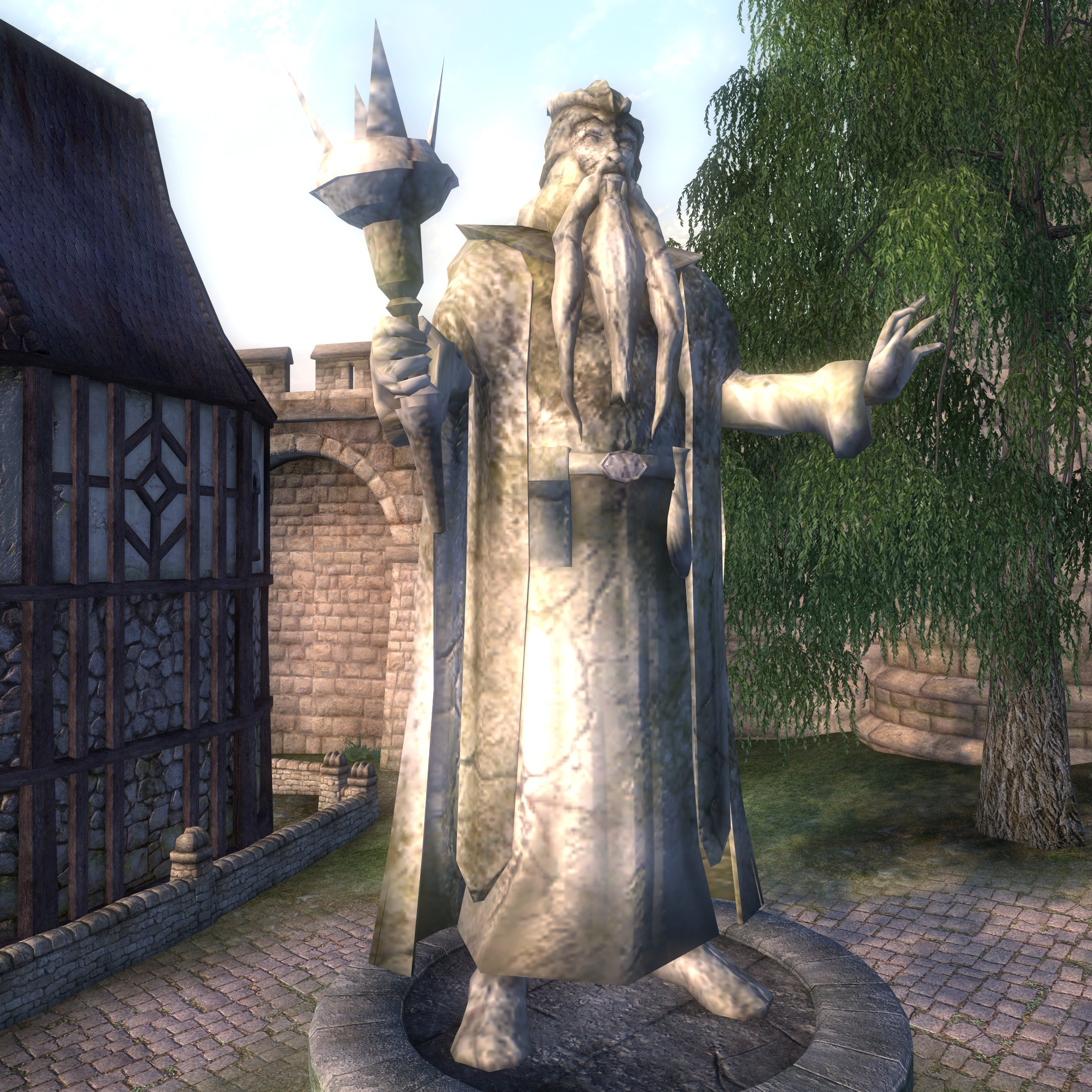 Oblivion Oblivion
|
Vashu-Pir[edit] | |
|
Vashu-Pir was one of the four greatest grandmasters of the Dragonguard in the late-First Era. He is remembered for defeating the dragon Laatvulon, alongside the Khajiiti hero Ja'darri.[104] After Vashu-Pir's death, a statue of him was built in Wind Scour Temple alongside the other great grandmasters.[105] During the return of Kaalgrontiid, Sai Sahan briefly traveled to the temple during his quest to learn the old ways of dragon slaying. Vashu-Pir's statue was discovered to be part of a mechanism that allowed Sai to reach the hidden Dragonguard archives, wherein he learned about the fabled Horn of Ja'darri.[33] |
 ESO ESO
|
Viridian Sentinel[edit] | |
|
A statue of a Viridian Sentinel wielding a bow stood in the forests of northern Bangkorai during the mid-Second Era. A Viridian Sentinel was a chosen individual who protected the inhabitants of the forests through a pact with Stendarr.[106][107] Statues of these guardians of the forest were also revered by the Glenmoril Wyrd around this time.[108] |
 ESO ESO
|
Ylgar and Yngol[edit] | |
 ESO |
 ESO |
|---|---|
|
Statues of Ysgramor's sons, Ylgar and Yngol, wielding battle-axes were built in the Companions' ancient headquarters of Fallowstone Hall. Within the Hall of the Dead were also various relics from the past, accompanied by plaques that describe their history.[109][110] | |
Ysgramor[edit] | |||
 ESO ESO
|
 Skyrim Skyrim
| ||
|---|---|---|---|
|
Statuary of Ysgramor has been linked to his legendary battleaxe, Wuuthrad, on at least two occasions. The first statue was erected in the Hall of Heroes, beneath Fallowstone Hall. It was here Ysgramor stood clutching Wuuthrad with the plaque mentioning the mighty axe of legend.[111] Fallowstone Hall was attacked by the Order of the Black Worm in 2E 582, led by the necromancer Thallik Wormfather, who stole Wuuthrad from the statue. Thallik sought to use Wuuthrad to reanimate the giant Sinmur and an army of his kin, but was ultimately defeated.[112][113] |
The second statue could be found in Ysgramor's Tomb on the northern coast of Skyrim. It was here the statue of the harbinger stood once again in a pose as if clutching Wuuthrad. The difference here was that Wuuthrad and the statue served as a locking mechanism for his tomb, so that when the Wuuthrad was placed in the statue's hands, the tomb would open. By the Fourth Era Wuuthrad had been shattered into pieces and the fragments were kept in the Companions' mead hall of Jorrvaskr. In 4E 201, Eorlund Gray-Mane was able to reforge the ancient weapon and, with the aid of the Last Dragonborn, the Companions were able to access the tomb of Ysgramor in an effort to cure their Lycanthropy.[114] | ||
 ESO ESO
|
 ESO ESO
|
 ESO ESO
|
 ESO ESO
|
|
Other statues of Ysgramor could be found across Skyrim, typically fully armored and wielding an axe.[115] Depictions of the harbinger were not limited to statuary and it is said his forebears likely adorned their weapons, armor and even silverware with his image, believing his face would lend legitimacy to any official act.[116] A mid-Second Era music box depicted a carved wooden miniature of Ysgramor and the five hundred companions aboard a longship.[117] | |||
Tribunal[edit]
Tribunal[edit] | |
 ESO ESO
|
 Morrowind Morrowind
|
|---|---|
|
Statuary or bas-reliefs of all three members of the Tribunal are uncommon, but one example was a wooden triptych where the three were featured alongside the Daedric letters they represented: Ayem for Almalexia, Vehk for Vivec and Seht for Sotha Sil.[118] |
Arguably the most prominent statuary that featured all three was the large sculptures of the Tribunal carved into the posts along the Ghostfence.[119] |
Almalexia[edit] | |||
 ESO ESO
|
 Morrowind Morrowind
|
 Morrowind Morrowind
|
 Skyrim Skyrim
|
|---|---|---|---|
|
Statuary and reliefs of Almalexia in Morrowind sometimes featured her wearing her war mask and dressed modestly in robes, which is said to be in stark contrast to how she actually appears.[120] Given her title of "Mother Morrowind", other statuary features her in a more motherly role where she is depicted with her arms crossed over her pregnant belly.[121] |
A great statue of Almalexia in battle with Mehrunes Dagon was built in the Plaza Brindisi Dorom in Mournhold at some point after the mid-Second Era. It commemorates Almalexia and Sotha Sil's victory over the Prince of Destruction after he destroyed the royal city of Old Mournhold at the end of the First Era in 1E 2920. Although Almalexia and Sotha Sil arrived too late to prevent the city's destruction, they managed to banish Mehrunes Dagon back to Oblivion.[122] |
After the fall of the Tribunal following the Red Year, worship of Almalexia and the Tribunal was replaced by the Reclamations.[123] On Solstheim rebel priests and devotees of the old way continued to worship the Tribunal, and built a hidden temple and a large statue of Almalexia in Ashfall's Tear, a cave found north of Raven Rock.[124] | |
Sotha Sil[edit] | |
 ESO ESO
|
 ESO ESO
|
|---|---|
|
Depictions of Sotha Sil on Tamriel are uncommon, but one tablet bas-relief features him in a highly stylized form wearing his unique mask. A similar depiction can also be found on some frescos in Vvardenfell.[125] Various depictions of Sotha Sil could be found in the Clockwork City during the mid-Second Era, such as polished copper figurines that were presented to new Clockwork Initiates after their induction into the order.[126][127] Of note was a Dwarven Metal statuette of Sotha Sil depicted as a Dwarven Centurion, crafted by an artisan known as Zephalas.[128] |
The most prominent depiction of Sotha Sil was a large statue of the Clockwork God holding a sphere, which could be found at the center of the Brass Fortress within the Clockwork City, his miniature metaphysical realm.[129] |
Vivec the Champion[edit] | |
 ESO ESO
|
 Morrowind Morrowind
|
|---|---|
|
A statue of Vivec, also known as "Vivec the Champion" and the "Shrine of Generosity", was built in the Temple Canton of Vivec City during the mid-Second Era. It was built to commemorate the people who suffered and died in the War of the First Council, where the Chimer fought with the Dwemer.[130] Curiously, by the late-Third Era the Shrine of Generosity was moved to the top of the stairs to Vivec's Palace, but the statue of Vivec remained in the Temple Canton.[131] | |
Vivec and the last N'chorbal[edit] | |
 ESO ESO
|
 Morrowind Morrowind
|
|---|---|
|
A statue known as "Vivec's Triumph" depicts Vivec killing the last N'chorbal on Vvardenfell with his spear Muatra.[UOL 2] It was built in the Temple Canton of Vivec City during the mid-Second Era.[132] | |
Vivec and Gulga Mor Jil[edit] | |
|
A statue of Vivec standing over the remains of Gulga Mor Jil, holding aloft one of his tusks was built in the Guild Plaza of Necrom.[133] Its sometimes referred to as "Vivec's Triumph" or the "Thirty-Fourth Sermon".[134] Gulga Mor Jil was one of Vivec's eight monster children he bore in an unholy union with Molag Bal. He was said to be the mightiest of his children and his name was a string of power.[135][136] Unlike his other children, Gulga Mor Jil showed no violent nature or intent to harm others and accepted his death peacefully. His bones went on to lay the foundations of Necrom and runes were transcribed onto his tusk to create the Fulcrum Obscura.[135][137] |
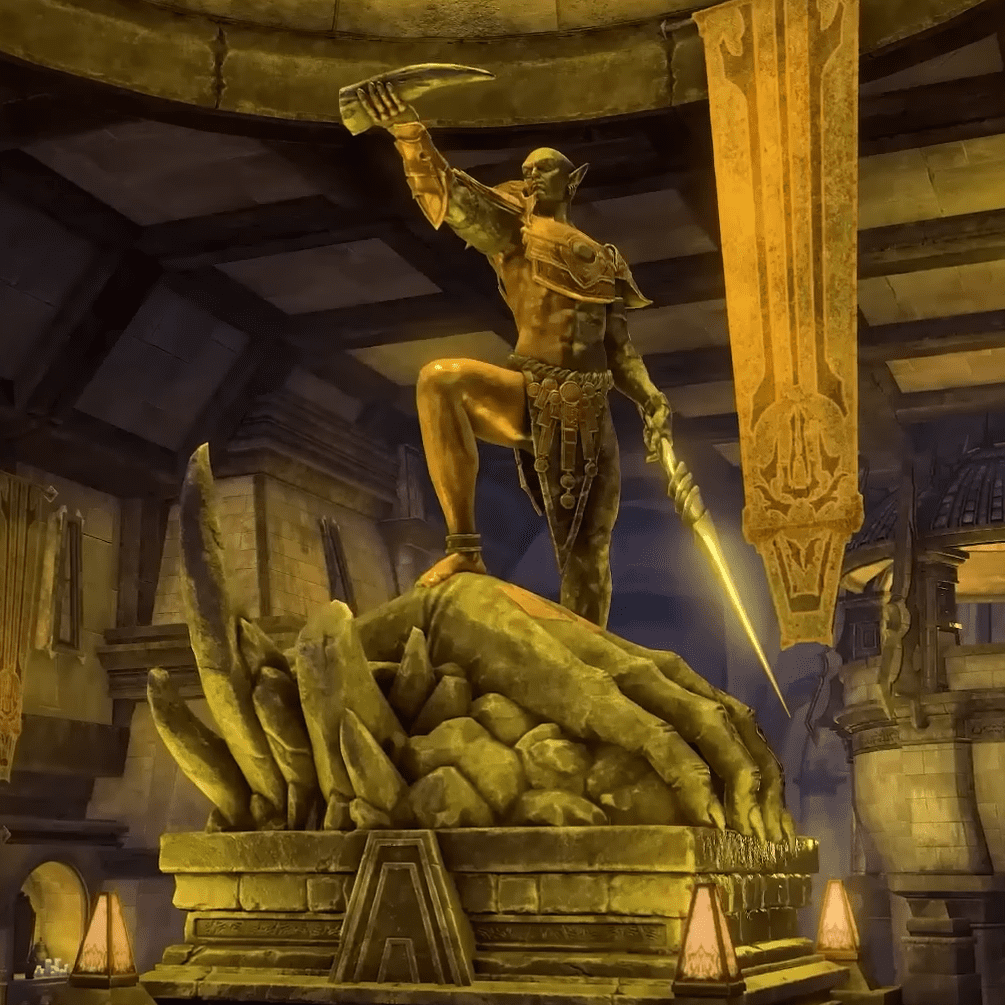 ESO ESO
|
Saints[edit]
Saint Delyn and Saint Olms[edit] | |||
 Saint Delyn, ESO Saint Delyn, ESO
|
 Saint Delyn, Morrowind Saint Delyn, Morrowind
|
 Saint Olms, ESO Saint Olms, ESO
|
 Saint Olms, Morrowind Saint Olms, Morrowind
|
|---|---|---|---|
|
Statues of the Dunmer saints, Delyn the Wise and Olms the Just, were built atop their respective cantons in Vivec City.[132] Saint Olms is remembered as the patron saint of Chandlers and Clerks, and Saint Delyn the Patron of Potters and Glassmakers.[138] | |||
Saint Felms and Saint Llothis[edit] | |||
 Saint Felms, ESO Saint Felms, ESO
|
 Saint Llothis, ESO Saint Llothis, ESO
| ||
|---|---|---|---|
|
Great statues of Saint Felms and Saint Llothis in their factotum forms were built in the Asylum Sanctorium of the Clockwork City. When the saints were close to death, Sotha Sil placed their souls into a modified black soul gem and installed them into giant factotum bodies to make them immortal.[139] Unfortunately, the process eventually drove them both to madness for varying reasons.[140][141] Their souls were eventually released from the factotum bodies in 2E 582.[142] | |||
Saint Kaladas[edit] | |
|
A statue of Saint Kaladas the Architect was built outside the Great Chapel of Zenithar in Leyawiin at some point before the mid-Second Era. Kaladas lived several centuries after the Alessian Slave Rebellion and is best remembered for building the Great Chapel in the sixth century of the First Era in tribute to the messenger who is said to have carried the Mace of the Crusader to Leyawiin following the death of Pelinal Whitestrake.[143][144] Saint Kaladas was laid to rest in the chapel undercroft and he was later canonized as an Imperial saint,[144][145] but his statue in Leyawiin was gone by the late-Third Era.[146] |
 ESO ESO
|
Saint Nerevar[edit] | |
|
A bust of Saint Nerevar, the Champion of Azura, was uncovered in the mid-Second Era by the Antiquarian Circle in Vvardenfell. This discovery was of particular note, given realistic (albeit conservative in this case) depictions of Dunmer religious figures were uncommon. Historians noted that the bust shared similarities to works from the Gwylim First Council collection and the Bruma School, circa 1E 2800, speculating that the sculptor may have had Imperial influences.[147] It is unknown if the sculptor conceptualized Nerevar with the golden skin of the Chimer or the ashen skin of the Dunmer, given that their portraiture leans toward monochromatic, abstract compositions. However some scholars believe the Dunmer were master revisionists and would have chosen the latter.[147] |
 ESO ESO
|
Saint Osla[edit] | |
|
A statue of Saint Osla was built at Fountain Gate in the city of Chorrol at some point after the late-Second Era.[148] The memorial, known as "The Touch of the Healers Hand", stands in memory to all who died at the Sack of Sancre Tor in 2E 852, where Tiber Septim fought against the Nords and Bretons at the fortress of Sancre Tor in Cyrodiil. The statue depicts St. Osla ministering the fallen during the battle.[149][150]:361 |
 Oblivion Oblivion
|
Saint Stental[edit] | |
 ESO ESO
|
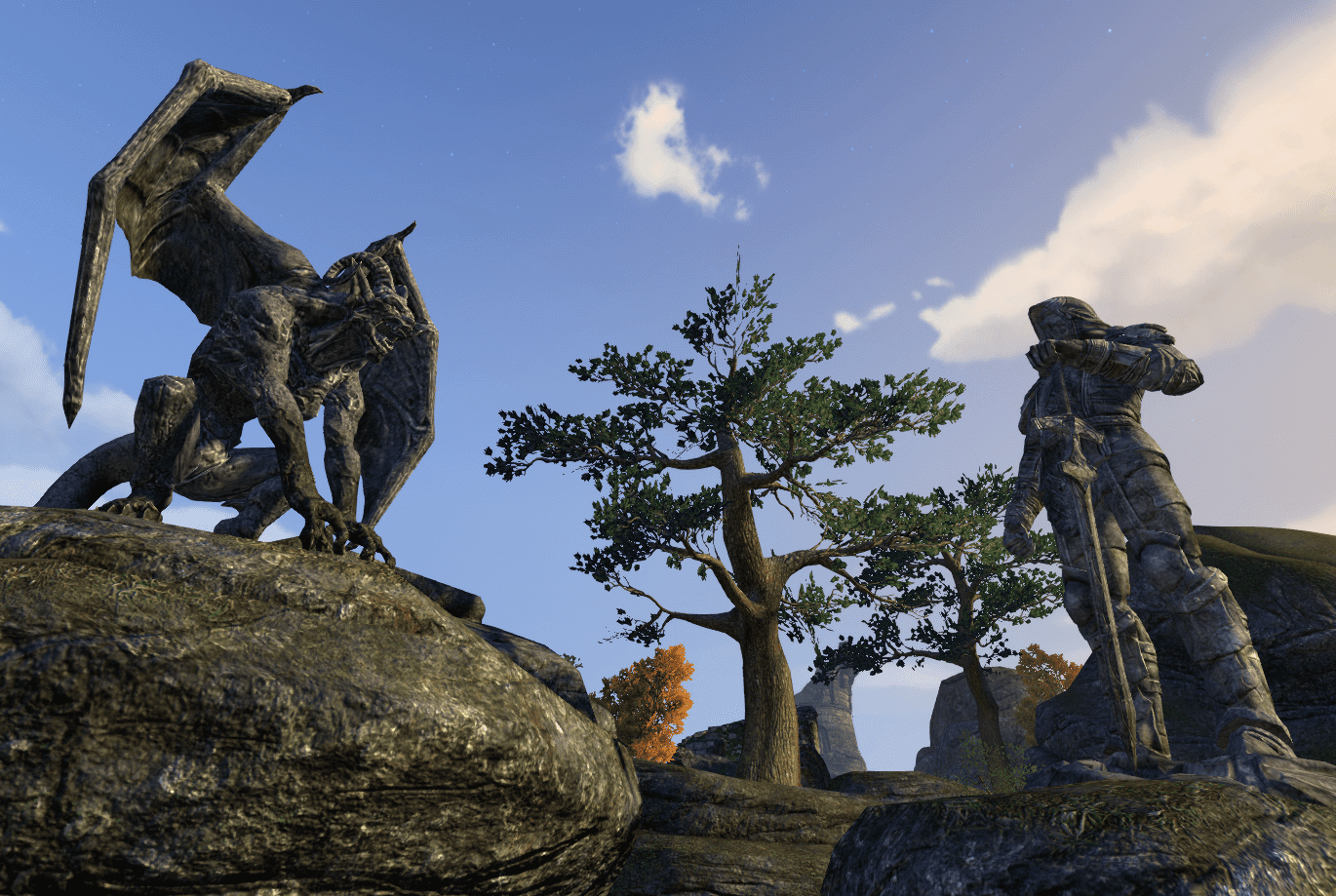 ESO ESO
|
|---|---|
| A memorial of Saint Stental was erected in Stormhaven in 2E 388. Named "The Saint Slays the Leaper", it was built to honor Stental's act of heroism when he slew the demon of Overlook Hill, rescuing the three Sisters of Kynareth from a terrible fate. It depicts two statues, one of Stental armed with a sword facing a crouched gargoyle.[151][152][nb 4] | |
Ansei Warriors[edit]
Ansei Majah, Radan and Halelah[edit] | |
 ESO ESO
|
 ESO ESO
|
|---|---|
|
Statues of the three ancient Redguard heroes, Ansei Majah, Radan, and Halelah, were built in the Impervious Vault in Sentinel. These statues were erected to hold three Ansei Wards - magical relics from the First Era that contained the spirits the three heroes. The Wards were created in ancient times to combat against the threat of necromancy in the Alik'r Desert.[153][154] During the mid-Second Era, the Withered Hand necromancers infiltrated the Impervious Vault and stole the Ansei Wards in order to raise undead army against King Fahara'jad.[154] With the aid of the Ash'abah the Wards were eventually recovered and placed back in the Ansei statues that previously held them.[155] |
Almost identical statues of the three Ansei heroes were erected in Tava's Blessing. They were sculpted by the artist Jamshald Lainlyn in 2E 102 to honor the esteemed Ansei and to commemorate the birthplace of Ansei Maja.[156] The town was briefly occupied by the Withered Hand when one of their leaders attempted to use the power of an Ansei Ward to become a lich, but his plan was stopped by the Ash'abah and Ansei Maja's spirit.[157] |
Ansei Satameh, Ra Hasar and Ra Huzar[edit] | ||
 Ansei Satameh, ESO Ansei Satameh, ESO
|
 Ra Hasar, ESO Ra Hasar, ESO
|
 Ra Huzar, ESO Ra Huzar, ESO
|
|---|---|---|
|
Statues of the "twins of sword and spear", Ra Hasa and Ra Huzar, and their mother, Ansei Satameh the "Tigress of Dragonstar", were built atop their honored tombs in the Valley of the Blade. During the Planemeld, Sai Sahan travelled to the sword-school to acquire the Ring of Stendarr's Mercy, but encountered Mannimarco and his Daedric minions. Mannimarco raised the bones of the ancient heroes in an attempt to stop Sai Sahan, but they were ultimately defeated.[158] | ||
Ansei Kalam and Ra Adia[edit] | |
 Ansei Kalam, ESO Ansei Kalam, ESO
|
 Ra Adia, ESO Ra Adia, ESO
|
|---|---|
|
Statues of Ansei Kalam, known as the "Master of Polearms", and his daughter Ra Adia, were built atop their honored tombs in the Valley of the Blade. During the Planemeld, Sai Sahan travelled to the sword-school to acquire the Ring of Stendarr's Mercy, but encountered Mannimarco and his Daedric minions. Mannimarco raised the bones of the ancient heroes in an attempt to stop Sai Sahan, but they were ultimately defeated.[158] | |
Divad Hunding[edit] | |
|
Divad Hunding was the famed son of the legendary sword-singer Frandar Hunding. He is noted for continuing Frandar's conquest of Hammerfell in the First Era. After his death, a statue of him was built atop his honored tomb in the Valley of the Blade, however, other evidence suggests he was buried in the sacred Hall of Heroes, alongside his father.[159] During the Planemeld, Sai Sahan travelled to the sword-school to acquire the Ring of Stendarr's Mercy, but encountered Mannimarco and his Daedric minions. Mannimarco raised the bones of the ancient hero in an attempt to stop Sai Sahan, but he was ultimately defeated.[158] |
 ESO ESO
|
Ra Abah[edit] | |
|
Ra Abah was a renowned Yokudan warrior who fought alongside Frandar Hunding in the War of the Singers against Emperor Hira.[32] After his death, a statue of him was built atop his honored tomb in the Valley of the Blade. During the Planemeld, Sai Sahan travelled to the sword-school to acquire the Ring of Stendarr's Mercy, but encountered Mannimarco and his Daedric minions. Mannimarco raised the bones of the ancient hero in an attempt to stop Sai Sahan, but he was ultimately defeated.[158] |
 ESO ESO
|
Aedra[edit]
Akatosh[edit] | |||||||
 ESO ESO
|
 ESO ESO
|
 ESO ESO
|
 ESO ESO
|
 Morrowind Morrowind
| |||
|---|---|---|---|---|---|---|---|
| The ancient Khajiit in the early-First Era depicted Alkosh as a Dragon, much like the later Imperial depictions of Akatosh. Sunspire temple, built on the land where Alkosh drove Pelinal Whitestrake from Elsweyr, featured reliefs of Alkosh breathing fire and holding an hourglass, or alongside imagery of moons, which the Khajiit hold sacred.[160] Small and extremely detailed dragon statues dating further back were also used in his worship.[161] | Deep in the ruins of Knightsgrave a terrifying statue of Akatosh dominates a large ancient cave. Believed to date back to around the early-First Era, it was built by the Alessian Order, possibly to further their efforts in raising Akatosh above all other gods.[69] | During the mid-Second Era, once the worship of Akatosh and the Divines had become firmly established, small statuettes of the Dragon God could be found in temples and cathedrals across human lands, alongside grander depictions such as in stained glass cathedral windows.[162] | By the late-Third Era Morrowind had come under the rule of the Empire, who often used Dragon-related imagery in its heraldry.[163] A vast statue of Akatosh stood in Dragon Square in the Dumner city of Ebonheart during this time.[164] | ||||
 Oblivion Oblivion
|
 Oblivion Oblivion
|
 Blades Blades
|
 Oblivion Oblivion
|
||||
| A large statue of Akatosh, wings outstretched, could be found at the center of the Talos Plaza District in the Imperial City during the late-Third Era.[165]:349
Other statuary around this time depict Akatosh as a figure with the head of a human and a dragon while holding an hourglass, alluding to his sphere of Time.[3] |
Mehrunes Dagon's invasion of Tamriel culminated at the Temple of the One in the Imperial City, where Martin Septim became the avatar of Akatosh. In the form of a dragon, Martin sacrificed himself to banish Dagon from Tamriel, and his remains solidified into a vast statue of Akatosh's dragon avatar. Ocato of Firsthold declared that the dragon would stand forever as a memorial to Martin's sacrifice.[166] | Around the Fourth Era, statuettes of Akatosh could be found in temples that depict him swallowing a sword, although the symbolism of act is unclear.[167] | |||||
Arkay[edit] | |||
 ESO ESO
|
 Daggerfall Daggerfall
|
 Oblivion Oblivion
|
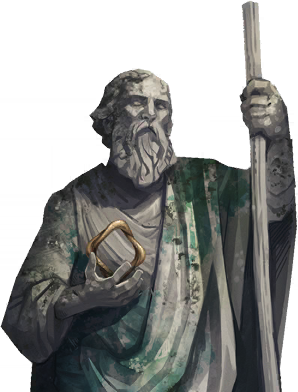 Blades Blades
|
|---|---|---|---|
|
Statuary of Arkay has remained relatively consistent throughout the eras. He is depicted as a robed, old man holding a staff in his left hand and an object in his right hand, but it's unclear if or how it relates to his sphere of burial rites and the cycle of life and death. Statues of Arkay could be found in various Breton and Imperial settlements during the Second Era and Third Eras, notably in Cheydinhal, where the Great Chapel of Arkay was built. Vast statues of Arkay could be found at the center of Breton burial grounds, such as Cath Bedraud in Glenumbra and Pelin Graveyard in Bangkorai. Arkay's faithful are also known to keep small statues of him in their homes, which they praise every morning in thanks for granting them another day.[168] | |||
Auri-El[edit] | |||
 ESO ESO
|
 Oblivion Oblivion
|
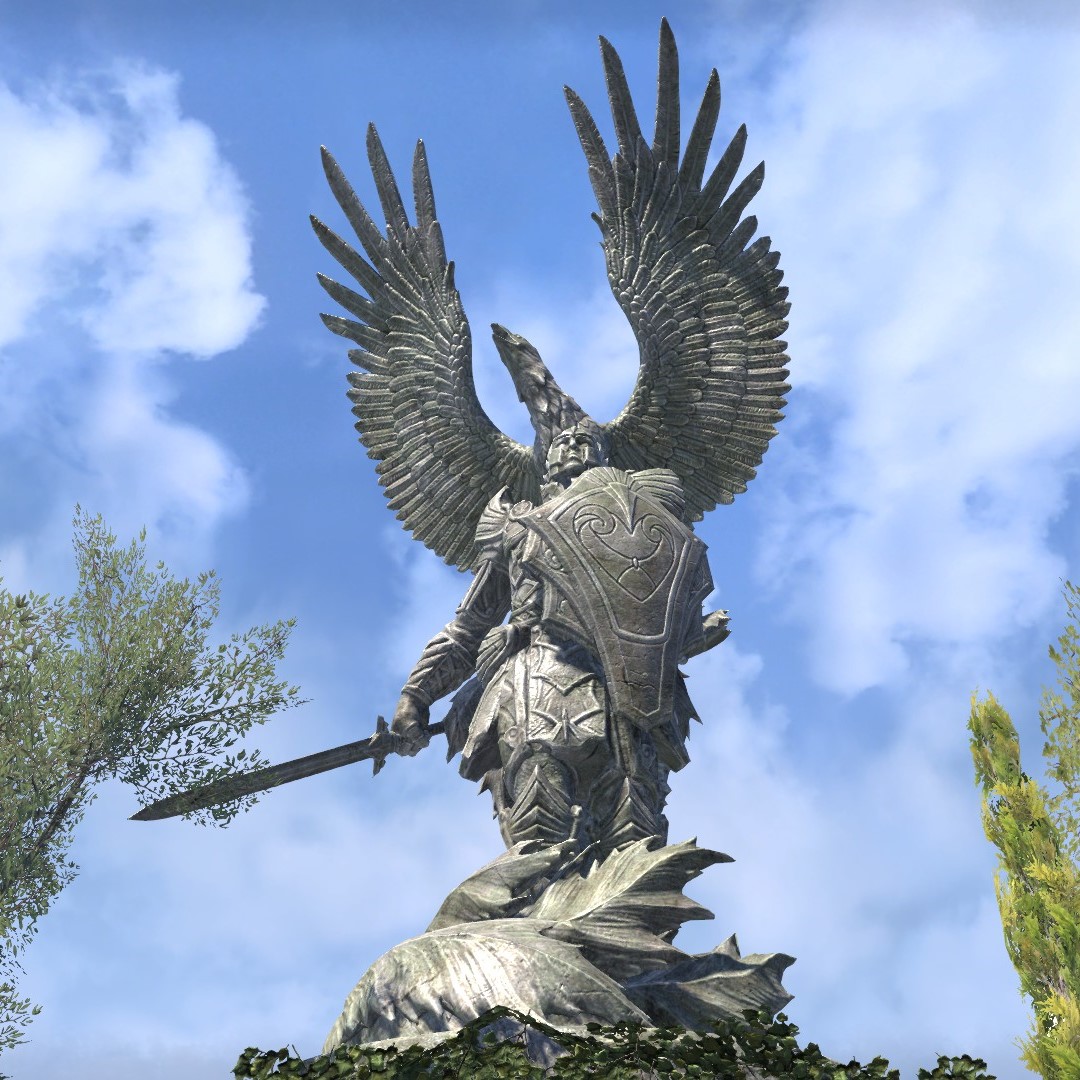 ESO ESO
|
 Skyrim Skyrim
|
|---|---|---|---|
| The chief Altmeri deity is depicted in a large statue found in the Monastery of Serene Harmony in Shimmerene. A crowned Auri-El stands back-to-back with Xarxes, while holding a sun-shaped sigil. | Although some Ayleids worshipped Daedra, statues of Auri-El could be in their cities across Cyrodiil. These statues depict Auri-El as a knight, holding either his bow, or a sword and shield. Behind him is a large eagle with its wings outstretched. The symbolism of this in the cultural context of the Ayleid is unclear, but it may share some parallels with Altmeri culture. For the Altmer, the high-soaring eagle represents their ancestors the Aedra, who they believe came from the heavens and were trapped in physical form by the creation of Nirn.[169] As such, other statuary or effigies related to Auri El heavily feature the eagle motif.[170][171][172] | Statuary from the ancient Snow Elves is exceedingly rare, but one surviving example found in the Chantry of Auri-El depicts their chief deity almost identical to Aldmeri statuary - A crowned figure holding holding aloft a sun-shaped sigil. | |
Dibella[edit] | ||||
 Skyrim Skyrim
|
 Skyrim Skyrim
| |||
|---|---|---|---|---|
|
In the totemic religion of Atmora, the precursor to the Nordic pantheon, Dibella was represented by the Silver Moth. During the Merethic Era, various depictions of the moth could be found in temples and tombs in honor of the Goddess of Beauty. [173][174] | ||||
 ESO ESO
|
 Daggerfall Daggerfall
|
 Oblivion Oblivion
|
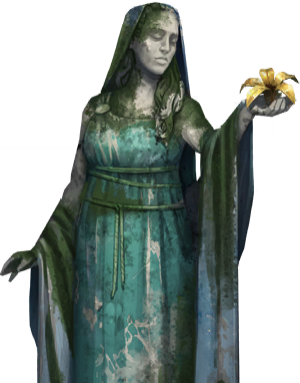 Blades Blades
|
 Skyrim Skyrim
|
|
In the early First Era, Alessia fused the Nordic pantheon with the Aldmeri pantheon to create the Eight Divines.[175][176] Over time, Dibella took on a more feminine form, and Nordic, Breton and Imperial statuary characterized Dibella in a similar manner - as a beautiful, scantily-clad woman. Sometimes she held a flower in her hands, which itself became a symbol for the Lady of Love.[177][178] Dibella also became associated with amorous activities and numerous types of statuary reflected this, including ceramic or alabaster statuettes that were kept in Nordic bedchambers to enhance nightly endeavors.[179][180][181][182] Other examples include carved soapstone idols of Dibella that were said to increase the holder's romantic appeal if regularly burnished.[183] | ||||
Jephre[edit] | |
|
According to Elven legends, Jephre the Singer walked among the early Elves and gave heed to the nature of the forests. He taught the birds to sing their songs, the streams their ethereal tune, and taught the Elven youth songs that led to the first great ballads. In later eras he became worshipped as the god of song and forest among the Altmer and shrines to Jephre, such as the one found in the Monastery of Serene Harmony on Summerset Isle, depicts a lyre to honor their ancestor.[184] |
 ESO ESO
|
Jhunal[edit] | |
 Skyrim Skyrim
|
 Skyrim Skyrim
|
|---|---|
|
Jhunal was represented by the Owl under the animalistic religion of Atmora.[185] During the Merethic Era the ancient Nords created various totemic depictions of the owl (or figures bearing owl-like imagery) in veneration of the rune god, which could be found in temples and tombs across Skyrim.[173][174] Jhunal eventually fell out of favor among Nords and became known as Julianos when the Nordic faith shifted towards the Divines.[186] | |
Julianos[edit] | ||
 Daggerfall Daggerfall
|
 Oblivion Oblivion
|
 Blades Blades
|
|---|---|---|
|
Statuary of Julianos has remained relatively consistent throughout the eras. He is depicted as a robed, old man holding a pyramid-shaped object in his right hand, but it's unclear if or how it relates to his sphere of scholarship, logic and justice. Statues of Julianos could be found in various Breton and Imperial settlements during the Third Era, notably in the Arboretum District of the Imperial City.[3] In the Illiac Bay, his temples were referred to as schools and operated more like learning institutions, whereas more traditional places of worship (such as the Great Chapel of Julianos in Skingrad) were more common in Cyrodiil.[187] | ||
Kyne[edit] | |||
 Skyrim Skyrim
|
 ESO ESO
|
 ESO ESO
| |
|---|---|---|---|
|
Kyne was represented by the hawk under the animalistic religion of Atmora. During the Merethic Era the ancient Nords created various totemic depictions of the hawk (or figures bearing hawk-like imagery) in veneration of the Goddess of Storm, many of which could be found in temples and tombs across Skyrim.[173][174][nb 5] Although the worship of Kyne eventually fell out of favor among Nords, and she became known as Kynareth when the Nordic faith shifted towards the Divines, imagery of the hawk remained culturally relevant in the following eras and could be seen in their art, architecture, and armor.[188][186] This included depictions of Kyne found in snow-white wood carvings engraved with whorls and jagged lines.[189] | |||
Kynareth[edit] | ||||
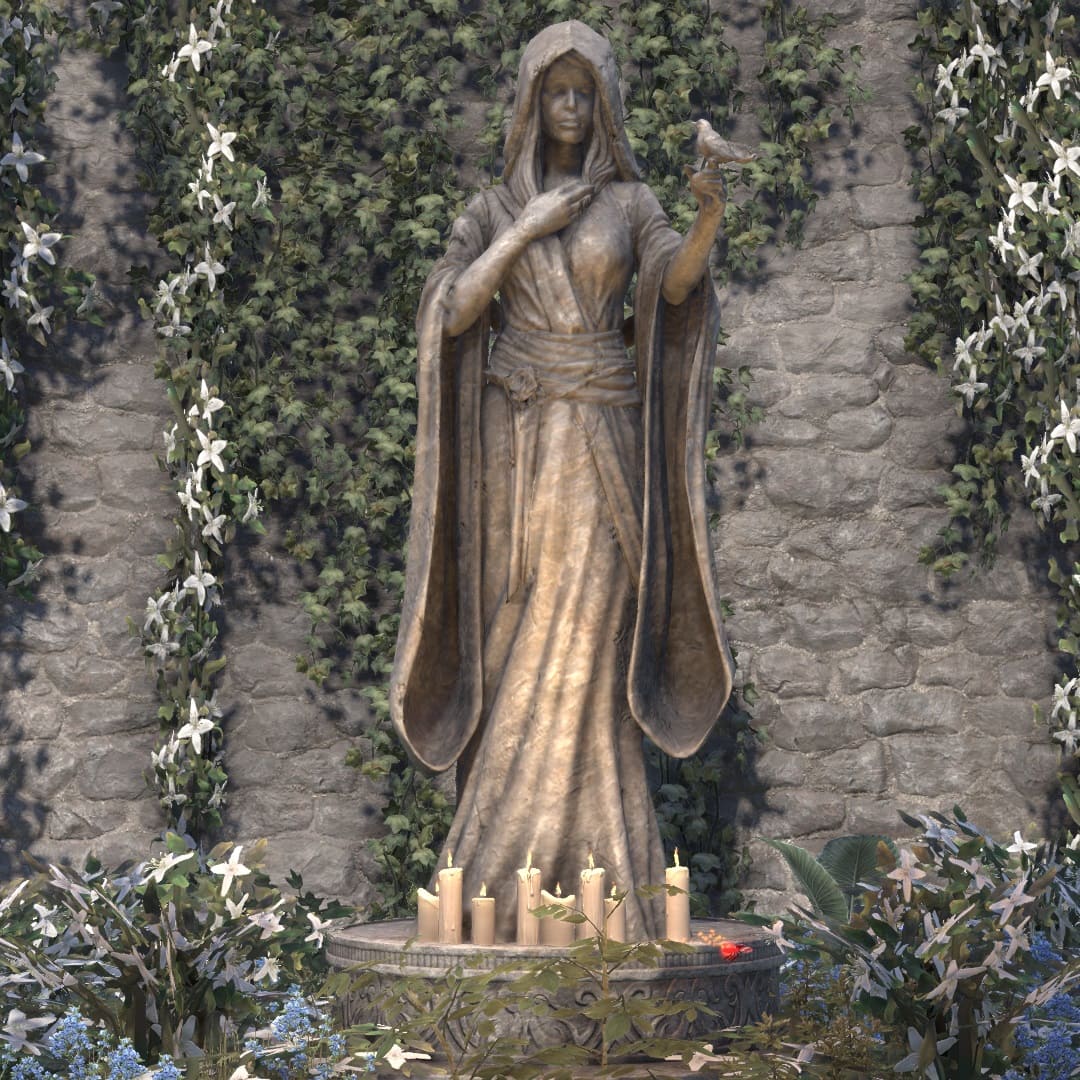 ESO ESO
|
 ESO ESO
|
 Daggerfall Daggerfall
|
 Oblivion Oblivion
|
 Blades Blades
|
|---|---|---|---|---|
|
Worship of Kynareth became prevalent after Alessia fused the Nordic pantheon with the Aldmeri pantheon to create the Eight Divines in the early First Era.[186][175] As such, Kyne became known as Kynareth, and the hawk-like imagery of Kyne became less apparent among Nords. Statuary representing Kynareth characterized her as a young woman in robes, sometimes holding a small bird[190] or a ship[191] - particularly in Imperial and Breton cultures. In the Systres, she was commonly depicted as a small bird wearing a crown.[192] Over time, Kynareth became associated with the sea, the elements, and the unseen spirits of the air.[193] | ||||
Magnus[edit] | |
|
An Altmeri shrine to Magnus, god of Magic, was found in the Monastery of Serene Harmony on Summerset Isle. Here Magnus is represented by an ornate astrolabe, however other times he is represented as a telescope or more commonly, a staff.[186] Cults of Magnus were known to create wicker effigies that they would use as a stand-in for the owner in certain rituals.[194] |
 ESO ESO
|
Mara[edit] | ||||
 Skyrim Skyrim
|
 Skyrim Skyrim
| |||
|---|---|---|---|---|
|
Mara was represented by the wolf under the animalistic religion of Atmora. During the Merethic Era the ancient Nords created various totemic depictions of the wolf (or figures bearing wolf-like imagery) in veneration of Kyne's handmaiden, which could be found in temples and tombs across Skyrim.[173][nb 6] This included depictions of Mara in stone and wooden carvings as a naked woman partially clothed in wolf pelts, bearing her own fangs.[195] Known to the Nords as Mother Wolf, Mara represented prosperity, fertility and blessed their sacred flora.[196][174][186] | ||||
 Daggerfall Daggerfall
|
 Oblivion Oblivion
|
 Blades Blades
|
 Skyrim Skyrim
|
|
|
After Alessia fused the Nordic pantheon with the Aldmeri pantheon to create the Eight Divines, Mara took on a more feminine form as reflected by Nordic and Imperial statuary, which characterised her as a robed mother holding a knotted rope. Mara also became associated with marriage, and wedding ceremonies would typically take place in her temples in Nordic lands.[197] Mara's cross, typically found on her shrines and altars, also depict the Goddess of Love and is strongly associated with bonding, love and intimacy.[198][199] Numerous types of statuary, such as flower-spouting fertility statuettes, reflected her role as the Mother-Goddess.[200] Mara was known to the Redguards as Morwha, an ancient Yokudan fertility goddess. Although Morwha and Mara are used interchangeably among the Forebears, their statuary varies as Morwha is always depicted with four arms so that she may "grab more husbands".[201] | ||||
Morwha[edit] | |
 ESO ESO
|
 Redguard Redguard
|
|---|---|
|
A large alabaster statue of Morwha enshrined and flanked by winged guardians was uncovered in the mid-Second Era by the Antiquarian Circle in Hew's Bane. Typical of Morwha statuary, she is portrayed as four-armed so that she can "grab more husbands", according to Yokudan mythology.[186] The alabaster material that the statue was built from was not typical for Yokudan statuary, leading scholars to speculate that the stone was acquired during the early days of the Ra Gada and their conquest of the Lefthanded Elves.[202] |
Another four-armed statue of Morwha was built of the island of Stros M'kai near Saintsport, although this depiction was highly stylized compared to traditional statuary. |
Orkey[edit] | ||
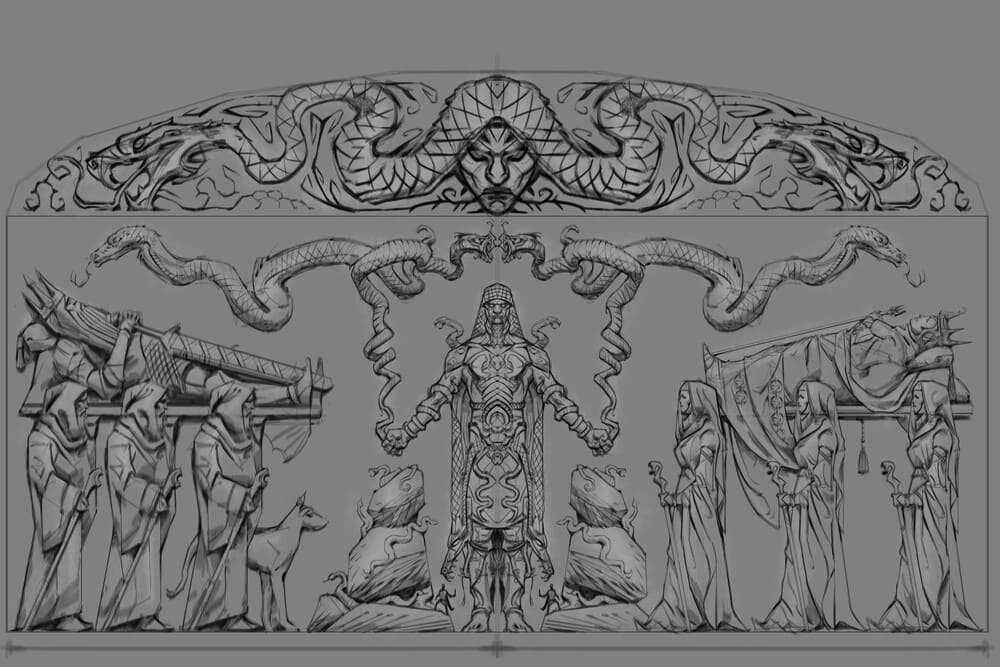 Skyrim Skyrim
|
 Skyrim Skyrim
|
 ESO ESO
|
|---|---|---|
|
Orkey was represented by the snake under the animalistic religion of Atmora. During the Merethic Era the ancient Nords created various totemic depictions of the snake (or figures bearing snake-like imagery) in veneration of the god of mortality, many of which could be found in tombs across Skyrim.[174] Considered a "testing god" by the Nords, Orkey was said to have been worshipped in ancient times, but this eventually waned, especially after the Nordic faith shifted towards the Divines in the early-First Era.[173] Instead, the Nords guard against Orkey in order to protect the hearth, and try to keep him appeased by keeping small statues in their homes that depict him.[203][204] According to some scholars, Orkey was fused with aspects of the Elven deity Xarxes and became known as Arkay thereafter.[205] Others suggest Orkey combines aspects of Mauloch and Arkay.[204] Regardless, iconography of the snake representing Orkey ceased among Nords, however priests of Orkey continued to exist in Skyrim up until at least the Second Era where they performed their sacred duty to the Divines in Halls of the Dead.[206] Although the snake was no longer relevant to Nordic religious imagery, the ancient Argonians heavily associated it with Sithis and it was reflected in much of their statuary. | ||
Phynaster[edit] | |
|
An Altmeri shrine to Phynaster, hero-god of the Summerset Isles was found in the Monastery of Serene Harmony on Summerset Isle. According to legend, he taught the Altmer how to naturally live another hundred years by using a shorter walking stride. To represent this feat, Phynaster's shrine depicts a decorative golden boot.[186] |
 ESO ESO
|
Satakal[edit] | ||
|
A Na-Totambu ceremonial gong depicting Satakal was uncovered in the mid-Second Era by the Antiquarian Circle in the Alik'r Desert. The frame was fashioned to resemble their snake-deity devouring itself in a never-ending cycle of rebirth, according to Yokudan myth.[207] |
 ESO ESO
| |
Shor[edit] | ||
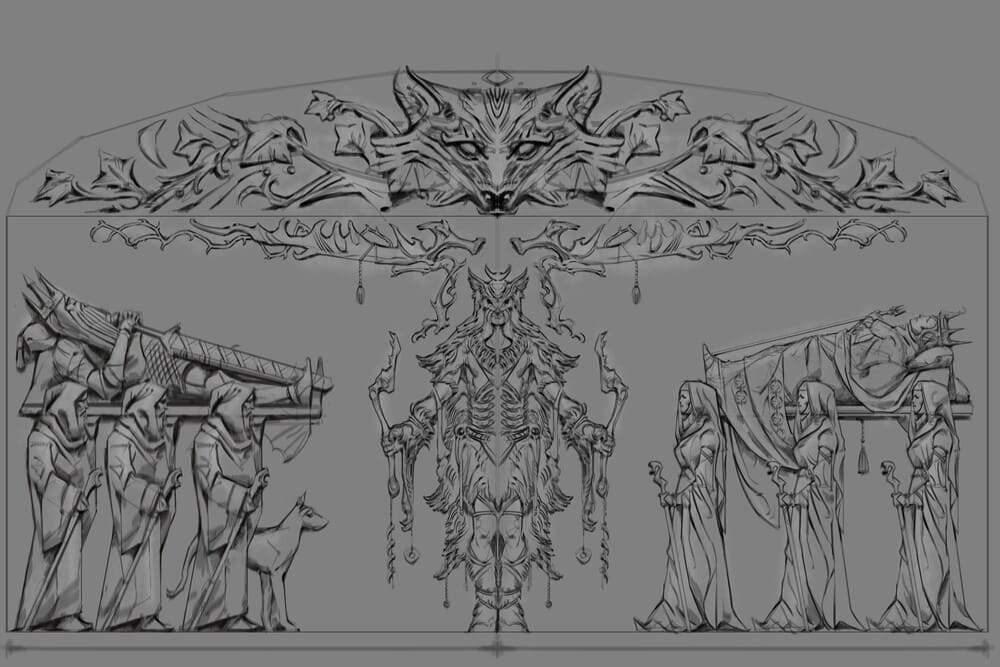 Skyrim Skyrim
|
 Skyrim Skyrim
|
 ESO ESO
|
|---|---|---|
|
Shor was represented by the fox under the animalistic religion of Atmora. During the Merethic Era the ancient Nords created various totemic depictions of the fox (or figures bearing fox-like imagery) in honor of the God of the Underworld, many of which could be found in tombs across Skyrim.[173][174] Considered to be a "dead god" who fought and died to bring about the current world, Shor was not actively worshiped compared to other Aedra in the Nordic pantheon.[204] As such, almost no direct iconography of Shor exists, although some sects, such as the Ternion Monks, still revere the fox.[208] The fox is also mentioned in Nordic folktales, such as when Ysgramor was saved from Herma Mora by Shor in the form of a fox.[209] |
An elegant Ebony Fox Totem was uncovered in the mid-Second Era by the Antiquarian Circle in Skyrim. This discovery was of particular note, given Atmoran totemic art typically featured harder edges and more abstract shapes. Historians speculated that this sculpture was possibly a result of cultural crossover with the Snow Elves, and that Ysgramor's heirs may have gone to great lengths to destroy elven-inspired items such as this.[210] | |
Stendarr[edit] | ||||
 ESO ESO
|
 Daggerfall Daggerfall
|
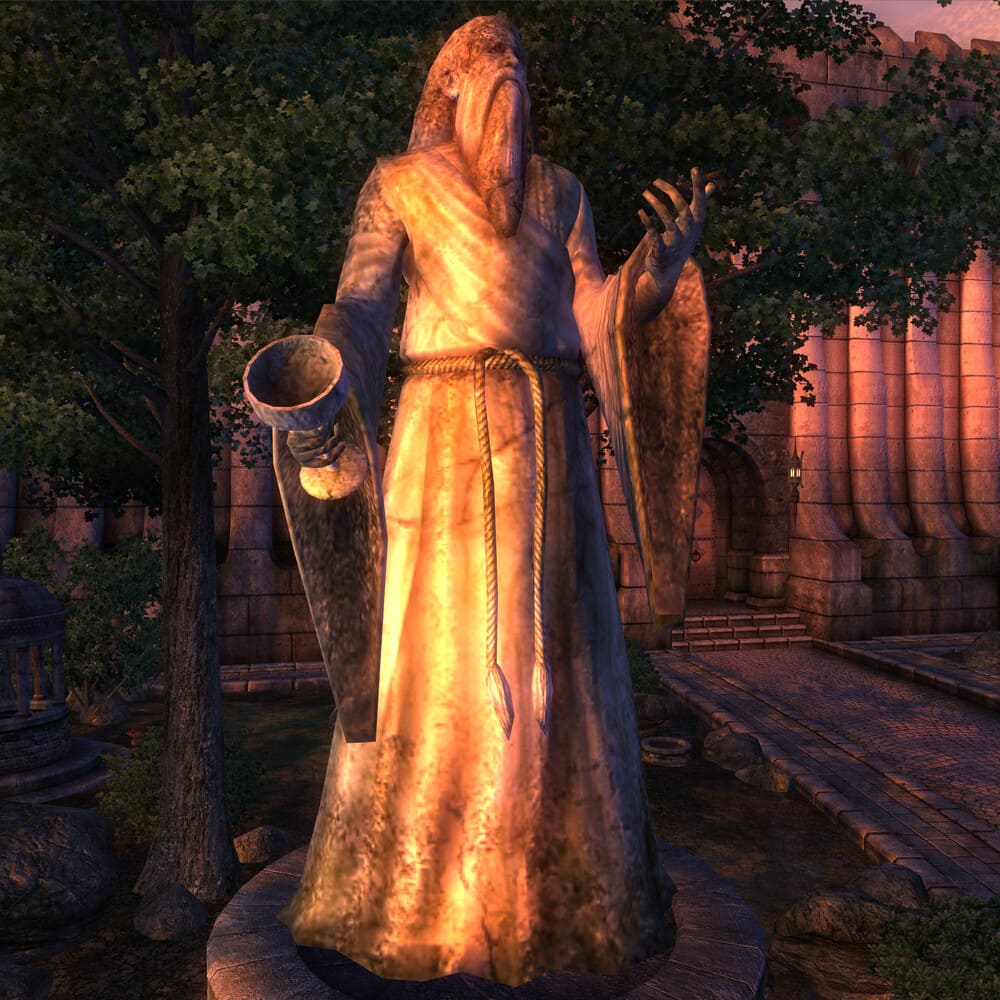 Oblivion Oblivion
|
 Blades Blades
|
|
|---|---|---|---|---|
|
Statuary of Stendarr has remained relatively consistent throughout the eras after his worship became established under the religion of the Divines. Prior to this, Stendarr was known in the Nordic religion as Stuhn and was associated with iconography related to the whale. Under the pantheon of the Divines, Stendarr is typically depicted as a robed, old man pouring liquid from a chalice, possibly to symbolize his sphere of charity, compassion and mercy. Shrines of Stendarr are somewhat simplified and depict only the flowing chalice or horn.[211][nb 7] Statues of Stendarr could be found in various Imperial and Breton settlements during the Second and Third Era, notably in the Arboretum District of the Imperial City and the Temple of the Winds on High Isle.[3][212] In the Illiac Bay, his temples were considered the greatest charitable institutions in the land, whereas more traditional places of worship (such as the Great Chapel of Stendarr in Chorrol) were more common in Cyrodiil.[213] | ||||
Stuhn[edit] | ||
 Skyrim Skyrim
|
 ESO ESO
|
 ESO ESO
|
|---|---|---|
|
Stuhn was represented by the whale under the animalistic religion of Atmora. During the Merethic Era the ancient Nords created various totemic depictions of the whale (or figures bearing whale-like imagery) in honor of the God of Ransom, many of which could be found in temples and tombs across Skyrim.[173][174] The worship of Stuhn eventually fell out of favor among Nords, and he became known as Stendarr when the Nordic faith shifted towards the Divines.[186] |
An opal Carved Whale Totem was uncovered in the mid-Second Era by the Antiquarian Circle in Skyrim. This discovery was of particular note, given it appeared less devotional than other Stuhn-precursor carvings. Some historians speculated that this sculpture was instead possibly a depiction of the fabled flying whales that live among the clouds in Skyrim.[214] | |
Syrabane[edit] | |
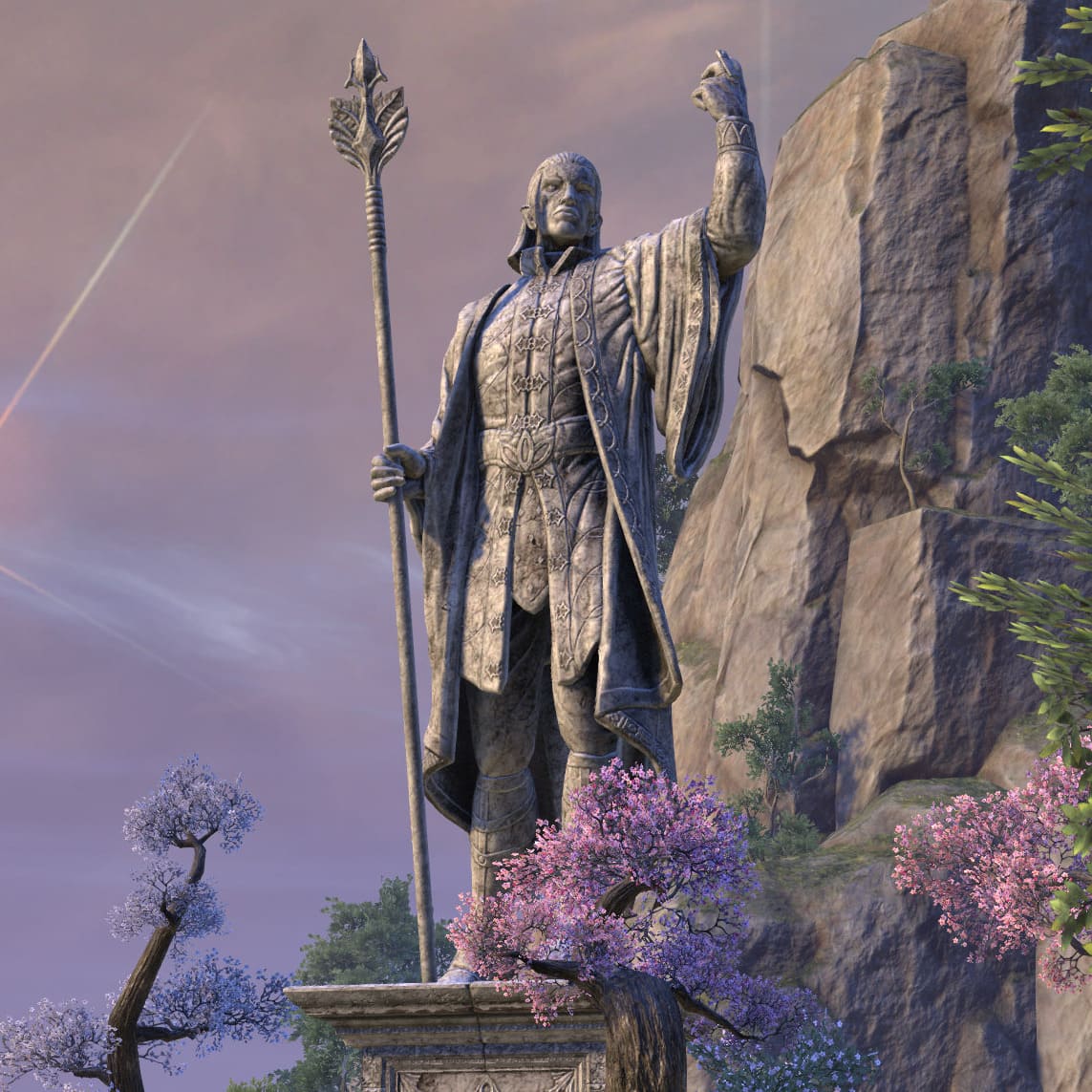 ESO ESO
|
 ESO ESO
|
|---|---|
|
Syrabane became revered as a god as Altmeri society developed.[215] As such, a grand statue of him stands on the coastal cliffs of Artaeum, which he supposedly posed for in-person.[216] |
It is unclear whether Bretons of the Systres Archpelago venerate Syrabane as a deity or as a prominent historical figure, given he aided Bendu Olo in his war against the Sload,[186] but statues and numerous figurines of the Warlock's God were found on the archipelago during the mid-Second Era.[217][218] This included a crystal likeness of the Warlock's God, carried by Syrabane's faithful that was said to ward off curses and disease.[219] |
Tava[edit] | |
|
An enormous rock carving of a bird's head, known as Tava's Beak, was found on the southern coast of Hew's Bane during the mid-Second Era. According to Redguard theology, Tava is known as the bird god,[186] and the goshawk and redtail hawk are considered to be sacred to her.[220][221] |
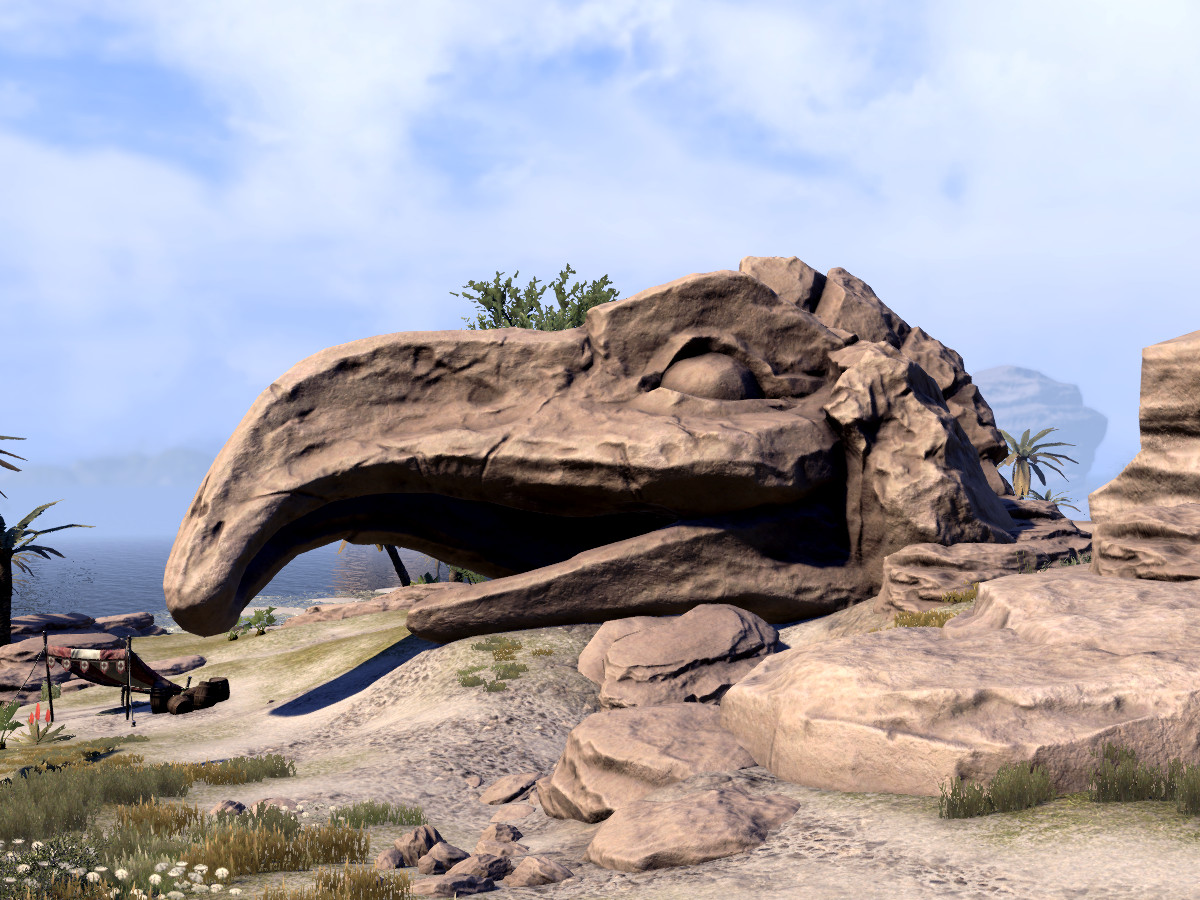 ESO ESO
|
Tiber Septim / Talos[edit] | ||
 Oblivion Oblivion
|
 Blades Blades
|
 Skyrim Skyrim
|
|---|---|---|
|
During the late-Third Era and Fourth Era, statues of Tiber Septim could be found in parts of Cyrodiil, such as the city of Bruma or temples of Talos, where he is depicted wearing a cape and holding a sword.[222]:357[223] In the aftermath of Great War, the controversial White-Gold Concordat was signed which saw the complete ban of all worship of Talos.[224] As such, his statues, shrines and temples were removed, although some parts of Skyrim that opposed the ban openly defied this.[225][226] |
Around the same time in Skyrim, Talos was historically revered as a Nord who possessed unmatched tactical skill, limitless wisdom, and the power to see into men's hearts.[227] As such, statues and shrines of Talos were relatively common throughout the land, despite the White-Gold Concordat, and could be seen in major cities such as Whiterun, Windhelm and Markarth. These versions depict Talos in full chainmail armor and a winged helm as he is about to impale a serpent through the mouth with his sword. Although the symbology of this is unclear, it bears striking similarities to shrines of Akatosh, where the Dragon-God appears to be swallowing a sword. | |
Trinimac[edit] | ||
 ESO ESO
|
 ESO ESO
|
 ESO ESO
|
|---|---|---|
|
A statue of Trinimac was erected in the rebuilt Temple of Ire in Orsinium after King Kurog reinstated the worship of the deity during the Second Era.[228] The statue depicts Trinimac in full armor and holding aloft his legendary blade, the Penitent. During this time the Vosh Rakh cult attempted to forcibly convert the Wrothgarian Orcs towards the worship of Trinimac and abandon Malacath.[229] Despite this, there was fierce debate in Orsinium as to which deity the temple should be dedicated to.[230] Other examples of Orcish depictions of Trinimac include gilded statuettes that serve as paperweights.[231] |
During the early-First Era when the worship of Malacath was ubiquitous in Orsinium, some Orcs were intent on worshiping Trinimac, even if meant in the privacy of their own homes. These Orcs fashioned small, gold-cast idols of stylized animals, including bears, pigs, goats, and even horkers. Despite not being direct depictions of Trinimac, these idols bore his mark and were placed inside homes to provide protection, comfort, and a focal point for private worship. The area around Paragon's Remembrance in Wrothgar, an ancient site devoted to the veneration of Trinimac, has long been a source of these tiny statues.[232] |
An Altmeri shrine to Trinimac, warrior-god of the Elves, was found in the Monastery of Serene Harmony on Summerset Isle. Trinimac's shrine depicts his holy sword, the Penitent.[233] According to Altmeri legend, he led Elven armies against the Men before he vanished from the mythic stage.[186] Other Altmeri depictions of Trinimac are made of bronze or rose quartz, and include statuettes and figurines of the deity kneeling with his sword raised defiantly into the air.[234][235] |
Tsun[edit] | |
 Skyrim Skyrim
|
 Skyrim Skyrim
|
|---|---|
|
Tsun was represented by the bear under the animalistic religion of Atmora.[236] During the Merethic Era the ancient Nords created various totemic depictions of the bear (or figures bearing bear-like imagery) in veneration of the deity, which could be found in temples and tombs across Skyrim.[173] Considered to be a "dead god" who fought and died defending Shor, the worship of Tsun was never as prevalent as the other Aedra in the Nordic pantheon.[173][174][186] As such, almost no direct iconography of Tsun exists, although some sects, such as the Ternion Monks, still revere the bear.[208] | |
Tu'whacca[edit] | |
 ESO ESO
|
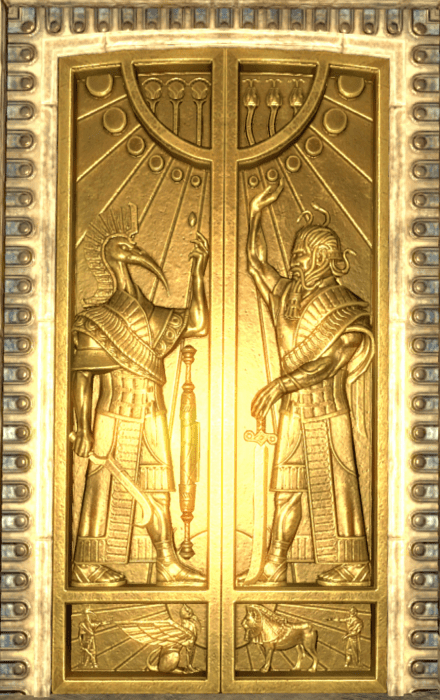 ESO ESO
|
|---|---|
|
In Yokudan theology, the ibis is considered sacred and oft associated with Tu'whacca, the God of Souls. His purpose is the caretaker of the Far Shores, and Redguards believe he helps their souls find their way into the afterlife.[237] His veneration is best illustrated in tombs and burial places, where Tu'whacca is represented in statuary and reliefs as a figure with the head of an ibis and the body of a man. These resting places are also sometimes replete with numerous funerary statues that depict a winged ibis-lion creature, such as the Al-Danobia tomb in Hammerfell. In other reliefs, Tu'whacca can be seen facing Satakal, both with their hands raised.[238] | |
Z'en[edit] | |
|
A idol of Z'en, the God of Agriculture, was uncovered in the mid-Second Era by the Antiquarian Circle in Blackwood. Although Z'en is more commonly associated with the Bosmer as a vengeful god, this discovery was of particular note because it was believed to be Kothringi in origin, given its curvilinear design elements and its focal shape depicting a spade. Indeed, some scholars speculate the Bosmer were introduced to the deity by Kothringi sailors before the race's extinction. Scholars suggest further that the Kothringi viewed Z'en sphere to include equitable trade, basic fairness, and so on - to the extent that their reverence for him played a role in shaping their values of decency and forthrightness.[239][186] |
 ESO ESO
|
Zenithar[edit] | ||||
 ESO ESO
|
 ESO ESO
|
 Daggerfall Daggerfall
|
 Oblivion Oblivion
|
 Blades Blades
|
|---|---|---|---|---|
|
Statuary of Zenithar has remained relatively consistent throughout the eras after his worship became established under the religion of the Divines. Zenithar is typically depicted as a robed, old man holding an anvil to symbolize his sphere of labor, wealth and commerce. Shrines of Stendarr are somewhat simplified and depict only the anvil itself.[240] Worshippers of Zenithar often keep small devotional anvils in their homes.[241] Statues of Zenithar could be found in various Imperial and Breton settlements during the Second and Third Era, notably in the Arboretum District of the Imperial City and the Great Chapel of Zenithar in Leyawiin.[3][212] The Trader God is also associated with the Bosmeri god Z'en, however Zenithar is considered a more cultivated god of merchants and middle nobility.[186] | ||||
Xarxes[edit] | |
|
Xarxes is depicted in a large statue found in the Monastery of Serene Harmony in Shimmerene. The god of ancestry and secret knowledge served as scribe to Auri-El and has kept track of all Aldmeri accomplishments, thus he stands back-to-back with Auri-El's statue while holding a book emblazoned with a sun-shaped sigil.[212] |
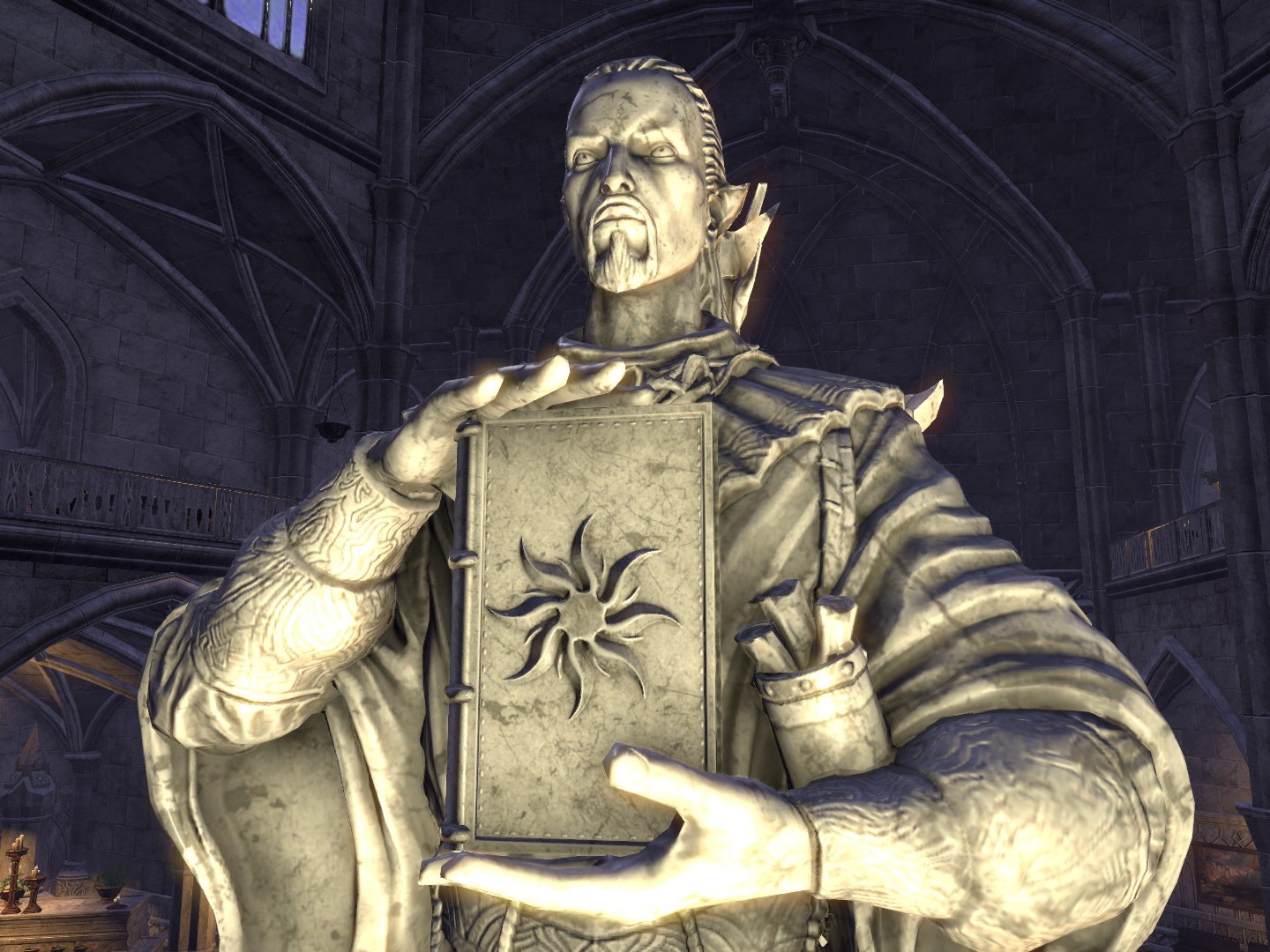 ESO ESO
|
Daedric Princes[edit]
Azura[edit] | ||||||
 ESO ESO
|
 ESO ESO
|
 Morrowind Morrowind
| ||||
|---|---|---|---|---|---|---|
|
A large gate of Azurah could be found in the Khajiiti temple of Ashen Scar in Elsweyr. It depicts the deity in her Khajiit, human and elven forms.[242] This type of relief was also featured on carved wooden blocks that could be found around the mid-Second Era.[243] |
A statue of Azura was erected on the south-eastern tip of Vvardenfell along Azura's Coast. It depicts Queen of Dawn and Dusk as a woman holding aloft a crescent moon in one hand and a star in the other. Inside the shrine a smaller statue of Azura could be found. Prior to the worship of the Tribunal in the First Era, the Chimer venerated Daedric Princes. As such, numerous statues and shrines were built across the land, although many of them fell into ruin. Azura's Shrine on the coast was one of the few that remained intact.[244] On occasion, Azura would communicate through the statue to speak to mortals and give them instructions.[245] | |||||
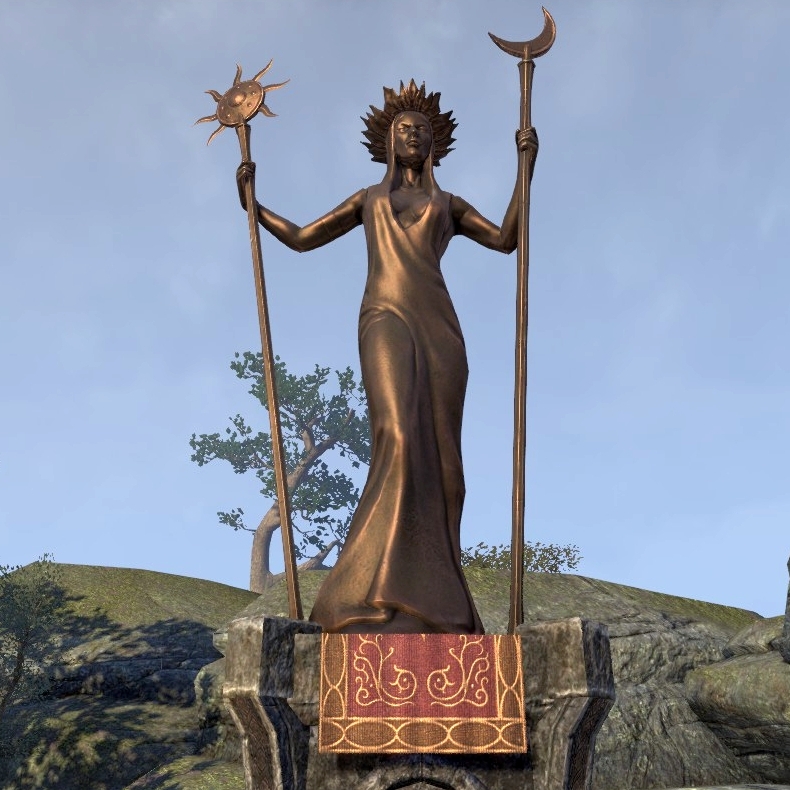 ESO ESO
|
 Oblivion Oblivion
|
 Skyrim Skyrim
| ||||
|
The Spirit Wardens of Stormhaven were a group of Azura worshippers who built various statues of her, most notably in their abbey. The Wardens were founded by Abbot Durak, who was following Azura's instructions to found an order of worshippers and prepare for the time when Vaermina would strike the people of Stormhaven with a plague of nightmares.[246] The statue depicts Azura in a manner similar to Chimeri statuary found in Morrowind - as a woman holding two staves tipped with a crescent moon and a star.[247] On occasion, Azura would communicate through the statue to speak to mortals and give then instructions.[248] The monks at Pariah Abbey also made valuable Azurite figurines in her honor.[249] |
A statue of Azura could be found in the wilds of Cyrodiil during the late-Third Era. Located in the foothills of the Jerall Mountains, the statue depicts Azura in a similar manner as other statues and also served as a shrine for a small coven.[250] This shrine also allowed individuals to solicit the Daedra lord directly, provided they possessed sufficient prowess or strength of character, and provided a proper offering.[251][252] Although Daedra worship was not prohibited by law in Cyrodiil, public opinion was strongly against it to the extent that it was forced to be practiced in secret. This particular coven of Azura worshippers was known to some of the populace and were seen as relatively benign when compared to other Daedric cults.[253][254][251] |
An enormous statue of Azura was built in the mountains of Skyrim during the early-Fourth Era. The statue was erected by Dunmer migrants who fled Morrowind before the catastrophic Red Year took place. According to Azura's faithful, they were given a vision that led them away from Vvardenfell before the disaster. As a way of thanking Azura, her followers built a shrine dedicated to her near the peaks of Mount Anthor. Years later, Dunmer refugees were granted permission to settle in Skyrim after fleeing the aftermath of the Red Year.[255] Around 200 years later, all but one of Azura's followers abandoned the shrine, supposedly afraid to know their own future.[256] | ||||
Azura and the Cavern of the Incarnate[edit] | |
 ESO ESO
|
 Morrowind Morrowind
|
|---|---|
|
A large statue and shrine of Azura was erected in the Cavern of the Incarnate, the sacred resting site of Failed Incarnates located in the northern ashlands of Vvardenfell. Unlike other statuary, she is depicted sitting with her hands cupped.[257] Cavern of the Incarnate was notable as it was where Urshilaku wise women would commune directly with Azura through the shrine, particularly when they were required to render judgment on the claims of the numerous failed Neravarines over history.[258][259] | |
Boethia[edit] | ||||||
 ESO ESO
|
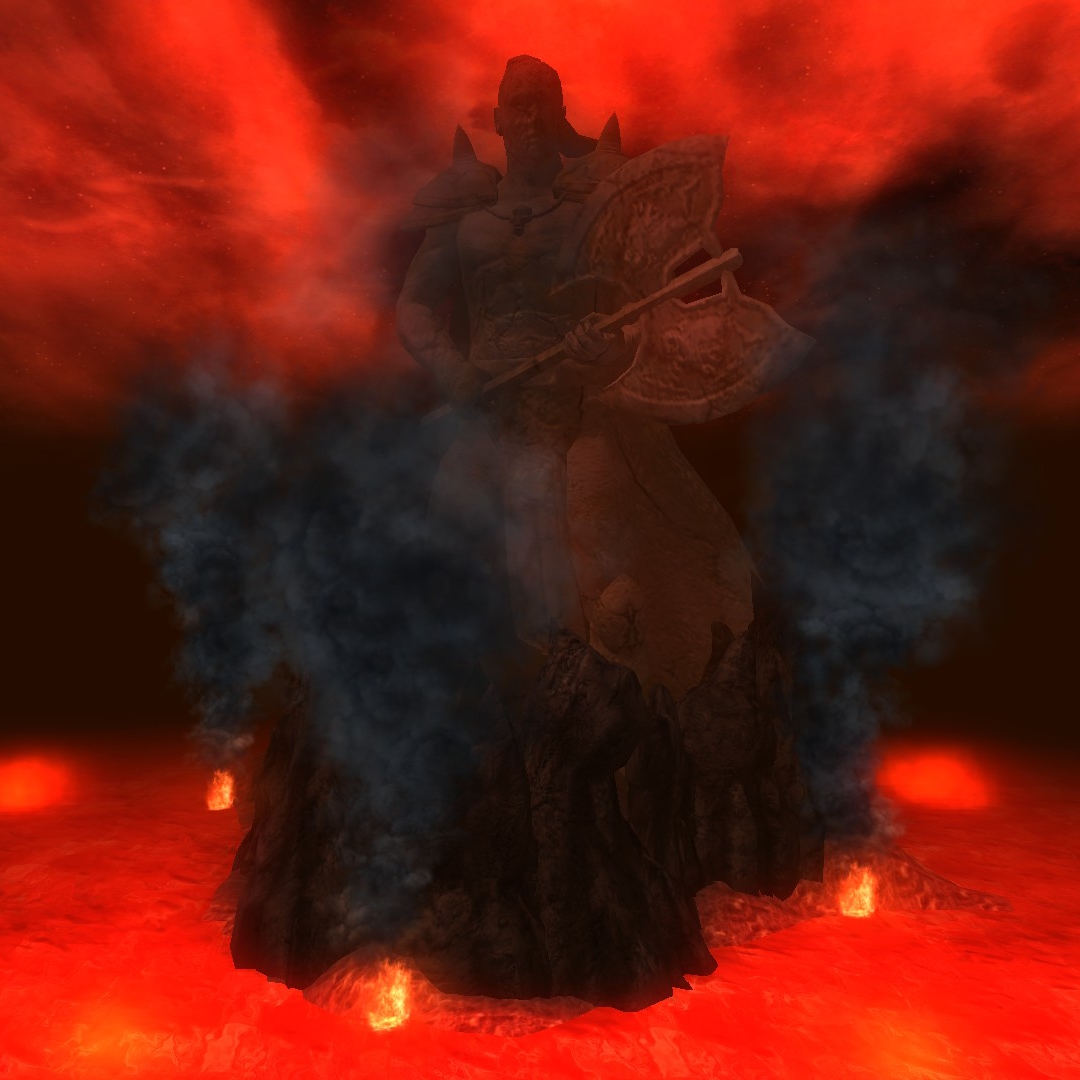 Oblivion Oblivion
|
 ESO ESO
|
 ESO ESO
| |||
|---|---|---|---|---|---|---|
|
Vast statues of Boethia could be seen in Attribution's Share, her realm of Oblivion. These statues were built in an arena where Boethia held the Tournament of Ten Bloods, so that mortals can earn her favor.[260] The ancient Nordic ruins near the city of Dragonstar was repurposed by followers of Boethia into Dragonstar Arena, and similar statues of her were built overlooking the combatants in various sections. The rough-hewn statues depict Boethia as either male or female while wielding a weapon.[261] |
A statue of Boethra, the Khajiiti variant of Boethiah, was uncovered in the mid-Second Era by the Antiquarian Circle in Elsweyr. The statue is believed to date back before the reunification of Elsweyr under the Elsweyr Confederacy and the emergence of the Riddle'Thar cult, during which various spirits and Daedra were venerated. Ancient Khajiit honored Boethra as a patron of warriors and rebellious exiles, and her statue bears these signs as she stands alongside a feline companion with a katana, cloak and her imperious expression.[262] |
Fearstruck was one of Boethia's artifact that bore serpent engravings, possibly in reference to the former name of her realm, Snake Mount.[UOL 3] The ebony shield was emblazoned with Boethiah's symbol of a fist surrounded by writhing golden snakes.[263] It belonged to Lyrisius, a hero famous for leading his army against the Akaviri slave traders. The shield was utterly destroyed in the First Era by the fiery breath of a wyrm who Lyrisius encountered after his army was routed.[264] | ||||
 ESO ESO
|
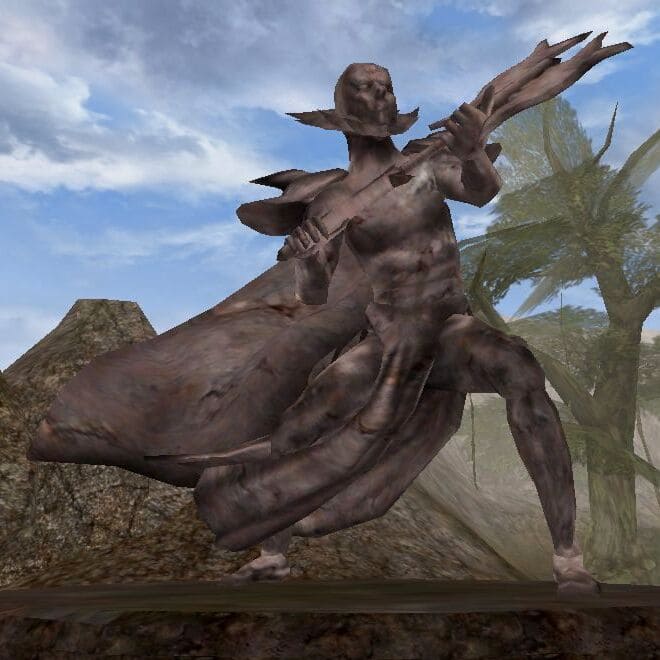 Morrowind Morrowind
|
 Skyrim Skyrim
| ||||
| A depiction of Boethiah could be seen in a statue erected in Nisin Cave, in southwestern Cyrodiil during the mid-Second Era. Boethiah is depicted as a male and wears toga-like clothing while wielding an axe. During this time the cave was occupied by necromancers and Daedra.[265][nb 8] |
Dissatisfied that her shrine was in ruins and her priesthood had forgotten her, Boethiah convinced the Nerevarine to rebuild her statue on Vvardenfell.[266] The Nerevarine sought out Duma gro-Lag, a master sculptor who agreed to build the statue provided he was given a description of an ancient statue of Boethiah found in one of her holy books.[267][268] The sculptor eventually completed the statue in 3E 427 on the site of Khartag Point, which depicted a caped Boethiah wielding a large axe.[266] |
A statue of Boethiah could be found in the wilds of Cyrodiil during the late-Third Era. Although Daedra worship was not prohibited by law in Cyrodiil, public opinion was strongly against it to the extent that Daedra worshippers were forced to practice in secret or in secluded places.[251][269] Located high in the Valus Mountains, the statue depicts Boethiah in a similar manner as other statues, and also served as a shrine for a small coven.[270] This shrine also allowed individuals to solicit the Daedra lord directly, provided they possessed sufficient prowess or strength of character, and provided a proper offering.[251][271] |
A large statue of Boethiah could be found in Velothi Mountains in Skyrim during the early-Fourth Era. The statue depicts a hooded serpent-like Boethiah holding aloft her blade and was the central focus of a larger shrine dedicated to the Prince of Plots.[272] The shrine was occupied by numerous cultists who gathered to perform certain rituals on certain days, hoping to gain a glimpse of their master.[273] One ritual in particular involved testing the guile and conviction of Boethiah's faithful by luring and sacrificing an innocent soul upon a central pillar in the shrine.[274][275] | |||
Clavicus Vile[edit] | ||||
 ESO ESO
|
 ESO ESO
|
 Oblivion Oblivion
|
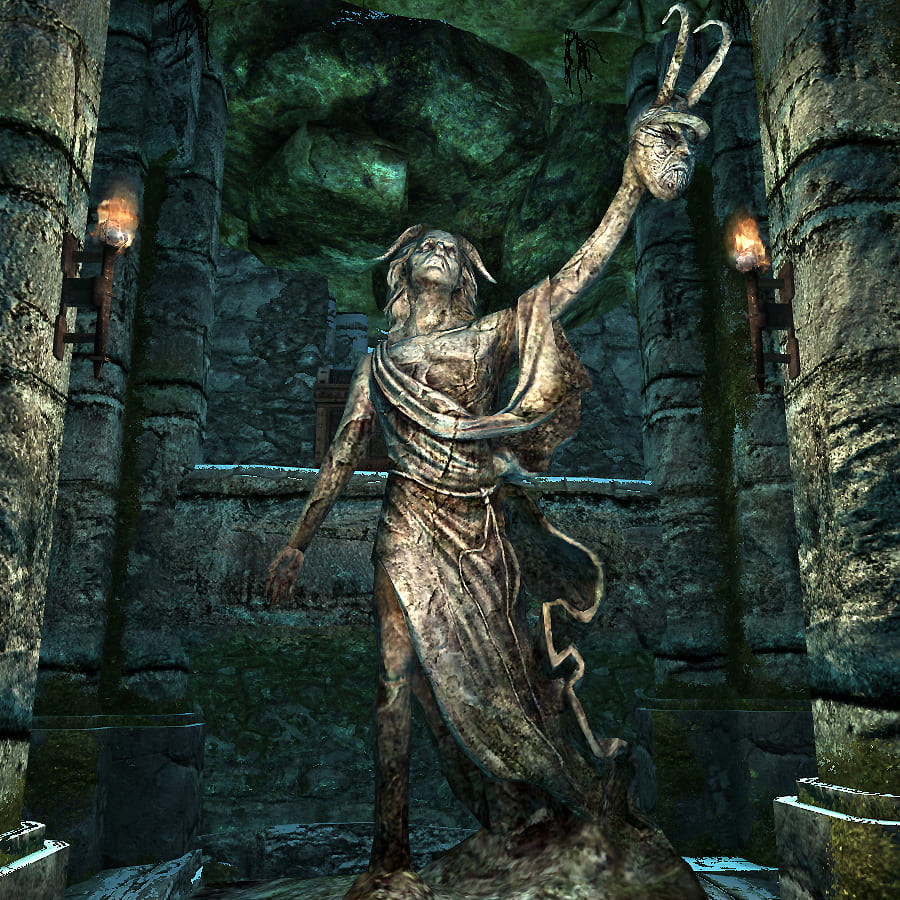 Skyrim Skyrim
| |
|---|---|---|---|---|
|
Statuary and other depictions of Clavicus Vile feature him either wearing or holding his infamous mask, but always include his loyal companion Barbas (who usually takes the form of a large hound) alongside him. Some of these depictions date back to the early Merethic Era in the form of crude, hand-carved idols or ancient cave paintings. Indeed, first-hand accounts detailing encounters with the Prince features Barbas in some capacity without exception. Such is the inseparable nature of these two beings that some Daedrologists believe Barbas and Clavicus Vile are one person in two forms.[276] When the Knahaten Flu swept through Black Marsh, the Kothringi of Stillrise Village uncovered an old temple to Clavicus Vile where a statue of him and Barbas could be found. In desperation, the Kothringi made a pact with the Prince of Bargains to save the village and grant them immunity to the sickness. In a twisted mockery of salvation, Clavicus Vile turned the entire village into undying skeletons.[277] Some of the villagers saw this as a curse, while others saw it as a blessing that made the perfect warriors.[278] |
A statue of Clavicus Vile and Barbas could be found in the wilds of Cyrodiil during the late-Third Era. Although Daedra worship was not prohibited by law in Cyrodiil, public opinion was strongly against it to the extent that Daedra worshippers were forced to practice in secret or in secluded places.[251] Located in the Great Forest, the statue depicts Clavicus Vile and Barbas in a similar manner as other statues and also served as a shrine for a small coven.[279] This shrine also allowed individuals to solicit the Daedra lord directly, provided they possessed sufficient prowess or strength of character, and provided a proper offering.[251][280] |
During the early-Fourth Era, the Last Dragonborn encountered a curious statue of Clavicus Vile in Skyrim. What set this statue apart from traditional depictions was that Vile stood alone, without his faithful companion Barbas. It was later revealed Clavicus Vile and Barbas had a disagreement, resulting in Barbas being exiled. Desperate to win back the favor of his master, Barbas aided the Last Dragonborn in recovering the Rueful Axe for Clavicus Vile.[281] The axe was recovered but the Last Dragonborn was given the option to use it to slay Barbas or return it to Vile, which would result in Barbas being restored to his position alongside Vile in the statue, however it is unknown which option was chosen.[281] | ||
Hermaeus Mora[edit] | ||
 ESO ESO
|
 ESO ESO
|
 ESO ESO
|
|---|---|---|
|
Statuary of Hermaeus Mora is unique in the fact that they are said to be access points from his realm of Apocrypha to Nirn.[282] On occasion, Hermaeus Mora would communicate through his statues to speak to mortals and give them instructions. Prior to the Third Era, Hermaeus Mora was typically depicted as mass of grotesque tentacles covered in eyes.[283][284][285] On occasion, he was represented by large metal orbs that were said to be modeled after his own golden eyes.[286] This depiction is believed to reach as far back as the First Era, where a vast statue and shrine of Hermaeus Mora was erected in Craglorn. Known as the Seeker's Archive, the shrine and library was built underground long before the Yokudans came to Hammerfell in 1E 808. This suggests that the Nedes native to Craglorn were possibly responsible for its construction. The followers of Hermaeus Mora who worshipped there were known as Seekers, and they brought gifts to the the Daedric Prince in return for secret knowledge. After the Yokudans slaughtered the natives, they built a temple over the shrine in order to defend it, but it was eventually forgotten about as the centuries passed.[287][288] | ||
 Skyrim Skyrim
|
 Skyrim Skyrim
| |
|
Around the Third and Fourth Eras, statuary and depictions of Hermaeus Mora were found to include four large pincers, alongside the mass of tentacles. The reason for this is unclear but is best illustrated in a large statue of Hermaeus Mora located high in the Jerall Mountains. The site also served as a secret shrine for a small coven of his worshippers.[289] This shrine also allowed individuals to solicit the Daedra lord directly, provided they possessed sufficient prowess or strength of character, and met certain criteria.[251][290] Other depictions discovered around this time include a large sculpture of Mora found in Miraak's Temple on Solstheim, which depicts him without tentacles entirely.[291] The cover of Mora's mysterious Black Books however are embossed with motifs of him bearing both tentacles and pincers.[292] | ||
Hircine[edit] | |||
 ESO ESO
|
 ESO ESO
|
 ESO ESO
|
 Oblivion Oblivion
|
|---|---|---|---|
|
Statuary of Hircine always depicts him as Alrabeg the Hunter, one of his many aspects. When Alrabeg manifests, he bears the Spear of Bitter Mercy,[293] or sometimes the Spear of the Hunter.[294]. As such, his statuary, figurines, and idols reflect this as he is typically depicted wielding his spears while clothed in furs and a large antler headdress and sometimes flanked by wolves.[295][296] This was evident in Reachman statuary, given that Hircine is widely worshipped in their pantheon and Alrabeg is seen as his most malevolent form. These statues served as shrines and altars, and played a part in Reachman hunting rituals.[108] A notable example of this is in the Shrine of the Hunt-Father in Markarth, where a large statue of Hircine was erected during the mid-Second Era.[297] Though the Dunmer primarily worship the Good Daedra and recognize the House of Troubles as obstacles, some dissidents erected statues in worship of Hircine in Dunmer lands during the mid-Second Era. Examples include the statue of Hircine present at Heimlyn Keep,[298] or a shrine to the Huntsman in the ruins of Ularradallaku.[299] In the Bosmer village of Wilding Run, a large statue of Hircine was found at its center.[300] It was believed to be associated with Ulthorn, who came under the influence of Hircine and became known as the Hound. Ulthorn returned to his hometown of Wilding Run and wiped out the local populace as he hunted them for sport.[301][302] |
A statue of Hircine could be found in the wilds of Cyrodiil during the late-Third Era. Although Daedra worship was not prohibited by law in Cyrodiil, public opinion was strongly against it to the extent that Daedra worshippers were forced to practice in secret or in secluded places.[251] Located in the Great Forest, the statue depicts Hircine in a similar manner as other statues, and also served as a shrine for a small coven.[303] This shrine also allowed individuals to solicit the Daedra lord directly, provided they possessed sufficient prowess or strength of character, and provided a proper offering.[251][304] | ||
Malacath[edit] | |||
 ESO ESO
|
 ESO ESO
|
 ESO ESO
| |
|---|---|---|---|
|
Statuary of Malacath could be found throughout Wrothgar during the mid-Second Era, and typically depicted him wearing a loincloth and wielding a sword. Despite attempts to replace the worship of Malacath with Trinimac during this time, the most notable statue of him was found in the Druadach Mountains, where a vast shrine and forge stood.[305] Some Orcs displayed statuettes of Malacath in their home to remind others of the importance of grudges and the cost of vengeance.[306] Stone idols and totems also depict the Keeper of the Bloody Curse, and some Orcs are known to repeatedly apply blood to them, resulting in them taking on a rust-brown color.[307] The stone of some statuary found around this time appeared heavily chipped and cracked, leading some scholars to speculate if this disfigurement was possibly not from neglect, but rather blasphemy, or even devotion.[308] The Seamount Clan Orcs were known to craft heavy, wrought-iron statues that depict Mauloch in battle and were used as table centerpiece in their dwellings.[309] | |||
 ESO ESO
|
 Morrowind Morrowind
|
 Oblivion Oblivion
|
 Skyrim Skyrim
|
|
A large high-relief statue of Malacath was built deep in the halls of the original Orsinium. The statue was notable as it depicts Malacath wielding a Scourge-like battleaxe, instead of a sword.[310] The statue also served as a shrine which overlooks a vast pyre. An Orcish religious order known as the Wrathful Flame considered the pyre sacred and was devoted to rekindling the pyre every generation. According to their doctrine, the pyre fuels vengeance in the hearts of Malacath's followers as they bind his anger to their failures and strive to remember what led to their doom.[311][312] |
During the late-Third Era, numerous statues of Malacath could be found across Vvardenfell, including the Daedric ruins of Ashunartes, Dushariran, Kaushtarari, and others. As the First Corner of the House of Troubles, Malacath was seen as an adversarial god to the Dunmer and is believed to test them for weakness.[313] Those who sought to become the Archcanon of the Temple were required to travel to the Malacath's statue on Dagon Fel and recite Vivec's "Four Corners of the House of Troubles".[314] |
A statue of Malacath could be found in the wilds of Cyrodiil during the late-Third Era. Although Daedra worship was not prohibited by law in Cyrodiil, public opinion was strongly against it to the extent that Daedra worshippers were forced to practice in secret or in secluded places.[251] Located in the Gold Coast, the statue depicts Malacath in a similar manner as other statues and also served as a shrine for a small Orcish coven.[315] This shrine also allowed individuals to solicit the Daedra lord directly, provided they possessed sufficient prowess or strength of character, and provided a proper offering.[251][316] |
A large statue of Malacath was erected in a hidden grove found deep in the valleys of the Velothi Mountains in Skyrim.[317] It was almost identical in appearance to the vast shrine of Malcath found in the mountains of Wrothgar during the mid-Second Era.[305] The statue served as a shrine for the Orcs of Largashbur, but during the early-Fourth Era the site was overrun by a group of giants, who defiled the shrine. Furious that the chief of Largashbur was weak enough to allow this to occur, Malacath cursed the Orcish tribe until such a time they could prove their worth.[318] |
Mehrunes Dagon[edit] | |||
 ESO ESO
|
 Morrowind Morrowind
|
 Oblivion Oblivion
|
 Skyrim Skyrim
|
|---|---|---|---|
|
Statuary of Mehrunes Dagon typically depicts him as a hulking four-armed Daedra wielding a large battle-axe. Vast statues of Dagon could be found throughout the Deadlands, his realm of Oblivion.[319] |
During the late-Third Era, numerous statues of Mehrunes Dagon could be found across Vvardenfell, including the Daedric ruins of Ald Sotha, Ebernanit, Ularradallaku, and others. As the Second Corner of the House of Troubles, Mehrunes Dagon was seen as an adversarial god to the Dunmer and represents the trials they face in the lands of Morrowind.[313] Those who sought to become Archcanon of the Temple were required to travel to the statue at Ald Sotha, where Vivec rescued Sotha Sil from the armies of Mehrunes Dagon, and recite Vivec's "Four Corners of the House of Troubles".[320] |
During the late-Third Era, the Mythic Dawn cult established a hidden shrine to Mehrunes Dagon in the caverns near Lake Arrius in Cyrodiil, wherein they built a large statue of the Daedra lord. The statue overlooked a sacrificial altar, where Mankar Camoran himself delivered sermons and initiates of the cult were required to kill captives in order to join the cult. The statue was destroyed when the Hero of Kvatch infiltrated the shrine and stole the Mysterium Xarxes in an effort to stop the Oblivion Crisis.[321] |
An enormous statue of Mehrunes Dagon could be found in the mountains of The Pale in Skyrim during the early-Fourth Era. His monstrous form appears seated atop a small shrine while holding his battle-axe, as he overlooks an altar below. Although its unclear who built the statue, it was known to be associated with the Mythic Dawn, a Daedric cult that rose to prominence during the Oblivion Crisis. The shrine was previously an ancient Nordic tomb before the cult repurposed it in reverence to Dagon.[322] Following the Oblivion Crisis, numerous militia groups formed and pledged to eradicate the remnants of the Mythic Dawn from Tamriel. One such militia group, later known as the Keepers of the Razor, operated in Skyrim and contributed to eradicating the cult's remnants in Nordic lands.[323] |
Mephala[edit] | |||
 ESO ESO
|
 ESO ESO
|
 ESO ESO
|
|
|---|---|---|---|
|
During the mid-Second Era, Mephala was oft associated with spiders and spider-like iconography. As such, her statuary and idols reflected this as she was typically depicted with numerous spider-like legs protruding from her body.[324] Some of these idols and effigies were adorned with meticulously woven spider silk garments and used in the secret worship of the Daedric Prince.[325][326] One notable example was found in the Cradle of Shadows, where an upside-down statue of Mephala could be found hanging from the ceiling in the Spinner's Sanctuary. [327] Mephala was also featured in Dunmeri basalt sculptures (alongside Azura and Boethiah) and used in their veneration of the "Good Daedra".[328] |
Large sculptures of Mephala, known as Velidreth's Devotion, were found scattered throughout the Cradle of Shadows in Shadowfen. These are large busts had the ability to empower members of the resident Silken Ring cultists and also attack intruders.[329] An identical bust was also found in the Crypt of Hearts in Rivenspire, a former school where Mephala's whisperings corrupted Nerien'eth's mind, until eventually he snapped and ensnared the souls of his students and fellow researchers.[330] |
A statue of Mephala could be found in the wilds of Cyrodiil during the late-Third Era. Although Daedra worship was not prohibited by law in Cyrodiil, public opinion was strongly against it to the extent that Daedra worshippers were forced to practice in secret or in secluded places.[251] Located in the Great Forest, the statue depicts Mephala much less spider-like as in previous statuary, but as a four-armed woman wearing a garland of skulls (although she was still referred to as "the Webspinner").[331][332] The statue also served as a shrine for a small coven and allowed individuals to solicit the Daedra lord directly, provided they possessed sufficient prowess or strength of character, and provided a proper offering.[251][333] | |
Meridia[edit] | |||
 ESO ESO
|
 ESO ESO
|
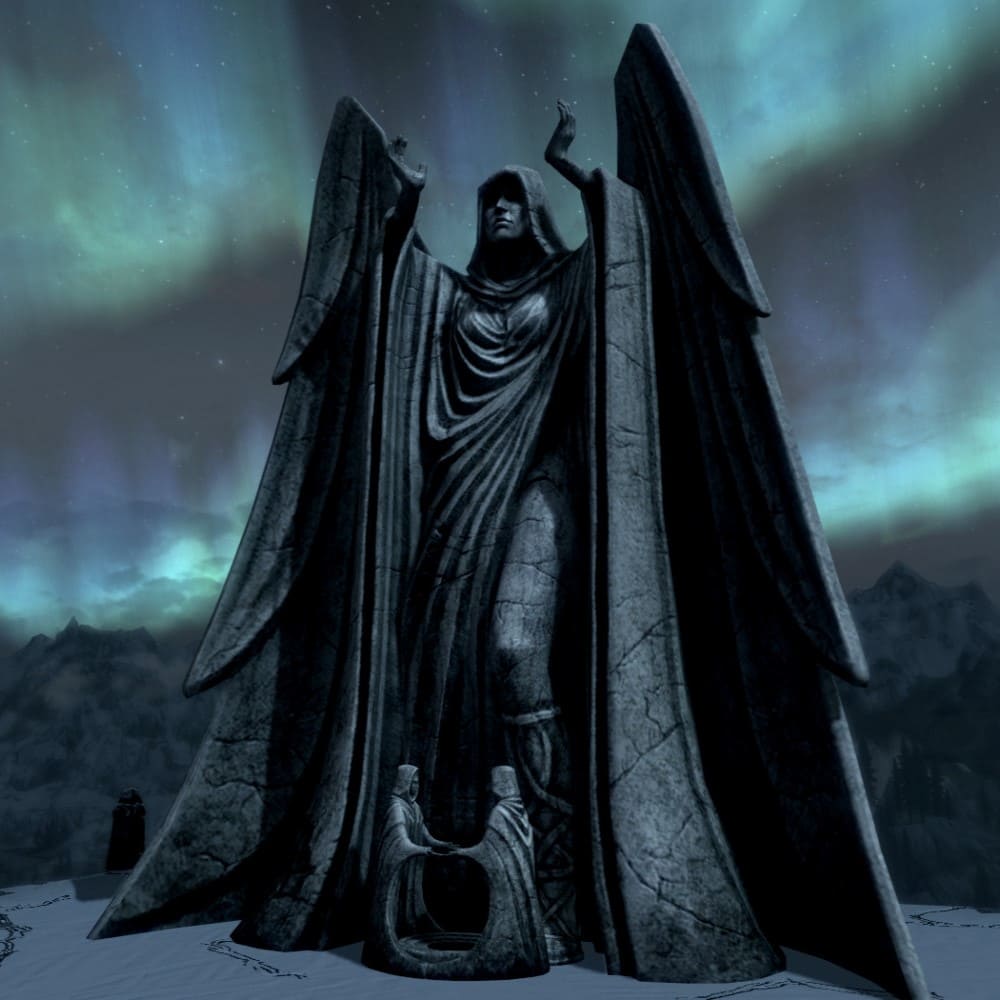 Skyrim Skyrim
|
|
|---|---|---|---|
|
Altmeri statuary of Meridia sometimes depicts her as a robed woman with large wings protruding from her torso. Through these statues, she was known to occasionally communicate to mortals or give them instructions. One such example could be seen in a large gleaming statue of her found in a temple deep beneath Eton Nir on Summerset Isle. Home to the Cult of Meridia, the temple was attacked during the mid-Second Era by opposing Daedric forces, and her statue was desecrated.[334][335] |
An identical statue of Meridia was erected outside Kilkreath Temple in Skyrim at some point before the mid-Second Era. Although the Nords largely worshipped the Divines during this time, and Daedra worship was a controversial subject in Tamriel, this particular Daedric temple stood unopposed. Rather, pilgrims and travelers from across Skyrim were known visit the temple to seek refuge, pray, seek blessings or even simply view its architecture. [336][337][338] During the Three Banners War, the priesthood of Meridia's cult tended to the temple and it was led by a high priest.[339] The priests were known to be warm and hospitable with travelers, and welcomed thoughtful, albeit heretical, conversation.[338] At an unknown point after the war, the cult seemingly abandoned the temple and it fell into ruins. Although the statue remained intact at late as the early-Fourth Era, the temple itself was overrun with corrupted shades led by a powerful necromancer.[340] |
A statue of Meridia could be found in the wilds of Cyrodiil during the late-Third Era. Although Daedra worship was not prohibited by law in Cyrodiil, public opinion was strongly against it to the extent that Daedra worshippers were forced to practice in secret or in secluded places.[251] Located in the West Weald, the statue depicts Meridia differently from previous statuary, notably the exclusion of flowing robes and wings.[341] The statue also served as a shrine for a small coven and allowed individuals to solicit the Daedra lord directly, provided they possessed sufficient prowess or strength of character, and provided a proper offering.[251][342] | |
Molag Bal[edit] | |||||
 ESO ESO
|
 ESO ESO
|
 ESO ESO
| |||
|---|---|---|---|---|---|
|
Statuary of Molag Bal during the Planemeld typically depicted him as a hulking horned Daedra wielding his infamous mace. Vast statues of Molag Bal could be found throughout Coldharbour, his realm of Oblivion.[343] Similar statues could be found on Tamriel, usually in Worm Cult strongholds, such the ruined Daedric temples of Ashalmawia or Bal Ur in Vvardenfell.[344][345] Other examples of sculpture include intricately carved effigies made of solid obsidian with ruby eyes that were used by Stonefire Cultists in their dark ceremonies. [346] Bas-reliefs bearing his terrifying visage could also be found in various places associated with him, such as the mooring of the Great Shackle.[347][348] | |||||
 Morrowind Morrowind
|
 Oblivion Oblivion
|
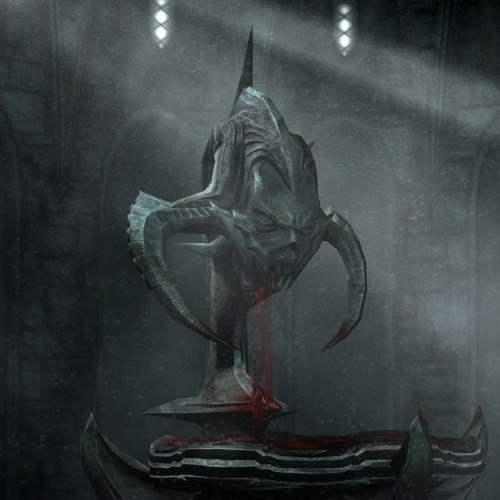 Skyrim Skyrim
| |||
|
During the late-Third Era, numerous statues of Molag Bal could be found across Vvardenfell, including the Daedric ruins of Ramimilk, Kushtashpi, Tusenend, and others. As the Third Corner of the House of Troubles, Molag Bal was seen as an adversarial god to the Dunmer who tries to destroy them by corrupting their bloodlines.[313] Those who sought to become Archcanon of the Temple were required to travel to the statue at Bal Ur and recite Vivec's "Four Corners of the House of Troubles". Bal Ur itself was believed to be the birthplace of Molag Bal and where Vivec defeated him and sent him back into Oblivion.[349][313] |
A statue of Molag Bal could be found in the wilds of Cyrodiil during the late-Third Era. Although Daedra worship was not prohibited by law in Cyrodiil, public opinion was strongly against it to the extent that Daedra worshippers were forced to practice in secret or in secluded places.[251] Located in the Great Forest, the statue depicts Molag Bal in a similar manner as statues found in Vvardenfell, and also served as a shrine for a small coven.[350] This shrine also allowed individuals to solicit the Daedra lord directly, provided they possessed sufficient prowess or strength of character, and provided a proper offering.[251][351] |
A stylized bust of Molag Bal could be found in Castle Volkihar during the early-Fourth Era. Located in the castle's cathedral, it served as an unholy shrine to the Daedra lord and depicted a large horned head with blood pouring from its mouth into a large basin. The castle was home to Lord Harkon of the Volkihar clan, who pledged himself to Molag Bal and made a pact with him. As a reward, Molag Bal gifted him with everlasting life by way of vampirism.[352][353] | |||
Namira[edit] | ||||
 ESO ESO
|
 ESO ESO
|
 Skyrim Skyrim
|
 Legends Legends
| |
|---|---|---|---|---|
|
Statuary or bas-reliefs of Namira are uncommon, but those that are known to exist typically depict her as a woman in some form. Given Namira is often associated with slugs, spiders, and other things that inspire instinctive revulsion in mortals, her statuary sometimes reflects this. For example, statues and bas-reliefs from the mid-Second Era (such as the one found in the Temple of Seven Riddles) depicts Namira in a horrifying skeletal from, with crab-like legs protruding from her torso. [354][355] A statue of Namira could be found in the wilds of Cyrodiil during the late-Third Era. Although Daedra worship was not prohibited by law in Cyrodiil, public opinion was strongly against it to the extent that Daedra worshippers were forced to practice in secret or in secluded places.[251] Located in the Jerall Mountains, the statue depicts Namira in a much less grotesque from as seen in previous statuary, but as a robed woman with a scamp by her feet.[356] The statue also served as a shrine for a small coven and allowed individuals to solicit the Daedra lord directly, provided they possessed sufficient prowess or strength of character, and provided a proper offering.[251][357] Other statuary or shrines dedicated to Namira from the early-Fourth Era sometimes depicts her alongside bat-like imagery and motifs.[358][359] | ||||
Nocturnal[edit] | ||
 ESO ESO
|
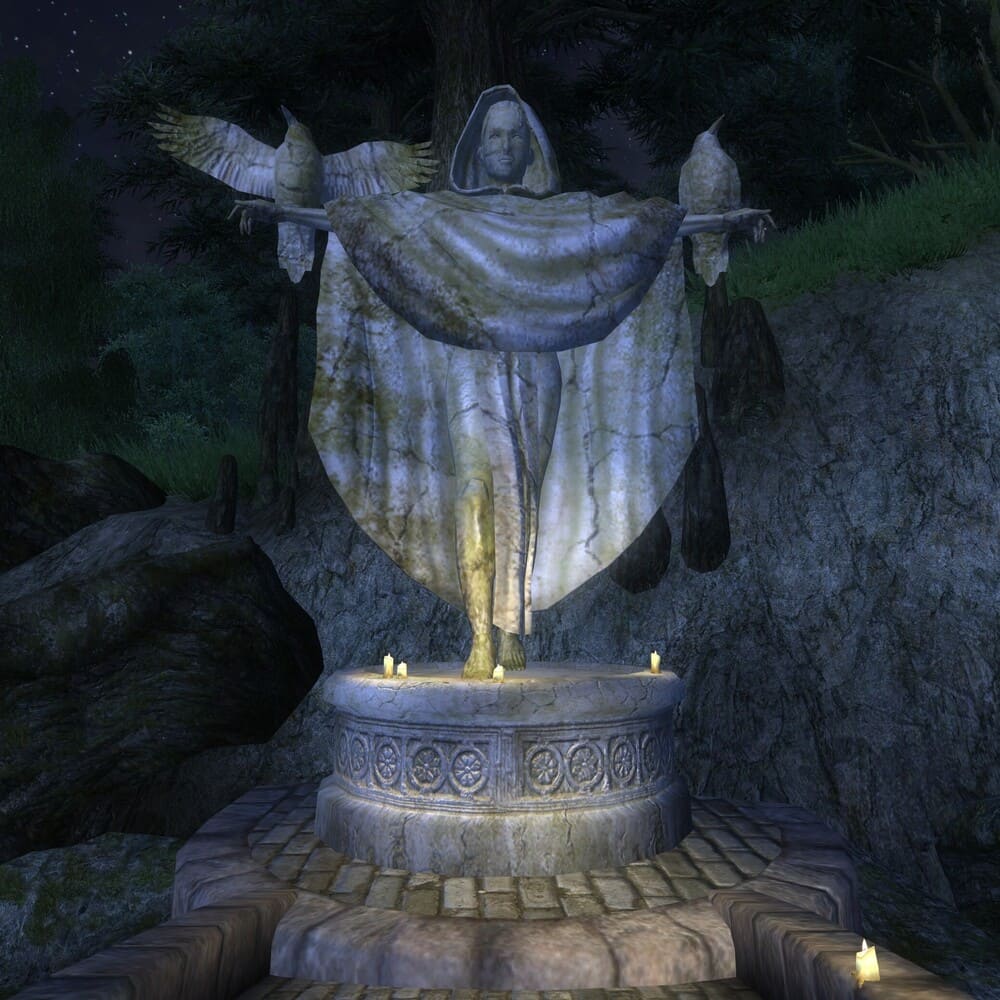 Oblivion Oblivion
|
 Skyrim Skyrim
|
|---|---|---|
|
Statuary of Nocturnal typically depicts her as a robed woman with crows perched upon her arms. Through these statues, she was known to occasionally communicate to mortals or give them instructions. One such example could be seen in the Blackwood region of Cyrodiil, where a statue of her was erected dating back to at least the mid-Second Era.[360] The Shade Sickle, a powerful instrument of Nocturnal's will, was kept at the Daedric shrine during the Three Banners War, and was briefly stolen by a necromancer before it was recovered.[361][362] By the late-Third Era, the Shade Sickle was no longer found at the shrine, but a small coven of Nocturnal cultists had taken up residence.[363] They allowed individuals to solicit the Daedra lord directly, provided they possessed sufficient prowess or strength of character, and provided a proper offering.[251][364] |
Two almost identical statues of Nocturnal could be found in Skyrim during the early-Fourth Era. One was discovered in the ancient sanctuary of Twilight Sepulcher during the Nightingales efforts to return the Skeleton Key to its rightful place.[365] Another was erected in the Ragged Flagon beneath Riften after the Thieves Guild was restored to its former glory.[366] | |
Peryite[edit] | ||
 ESO ESO
|
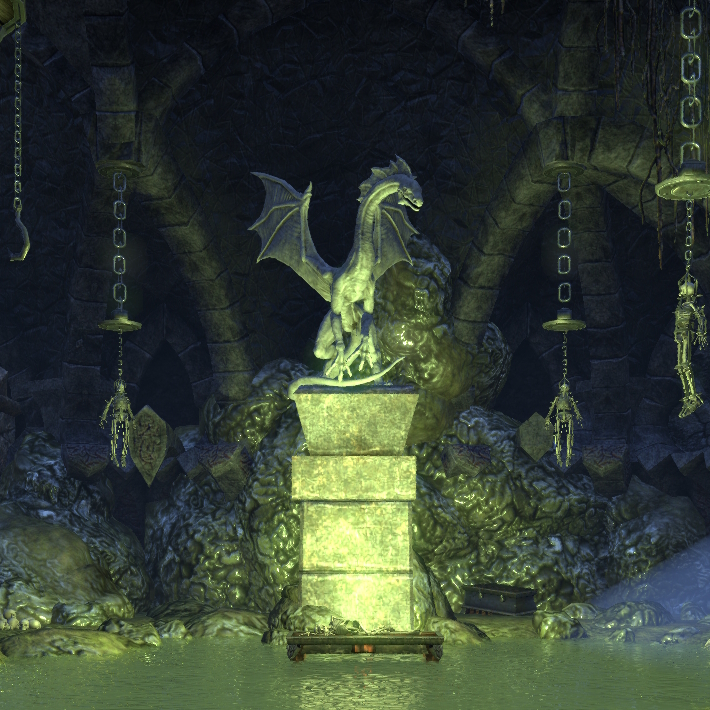 ESO ESO
|
|
|---|---|---|
| Peryite typically takes the form of one of his sacred symbols: a four-legged dragon, and his statuary reflects this.[367] One notable example could be found at the summit of Scalecaller Peak, where the Dragon Priest Zaan the Scalecaller found refuge after her master, Thurvokun, abandoned her.[368] It was here Zaan turned to worship Peryite and erected three large statues of the Daedra lord, which also functioned as defensive sentries by way of spitting poisonous fumes at any intruders.[369] | Numerous statues of Peryite could be found in the town of Bal Sunnar in Morrowind as a result of a temporal distortion.[370] In an alternate reality, Bal Sunnar lay in ruins after the town's founder, Matriarch Lladi Telvanni, traveled into the future and made a defensive pact with Peryite.[371] This resulted in the construction of a vast temple dotted with statues dedicated to the Taskmaster.[372][373] |
A statue of Peryite could be found in the wilds of Cyrodiil during the late-Third Era. Although Daedra worship was not prohibited by law in Cyrodiil, public opinion was strongly against it to the extent that Daedra worshippers were forced to practice in secret or in secluded places.[251] Located in the Nibenay Valley, the statue depicts Peryite once again as a dragon and also served as a shrine for a small coven.[374] This shrine also allowed individuals to solicit the Daedra lord directly, provided they possessed sufficient prowess or strength of character, and provided a proper offering.[251][375] |
Sanguine[edit] | |
|
Statuary of Sanguine is particularly rare, and only one example is known to exist. Found in the Colovian Highlands in Cyrodiil during the late-Third Era, the statue depicts Sanguine as a stocky, horned Dremora-like creature head holding a flagon and standing on a skull.[376] The statue also served as a shrine for a small coven and allowed individuals to solicit the Daedra lord directly, provided they possessed sufficient prowess or strength of character, and provided a proper offering.[251][377] |
|
Sheogorath[edit] | |||||
 ESO ESO
|
 Morrowind Morrowind
|
 Oblivion Oblivion
|
 Legends Legends
| ||
|---|---|---|---|---|---|
|
Statuary of Shegorath dating back to at least the mid-Second Era depict him as a flamboyantly dressed man holding a walking cane. By the late-Third Era, numerous statues of Sheogorath could be found across Vvardenfell, including the Daedric ruins of Ald Daedroth, Zaintiraris, Maelkashishi and others. As the Fourth Corner of the House of Troubles, Sheogorath was seen as an adversarial god to the Dunmer and was known to test them for mental weakness.[313][378] Those who sought to become Archcanon of the Temple were required to travel to the statue at Ald Daedroth and renew a pact Vivec made with Sheogorath long ago, that prevented Sheogorath from tormenting them with madness. This involved donating an artifact named Gambolpuddy while reciting Vivec's "Four Corners of the House of Troubles".[379][313] Another statue could be found in the Blackwood region of Cyrodiil around the same time.[380] The statue also served as a shrine for a small coven and allowed individuals to solicit the Daedra lord directly, provided they possessed sufficient prowess or strength of character, and provided a proper offering.[251][381] |
During the late-Third Era, a large sculpture mysteriously appeared on a small island in the middle of the Niben Bay. The abstract statue depicted Sheogorath in three different expressions, with the center statue serving as a portal to his realm, the Shivering Isles.[382] Sheogorath's infamous staff, the Wabbajack, also featured a similar design, depicting his various expressions carved into the tip.[383] | ||||
 Oblivion Oblivion
|
 Oblivion Oblivion
|
 Oblivion Oblivion
|
 Oblivion Oblivion
|
 Oblivion Oblivion
| |
|
Numerous statues of Sheogorath could be found within the Shivering Isles itself, depicting him in various styles. These included a simple bust as seen outside the Gates of Madness in The Fringe. In Crucible he could be seen seated on a throne with a winding serpent below him. In Bliss he could be seen on a mermaid-themed fountain while lounging on his throne. In other locations in his realm, Sheogorath's statues also served as traps for unwary adventurers. Arguably most notable statue of Sheogorath is the vast sculpture of him that sits at the highest point of the isles overlooking New Sheoth.[384] | |||||
Vaermina[edit] | ||||
 ESO ESO
|
 ESO ESO
|
 Skyrim Skyrim
|
 Skyrim Skyrim
| |
|---|---|---|---|---|
|
Statuary of Vaermina dating back to the mid-Second Era typically depicts her as a robed woman wearing a snake-like mask while holding a spiked staff and two serpents. Through these statues, she was known to occasionally communicate with mortals or give them instructions. These statues could be found not only in the mortal world but also in people's nightmares where they could visit a pocket realm in Vaermina's plane of Quagmire.[385][386][387] One such example dating back to at least the Three Banners War could be seen in the Nibenay Basin region of Cyrodiil, where it served as a shrine and was tended to by a group of Vaermina cultists known as the Supernal Dreamers.[388] By the late-Third Era the cultists continued to maintain the shrine, but the statue no longer bore serpent imagery. The cultists allowed individuals to solicit the Daedra lord directly, provided they possessed sufficient prowess or strength of character, and provided a proper offering.[251][389] Around this time smaller idols used in the worship of the Mistress of Nightmares could be found and conversely, some people were known to burn candles in front of serpentine figurines to keep Vaermina from infiltrating their dreams.[390][391] |
A stylized sculpture of Vaermina could be found in Nightcaller Temple during the early-Fourth Era. Located deep in the lower sanctum, it served as a shrine to the Daedra lord and depicted Vaermina as a woman flanked by two serpent hears. The temple was home to a group of Vaermina cultists before it was invaded by a band of Orcs.[392][393] | |||
Other Deities[edit]
The Lady in the Cistern[edit] | |
|
The Lady in the Cistern was the name given to a mysterious statue found hidden away in the sewers under Abah's Landing in Hew's Bane. When the sewers became the headquarters of the Thieves Guild during the mid-Second Era, the statue of the unknown woman with a serpent coiled around her was discovered hidden in a cistern that was once bricked off behind another cistern.[394] It remained unknown to the guild who she represented or why the statue was built there, but guild members had numerous theories. These included Nocturnal,[394] the Lucky Old Lady statue in Bravil,[395] the Night Mother (and the snake wrapped around her representing Sithis)[396] Hazadiyya Sea-Queen (wrapped in a sea serpent)[397] or Zeqqi, the Madonna of Tears.[398] Another theory was it represented the Yokudan goddess Leki administering her Ephemeral Feint, given this was how sculptors would depict it during early First Era, and also that it bore similarities to the enormous statue of Prince Hubalajad south of the Abah's Landing's harbor. It was speculated that the sculptor who hid Leki's modest statue away in the cistern did so to spite Prince Hubalajad and his achievements.[39] |
 ESO ESO
|
Night Mother[edit] | |||
 ESO ESO
|
 ESO ESO
|
 Oblivion Oblivion
|
 Skyrim Skyrim
|
|---|---|---|---|
|
During the mid-Second Era, a seated statue of the Night Mother stood inside the Dark Brotherhood's Gold Coast sanctuary. Five skulls were placed on her lap, representing her five murdered children.[212] |
The motif of her murdered five children is again represented in bas-reliefs found on the Black Doors of Dark Brotherhood sanctuaries in the Gold Coast and Blackwood. Here it shows the Night Mother wielding a blade over the heads of her children, whom she later murdered in a dark ritual with Sithis who is also represented by a large skull.[399][400] During the Third and Fourth Eras, Dark Brotherhood sanctuary doors in Cyrodiil and Skyrim similarly depicted the Night Mother's murders.[401][402][403] | ||
|
The statue in the center of Bravil was known as the Lucky Old Lady, but unbeknownst to the city folk it was actually a shrine to the Night Mother herself. It was here the Listener of the Dark Brotherhood would prays to the Night Mother each night, who would in turn inform the Listener about targets for assassination. Beneath the statue was the secret crypt of the Night Mother, where the bodily remains of her and her five children were interred. During the late-Third Era after the Purification of the Cheydinhal Sanctuary, the Night Mother summoned the Black Hand to her crypt where it was revealed Mathieu Bellamont was a traitor who sought to destroy the Brotherhood.[404] On the 1st of Sun's Dusk in 4E 188, the statue was destroyed after Bravil erupted in violence over a war of control being Cyrodiil's two largest skooma traffickers. Listener Alisanne Dupre attempted to guard the crypt of the Night Mother, but was burned alive and the crypt was raided.[405] |
 Oblivion Oblivion
| ||
Sithis[edit] | ||
 ESO ESO
|
 ESO ESO
|
 Oblivion Oblivion
|
|---|---|---|
|
Argonians are one of the only cultures in Tamriel to openly revere Sithis, and as a result, numerous forms of statuary depicting him can be found across ancient temples in Black Marsh.[406] One notable example was a vast statue of Sithis was built in the temple of Xul-Thuxis in Murkmire, before it was abandoned. The name of the temple translates to "Snake-Means-Death City" - an appropriate name for a temple dedicated to the Dread Father.[407] |
Another large statue could be found as the centerpiece in the ancient Argonian temple of Xith-Izkul, located deep in the heart of Blackwood. The temple later became a sanctuary for the Dark Brotherhood before it purified by the Black Hand and abandoned.[408] |
A skeletal statue of Sithis with a gaping hole in his chest could be found in the ancient ruins of Deepscorn Hollow in Cyrodiil during the late-Third Era. Believed to have been a First Era temple devoted to the Dread Father, its subterranean halls eventually fell into ruin and sank into the boggy southern coast of Blackwood and various dark cults were known to have taken shelter over the years, such as the Unmakers[409][410][411] |
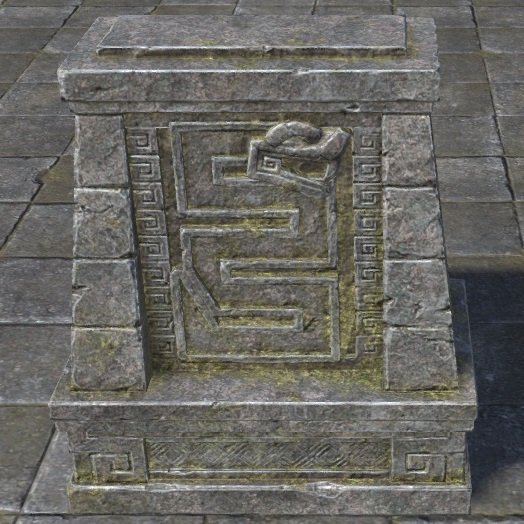 ESO ESO
|
 ESO ESO
|
 ESO |
|
Ancient Argonians often associated Sithis with serpent or skeletal imagery, and this could be seen in the numerous shrines and idols across Black Marsh.[412][413][414] The likeness of Sithis was also inscribed on brass medallion carried by the Shadowscales as a means to identify fellow members.[415] | ||
Ius[edit] | |
|
Ius the Extremely Agitated is the God of Animals in some folklore. He has statues throughout Valenwood and parts of Hammerfell and Elsweyr. These statues depict Ius as a little misshapen humanoid carrying a rod with scales on each end.[416][417][UOL 4] |
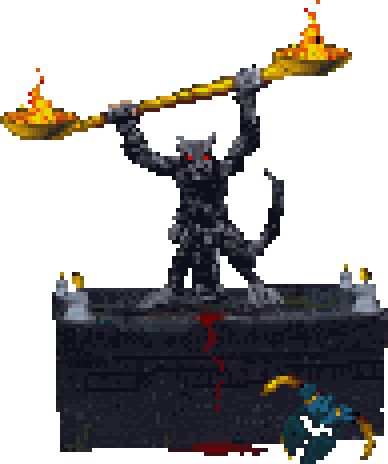 Arena Arena
|
Other Statues[edit]
Alduin's Wall[edit] | |
 Skyrim Skyrim
| |
|---|---|
|
Alduin's Wall is a large Akaviri bas-relief found within Sky Haven Temple. It is considered to be one of the best preserved examples of early Akaviri sculptural relief, as well as a wonder of the ancient world. Although Akaviri in origin, craftsmen were said to have incorporated the flowing Nordic style into its design.[418] It is noted for recording the Prophecy of the Dragonborn, which foretells five key historical events that would preface Alduin's return. The first half of Alduin's Wall depicts the historic events of the Dragon War and the banishment of Alduin by the ancient Nord heroes. The other half foretells the omens required to fulfil the prophecy.[419] Emperor Reman II granted the Akaviri Dragonguard permission to begin the construction of Alduin's Wall in 1E 2812. Its purpose was to record all of the dragonlore the Dragonguard had accumulated, and to preserve this knowledge against the forgetfulness of time. Akaviri craftsmen and artisans were summoned from temples across the Empire to build the wall and after six years it was completed. Reman II visited the Sky Haven Temple to officially dedicate the wall and consecrate the Blood Seal at the temple's entrance in the presence of all the Dragonguard of Skyrim. Despite being a wonder of the ancient world, the location of Alduin's Wall was lost over time, and its very purpose was ironically forgotten.[420][418] The wall was re-discovered by the Last Dragonborn in 4E 201 and the Blades during their quest to stop Alduin.[80] | |
Battle of the Bones Memorial[edit] | |
|
Battle of the Bones Memorial is a memorial depicting an axe wielding Nord Warrior found in the Rift, Skyrim.[nb 9] It marks one of Unnvald Ironhand's most well-known battles. In a pass through the Velothi Mountains, he defended Fullhelm Fort from the undead conjured by necromancers of Fort Virak, a keep on the other side of the pass in Stonefalls.[421][422] After the Battle of the Bones a memorial was built just south of Fullhelm Fort. Unnvald claimed that it was built to honor the deceased but his granddaughter believed it was made to taunt his enemies since it cannot be seen from Fullhelm Fort but is particularly visible from Fort Virak. After the battle, Unnvald left his sword, Bonebane, in a chest near the memorial, vowing to never pick it up again.[423] |
 Skyrim Skyrim
|
Broken Statue of Fanacasecul[edit] | |
|
An enchanted Ayleid statue was discovered outside the ruins of Fanacasecul in Cyrodiil. The ruined sculpture contained the spirit of an Ayleid who was magically trapped inside during the reign of the Ayleids in the First Era. According to the spirit, the sculptor bore a grudge against them and bound their spirit to the statue during its unveiling. In its prime, Fanacasecul was a pleasure garden of the Ayleids, replete with flowering trees and plants. For many years the statue served as a source of amusement in these gardens and the spirit was frequently tormented by the citizenry.[424] After the defeat of the Ayleids in the First Era, Fanacasecul fell into ruins and the statue was largely destroyed except for the plinth. When it was re-discovered during the Three Banners War, the trapped spirit spoke of its sole desire to be whole again, however, to do so required a skilled sculptor.[424] At some point between the mid-Second and late-Third Era the statue was indeed restored to its former glory.[425] |
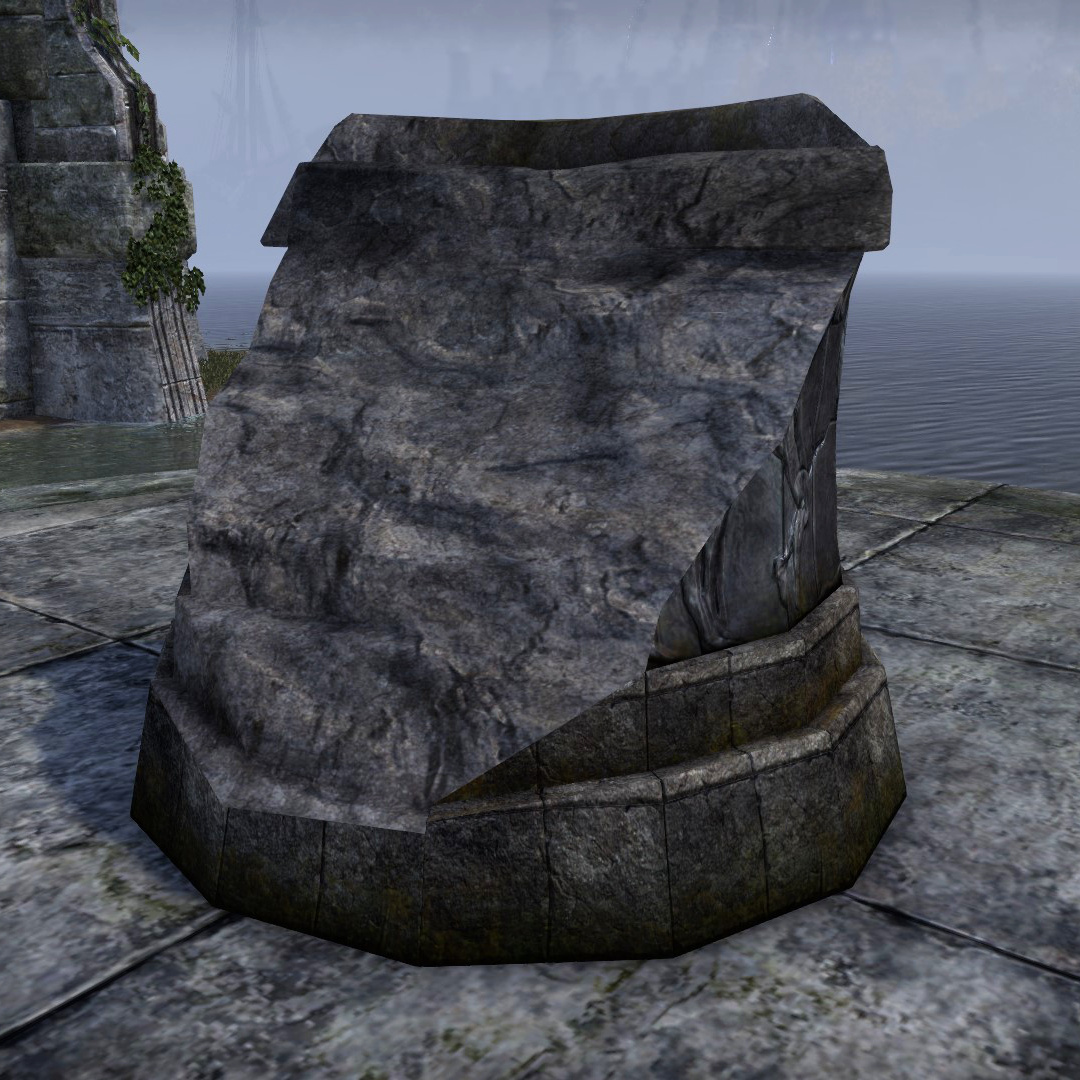 ESO ESO
|
Brothers of Strife[edit] | |
|
The Brothers of Strife is the name of the enormous stone statue towering over ancient Chimer ruins in the Stonefalls region of Morrowind. It was named after the Brothers of Strife, two Daedric creatures created there. The ruins around the statue was the location of the Chimer army's last stand after Nedes from Skyrim invaded Stonefalls in the First Era. In desperation, the Chimer sacrificed two of their leaders, General Balreth and Legate Sadal, in order to summon the Brothers of Strife. The Brothers drove the Nedes from Stonefells and the statue was later built to commemorate the Chimer's sacrifice.[426][427] In 2E 582, a researcher from House Telvanni named Sorcerer Vunal traveled to the Brothers of Strife to learn what had happened during the battle. The Vestige later helped Vunal complete his research by establishing a link to the distant past and viewing past events.[428] Around this time, large feldspar crystal sculptures and chrysolite carved bookends depicting the Brothers of Strife could be found.[429][430] |
 ESO ESO
|
Bruma Warrior[edit] | |
|
A large statue of an unknown Nord warrior stood in the city of Bruma in Cyrodiil during the late-Third Era. It depicts him shouting, likely alluding to the Nordic power of the Thu'um.[3] |
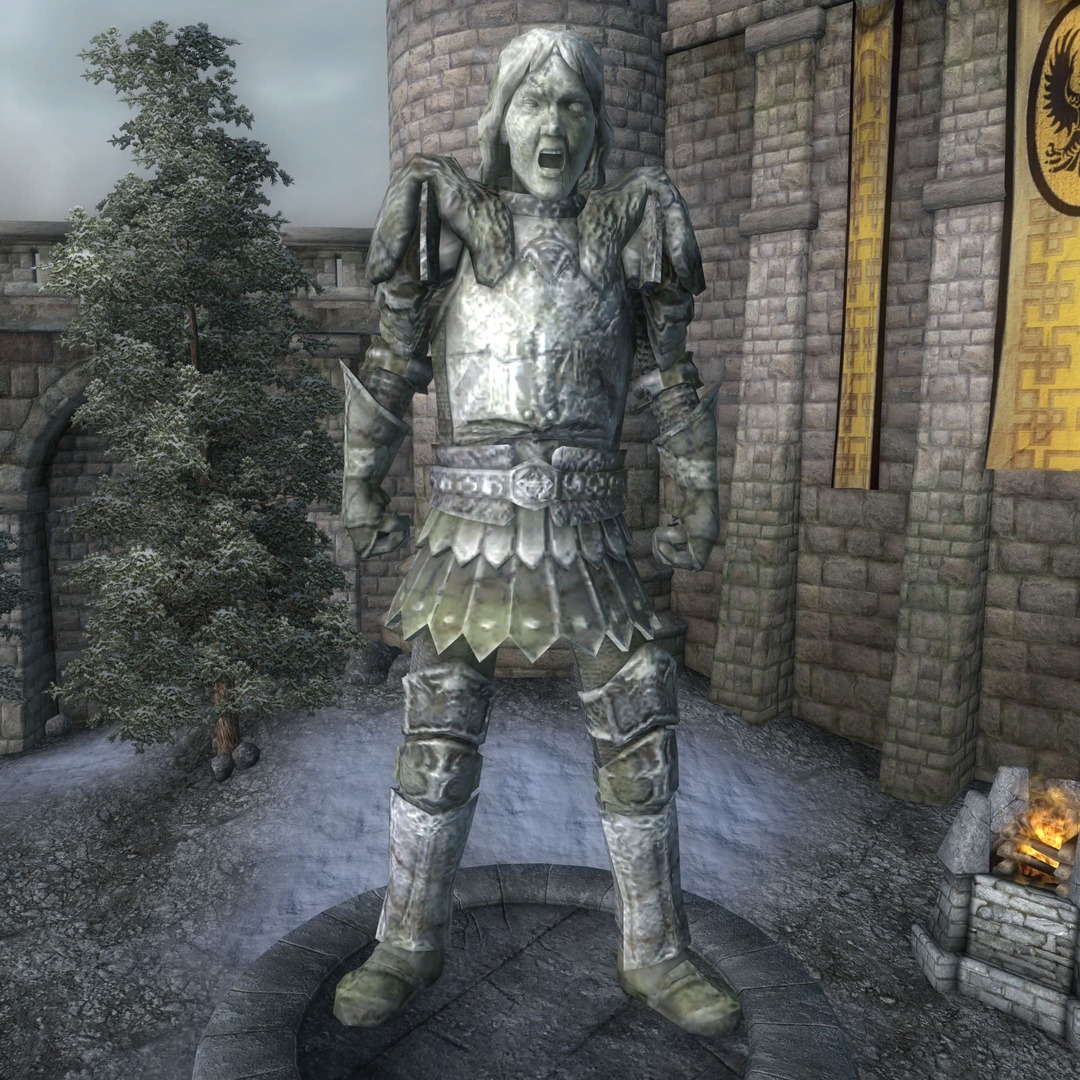 Oblivion Oblivion
|
Dragon Bridge[edit] | |
 ESO ESO
|
 Skyrim Skyrim
|
|---|---|
|
Two large dragon skull figureheads are found back-to-back at the apex of the bridge that crosses into the Nordic town of Dragon Bridge in Skyrim. The ancient and ornate bridge predates the settlement by untold years, and some scholars believe the skulls are in fact petrified skulls of actual dragons, due to the difference in stonework detail between the bridge's stone and the skulls. Other scholars however deride this as "poetic nonsense". Dragon Bridge is symbolic for the Nords and the skulls and bridge have inspired the imaginations of travelers for centuries.[431] It also acts as a crossroads for the northern region, with it being the first line of defense for Solitude and the neighboring holds.[432] | |
Great Statue of Irkngthand[edit] | |
|
Great Statue of Irkngthand in enormous statue of an unknown Snow Elf figure. It was built in the Dwemer city of Irkngthand in ancient times, deep beneath Skyrim. During this time the remnants of the Snow Elf race had been enslaved by the Dwemer, but were able to build this statue in secret. The statue is the only known visual representation of a Snow Elf, before centuries of subterranean slavery twisted the race into the Falmer.[433] In each of its eye sockets was a large priceless jewel, known later as "Eyes of the Snow Elves". [434] Legends grew around the valuable gemstones and some believed that just one of the eyes was worth more than some thieves could earn in a lifetime.[435] In 4E 201, Guildmaster Mercer Frey of the Thieves Guild gained access to the ruins of Irkngthand and attempted to steal the eyes after he betrayed his own comrades, but was stopped by the Last Dragonborn, Karliah and Brynjolf. The eyes were recovered and later put on display in the thieves' guildhall. [436] |
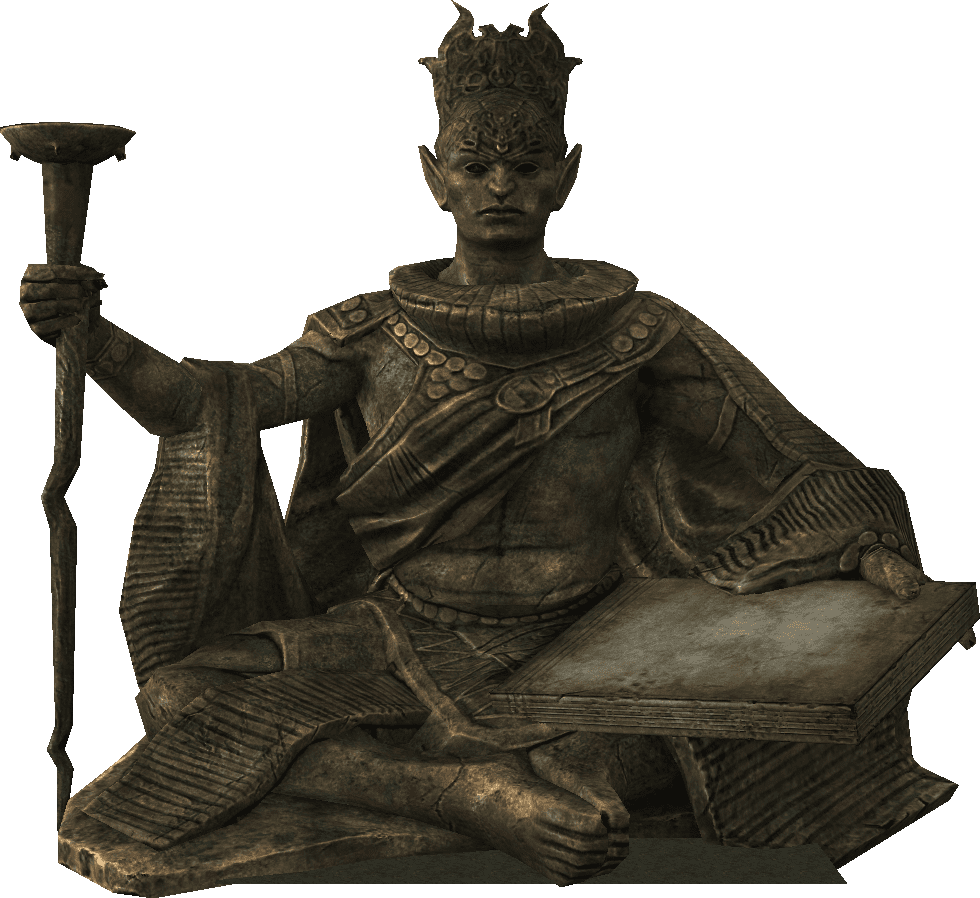 Skyrim Skyrim
|
Leki's Blade[edit] | |
|
According to legend, the enormous statue of a hand holding aloft a broken sword in the middle of the Alik'r Desert dates back to a mythical duel in ancient times. In the early First Era, a great Yokudan Ansei warrior named Rada al-Saran traveled to the surrounding oasis, claiming to match the gods in the way of the sword. Here he met the Yokudan goddess Leki, who had taken the shape of a warrior of sand, wielding a blade of the hardest rock. Some say that Leki herself drew him to the school to challenge and humble him. Rada al-Saran bowed to his opponent, and when it bowed back, he knew found an opponent worthy of his skill. For three days and three nights, they dueled with neither gaining the upper hand. Rada al-Saran was becoming tired from fighting, so in a last-ditch attempt he struck the weak point of Leki's sword. The blade broke in two, and a great sandstorm split the horizon. When it cleared, Leki had miraculously erected a shrine from the sands, and the surrounding oasis was said to have held the purest water in all Alik'r. A training school was later founded beneath the shrine and was open to students until at least the mid-Second Era.[437] |
 ESO ESO
|
Mermaid of Anvil[edit] | |
 ESO ESO
|
 Oblivion Oblivion
|
|---|---|
|
A large statue of a mermaid can be found in Guildgate district in Anvil. With no inscription decorating its base and no certificate of origin stored in the city records, the statue remains a blank canvas upon which locals and visitors alike have painted their own picture. Its known commonly as the Brine Maiden, the Leggy Lass, the Salty Serenader, the Stone Seductress[438] or the Selkie of West Skerry.[439]:353 Legends surrounding its origins are numerous, including some claims that it depicts Azura as she appeared to some ancient sea-dwelling civilization. Archaeological studies indicate that it pre-dates any structure in Anvil, suggesting that the city was possibly built around her.[438] On High Isle, small Ebony mermaid figurines were a common fertility idol among commoners.[440] | |
The Sentinel[edit] | |
|
The Sentinel is an ancient statue found northeast of Bruma in Cyrodiil. It is unknown who built the large statue that faces north towards Skyrim. Earliest known accounts appear in Akaviri reports during their invasion in 1E 2703, when it was used by them as a waypoint to find the path to their hidden base in Pale Pass.[441] The Sentinel was once more used as a waypoint by the Hero of Kvatch to recover the Draconian Madstone from Fort Pale Pass.[442] |
 Oblivion Oblivion
|
The Skyforge[edit] | |
|
Above the Skyforge sits an ancient statue of a hawk or eagle overlooking the city of Whiterun. According to Nordic myth, it dates back to the Merethic Era when the Atmorans first settled Skyrim. It was discovered when the crew of Jorrvaskr arrived on the plains of Whiterun Hold. The band's elven captives looked at the statue with fear and claimed that it predated the elven habitation of Skyrim. They didn't know who built it, but it was known to drive a magic almost as old as Nirn itself, described as some remnant of the gods' efforts to render a paradise in Mundus before the shattering of Lorkhan.[443] |
 Skyrim Skyrim
|
Standing Stones[edit] | |
|
Throughout the wilderness of Tamriel lie various types of standing stones, stones of power which are often attuned to the heavens. The origins of these stones are a mystery for the most part, but they have been known to grant great power to those deemed worthy enough. |
 Skyrim Skyrim
|
Ten Ancestors[edit] | |
|
The Ten Ancestors are a set of ten Ayleid statues. They consist mostly of meteoric iron prongs, with a shard of meteoric glass in the center. The statues played an important role in Ayleid religion and were displayed in the Temple of the Ancestors, now known as the White-Gold Tower.[444] During the Alessian Slave Rebellion, the Ancestors were dispersed to cities across Cyrodiil for safekeeping. Following the sacking of White-Gold and the Ayleid exodus of Cyrodiil, the statues were left behind and forgotten.[444] In 3E 433, an Altmer nobleman called Umbacano paid the Hero of Kvatch to hunt down the Ten Ancestors so that he could add them to his collection of Ayleid antiquities. He then put them on display in his private manor in the Imperial City, before his untimely death that same year while exploring the ruins of Nenalata.[445] |
 Oblivion Oblivion
|
Weeping Giant[edit] | |
|
The Weeping Giant is an enormous ruined statue head found in eastern Stormhaven. Seemingly carved from the mountain itself, it is unknown when it was built or by whom. During the mid-Second Era a shrine to Azura was built nearby and the area around the statue was inhabited by the Supernal Dreamers, a cult of Vaermina worshippers.[446] When the Staff of Towers was drawn back to Tamriel, it shattered and the pieces scattered across the continent. One such fragment was found atop the statue and recovered by the Psijiic Order.[447] Curiously, a similar, upright statue head was built on the other side of the Tamriel, at the summit of Direfrost Keep in Skyrim.[448] |
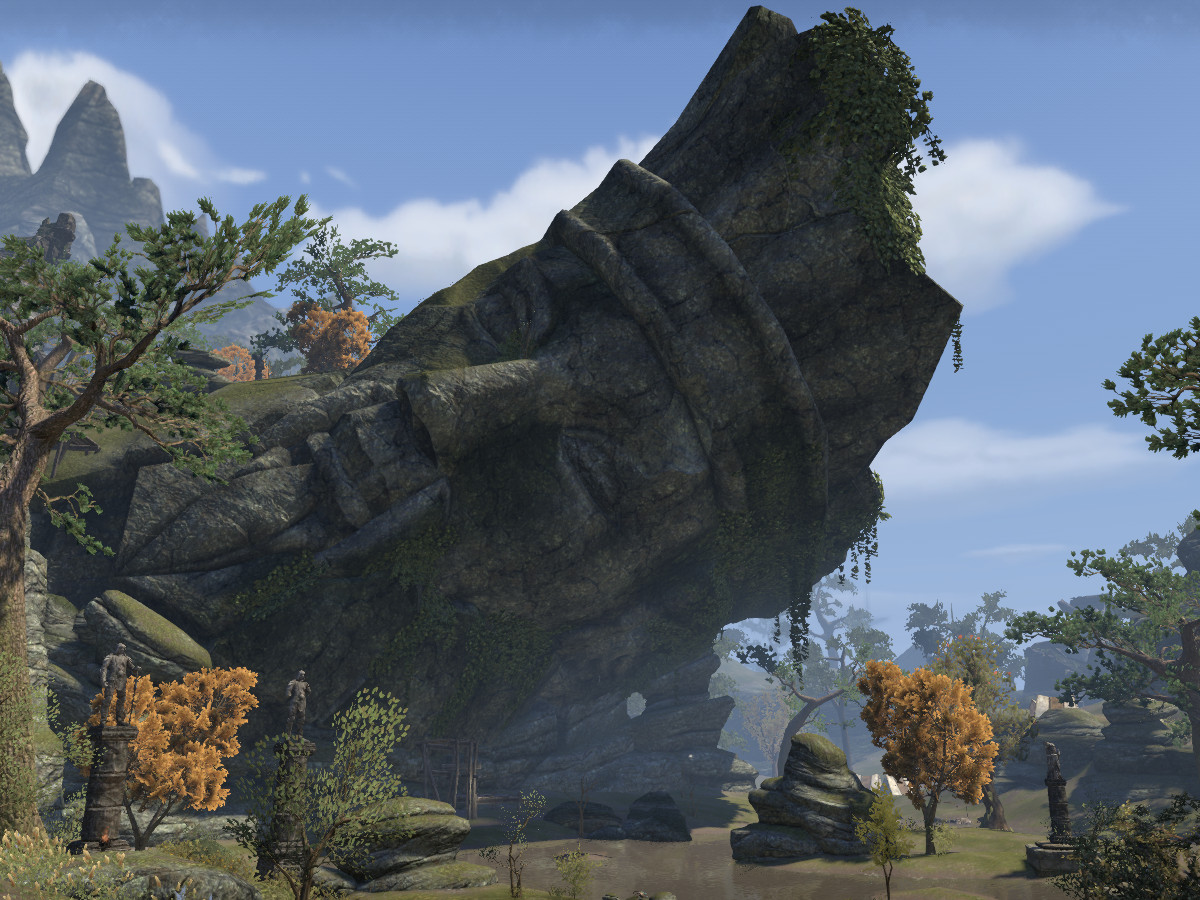 ESO ESO
|
Generic Statues[edit]
These are statues that are solely decorative or are of unconfirmed persons but are included here for completeness and to illustrate the wide variety across cultures and time.
Yokudan and Redguard[edit]
Ancient Yokudan and Redguard statuary in Hammerfell are almost synonymous, largely due to the strong cultural influence of Yokuda that survived its fall. All known statuary in Hammerfell dates back to the First Era, and was built shortly after the arrival of the Yokudans in 1E 808. Examples include the various statues found in the lost city of Na Totambu, Al Danobia tomb or Ash'abah Pass. The Yokudans, in an effort to recreate the culture of Yokuda on Hammerfell, built their statuary in the same fashion as that which would have been found on Yokuda.[449] Once the Yokudans came to be known as Redguards decades later, the style of their statuary remained largely the same until at least the Siege of Orsinium in 1E 950, as evinced by the various statuary found in Honor's Rest.[450]
According to historians, it's rare to find Yokudan statuary that isn't wielding a sword.[202] Examples include statues of the numerous Ansei warriors, such as Makela Leki, some of which are performing ancient sword techniques.[451][452] During the Ra Gada conquests in the early First Era, sculptors rarely took the time to render softer details in their work. In addition, Yokudan statuary normally featured a metallic element, such as orichalc.[202] Some ancient orichalc statues were known to depict Diagna, God of the Sideways Blade, holding a severed head.[453] Others sculptures were modeled after the house idols that were popular with the Yokudan people,[454] or notable Sword-Singers in the history of the Alik'r.[455] The Ra Gada were believed to have upheld the tradition of entombing their dead alongside gilded funerary statues of various animals, such as the cat or ibis (which itself was associated with Tu'whacca).[238]
The Yokudans also mastered a unique alchemical technique that could turn living beings into stone. This was discovered during the mid-Second Era, when Lady Clarisse Laurent began studying the gargoyle statues of Bangkorai. She found that the Yokudans, inspired by these gargoyles, had experimented with their own flesh and bone to create a "stoneflesh" potion that could turn them into stone. It was also discovered the Yokudans invented a potion that could reverse the effects, brewed using the tongue of a living gargoyle.[456][457] Many of these resulting statues could be found in various ancient Yokudan ruins, such as Kardala, Unhallowed Grave or Al-Danobia Tomb. These statues would serve as sentries, and could suddenly come to life and fight off any invaders or tomb robbers.[458]
The following examples include statuary that was built in Hammerfell shortly after the Ra Gada's conquest:
Hel Ra Citadel, Craglorn (ESO)
Sunken Road bas relief, Bangkorai (ESO)
Al-Danobia Tomb bas relief, Taneth (ESO)
Yokudan statue at the Hall of Heroes, Bangkorai (ESO)
Yokudan statue in the Ruins of Kardala, Craglorn (ESO)
The Keeper of the Kiln statue which defends the Kiln in the Unhallowed Grave, Bangkorai (ESO)
Ansei Ward statue, Alik'r Desert (ESO)
Redguard lion statue in Honor's Rest, Wrothgar (ESO)
Nordic[edit]
Much of the statuary found in Skyrim dates back to the Merethic and First Era, and is found mostly in Nordic tombs or ancient temples. These statues largely depict Nordic heroes or animals who represent their ancient pantheon of gods. After the fall of the Dragon Cult, some Nords continued to worship Alduin in secret as evinced by the existence of numerous jewel-encrusted Dragon carvings found during the mid-Second Era.[459] In a tradition shared with Orcs, some Nords kept tiny trunk guardian statues, believing they would protect their stored goods.[460]
According to legend, a statue of a wolf has sat outside Fallowstone Hall for longer than anyone can remember.[461]
In Riften during the mid-Second Era, a statue of Vithon Battlewolf and his battlewolf could be found near the Fighters Guild.[462]
"Visage of the Skald", a depiction of a high-ranking bard of Skyrim.[463]
An ebony fox totem, possibly associated with Shor (ESO)
A stone carving of a hawk in Riften which represents Kyne (ESO)
A stone carving of a flower which represents Dibella (ESO)
Ancient Nordic carving and runes in Riften, circa 2E 582 (ESO)
Ancient Nordic carving in Riften, circa 2E 582 (ESO)
Orcish[edit]
Given that Orsinium has been razed and rebuilt numerous times, much of their ancient statuary has either been destroyed or forgotten. Almost all known Orcish statuary that survived dates back to around the time of the first Orsinium in the First Era and could be found around the Wrothgar region. This included statues, bas-reliefs, and various sculptures. Of note was the ancient clans who built Orsinium and carved their seals into blocks of stone that would be used as decoration around the ancient city.[464]
When Orsinium was rebuilt during the mid-Second Era, some of the ancient forms of statuary was revived and recreated, alongside contemporary statuary. Busts of prominent rulers, such as King Golkaar and Kurog, crafted from orichalc and alabaster were found during this time.[465][466] In the Third Era, Gortwog gro-Nagorm graced the newly founded city of Nova Orsinium with iron statues of Orc heroes including Mauloch and Torug gro-Igron.[467] Some examples of less prominent statuary included finely crafted wooden fertility totems that depicted a pregnant Orc holding a large acorn.[468] According to Wrothgar tradition, tiny trunk guardian statues were kept by some Orcs, who believed they would protect their stored goods.[469]
A Trinimac house idol depicting a mammoth, placed inside homes to provide protection, comfort, and a focal point for private worship.[232]
The seal of Clan Igrun depicts three towers to symbolize them as the fearless leaders of Orsinium.[471]
The seal of Clan Bagrakh depicts a clenched fist, however its unknown what this symbolizes.
The seal of Clan Shatul depicts a stylized echatere head to symbolize their skill as the peerless hunters who fed Orsinium.[471]
The seal of Clan Fharun depicts an Orc, however its unknown what this symbolizes.
The seal of Clan Morkul depicts an anvil to symbolize their unrivalled skill as blacksmiths.[471]
The seal of Clan Tumnosh depicts crossed pick-axes to symbolize their skill as the great builders of Orsinium.[471]
Argonian[edit]
Almost all Argonian statuary and stone-carvings date back to the pre-Duskfall era. They heavily feature serpent imagery and are typically blockier and more abstract than those of other cultures. According to some scholars, ancient Argonian statuary often carries vaguely malignant power within, possibly as a result of their veneration of Sithis.[472] Other more mundane statuary found near Argonian ruins includes depictions of a crouching Argonian holding a stylized turtle.[473]
A pre-Duskfall, possible depiction of Sithis.[472]
An ancient Argonian sculpture depicting an endless struggle between two fang-baring serpents.[474]
A Murkmire hearth shrine dedicated to Sithis.[414]
A decorative stele depicting Hist cultivation[476]
A decorative stele depicting guardians of the Hist [477]
Altmeri[edit]
Altmeri statuary found across the Summerset Isles is often created from white marble, much like their architecture. They often depict various figures or heroes from their history, including members of the royal family.[478]. Although the Altmer maintain some of their most ancient statues represent their honored ancestors, some scholars insist they're of Ayleid design.[479]. The gryphon and eagle are common motifs used in their statuary and can be found in their most ancient artwork. For the Altmer, the high-soaring eagle represents their ancestors the Aedra, who they believe came from the heavens and were trapped in physical form by the creation of Nirn.[169] Hearkening back to the Altmer's ancient roots, gleaming platinum statuettes depicting the Old Ehlnofey were common during the mid-Second Era, appearing vaguely Elven in shape, but featureless.[480]
Kinlord statue in Rinmawen's Plaza, Alinor (ESO)
Altmer warrior statue in Mathiisen (ESO)
Altmer mage statue in Shimmerene (ESO)
An ancient Altmeri statue in Vulkhel Guard, which some scholars insist is of Ayleid design.[479]
Altmeri eagle figurehead on the Dread Halcyon (ESO)
The Keepers Oath in Direnni Acropolis (ESO)
Druidic[edit]
Druidic statuary is largely found across the Systres archipelago, dating back to at least the mid-Second Era. According to some scholars, stone held importance in druid culture given it was no less natural than trees, but what's unique was the druid belief in their master stonecutters' ability to enhance or perfect nature. Some of the sculptures bear religious significance to the various Druid circles native to the isles and are tended to by them. Megaliths (also known as "storystones") depict major figures in their ruling council, the Draoife, mark major events, or even serve as stargazing tools.[481]
Notable is the skillfully crafted Druidic stonework at the entrance of Clohaigh. Faces depicted on the stone conveyed a message of respect for all possible outcomes and reactions. Multiple faces were depicted on the statue, one with an angry expression and the other with a genuine smile, although the sinister look in its eyes gave an impression of danger. It was known that locals left offerings by the statue and it was speculated that the offerings left at the angry face were meant for someone who was in serious danger.[482] Carvings within the cavern portrayed several scenes in the ancient druidic style on a number of pillars, including Frii cultivating the sacred seeds to create the king's regalia and the crowning of the new Druid King.[483][484][485]
The Firesong Circle's statuary reflects their reverence for Mount Firesong, the active volcano that towers above Y'ffelon. Many of their sculptures are built from dark, igneous rocks and are much more abstract in nature when compared to statuary of other Druid circles.[486]
A druidic statue gestures to the left, inviting the viewer to be wise in their workings, centered in their teachings.[487]
A druidic statue gestures to the right, inviting the viewer to be skillful in their workings, compassionate to others.[488]
An Eldertide Circle altar at Tuinh (ESO)
Druidic statue of a Chimera (ESO)
A Firesong Circle sculpture named "Arch" (ESO)
Dwemeri[edit]
Although the entire Dwemer disappeared after the Battle of Red Mountain, much of their metallic statuary remained well intact as centuries passed, possibly due to the unique properties of Dwarven Metal or a preservative effect which denied or controlled the nature of time and decay.[489]
A frieze depicting a Wrathstone fragment, kept by the Dwemer of Kagrenzel (ESO)
Khajiiti[edit]
Statues depicting various furstocks of Khajiit were on display in Sunspire Temple during the mid-Second Era. Other statuary could be found across Elsweyr, primarily in religious sites. Golden idols fashioned in the likeness of Rid-Thar-ri'Datta, the first Mane of the Khajiit, could also be found during this time.[490] Idols of the trickster-god Rajhin were also common, and were said to always find their way into the pouches of a thieves as a means to honor him.[491] Other idols of him were used to ward away thieves when its belly was regularly rubbed.[492]
A Bas-relief of an unspecified Lunar Champion at the Shrine of Alkosh near Rimmen, Elsweyr (ESO)
A golden statue of Yolnahkriin, one of Nahviintaas' minions, perched on an hourglass.[494]
A silver statue of Lokkestiiz, one of Nahviintaas' minions, found in Sunspire Temple, Elsweyr.[495]
A stylized Senche-Cat guardian statue found watching over shrines throughout Reaper's March.[496]
"Four Lions" fountain sculpture in Elsweyr.[497]
Ayleid[edit]
Ayleid statuary can be found in many of their ruined cities in Cyrodiil and beyond. Auri-El was frequently depicted in statues as a knight, holding either his bow or a sword and shield. Behind him is a large eagle with its wings outstretched.[498] According to some scholars, the Ayleids were the masters of enchanting statues with magical effects, such as the ability to reanimate at will, or trap a person's spirit inside them. Knowledge of this ancient technique was lost to the ages, except for one enchanter known as Martin Gavinius, who was able to create animated guardian statues to protect him during the early-Fourth Era.[499][500][424]
An Ayleid guardian statue that serves as a sentry in the Hall of Epochs (Oblivion)
An Ayleid stone guardian statue that guards the path through the Doomcrag (ESO)
An Ayleid stone guardian statue that guards the path through the Doomcrag (ESO)
An Ayleid stone watcher statue found in the Depths of Malatar (ESO)
Imperial[edit]
While some of the statuary shown here has been used to represent historical figures, other times they are used for purely decorative purposes in Imperial tombs and places of significance.
A statue of a robed figure holding a sword in the tomb of Reman III (Oblivion)
Ancient bas-reliefs of a procession, found on the pillars in Wind Scour Temple (ESO)
Bretonic[edit]
Breton statuary across High Rock was primarily associated with their knightly orders or religion during the mid-Second Era, and on occasion the two were overlapped to some extent. Many of these statues can be dated back to around the mid-First Era, such as numerous statues depicting the Knights of Saint Pelin.
Noble Knight's Rest: A late-First Era sarcophagus possibly belonging to a knight of one of the pretender-kings from House Moorcroft that took power after the Alessian secession.[501]
Breton Gravewatcher: These enormous statues were originally commissioned to watch over the dead in Cath Bedraud cemetery in Glenumbra.[502]
A Knight of St. Pelin statue damaged in Septima Tharn's assault on Bangkorai Garrison.[503]
A statue of Saint Stental in Stormhaven
Dunmeri[edit]
Dunmeri statuary covers a wide variety of subject matter, from the mundane to their greatest heroes and historical figures. Members of the Great Houses are known to keep traditional statuettes of their ancestors, whom they venerate, and are sometimes kept in their sacred temples.[504][505] Some of the roles and figures found in their society are depicted in sculpture, such as Temple Ordinators, knights and magisters.[506][507] Other examples include statues of creatures native to Morrowind, such as the guar or cliff-racer.[508][509] During the mid-Second Era, the sculptor Nerile was known to produce a limited series of ebony statues depicting the Brave Little Scrib, hero of a traditional Dunmer fairy tale.[510][511]
Two scholarly statues at Shad Astula in Deshaan serve not only as decorative elements, but also as foci for lessons, allowing students to study the magical energies of the five schools of magic.[512]
Gargoyle[edit]
Gargoyle statuary is primarily associated with vampires, where they are used as decorative sculptures in their castles and lairs, but on occasion can come to life and attack any trespassers.[513] Bretons, Direnni, Yokudans, Imperials, Ayleids, and Khajiit were also known to use gargoyle statues as sentinels.[514] Its generally understood that gargoyles are actually creatures that can take on the form of a statue at will, however craftsmen have also been known to create inanimate gargoyle statuary to sell or export. Curiously, such statuary has been known to attract the attention of live gargoyles, possibly in an amorous capacity.[515]
Gargoyle statuary delivered to Cyrodiil by Imperial Importers, Purveyors of Exotica [515]
Nedic (Duraki)[edit]
Although the Duraki Nedes of Craglorn were exterminated in the First Era, much of their statuary and crafts survived into at least the mid-Second Era. These examples were often associated with their mythology and could be found in the ruins of their temples and tombs across Craglorn.[516][517] One example includes a figurine depicting a coiled snake, possibly alluding to the Mother Serpent.[518]
A bas-relief door depicting three of the Four Parents from Nedic mythology: the Ox, the great Dragon of Time and the Mother Serpent.
An Altar of Celestial Convergence, speculated to channel aetherial energy through it.[519]
Maormeri[edit]
All known examples of Maormer statuary and sculptures feature the Sea Serpent in some form. Depictions of these terrifying Pyandonean creatures are also known to adorn their vessels, shrines, weapons, and armor, and are even used in their mysterious Snake Magic practices.[520][521]
The Maormer used storm totems to collect spirit energies from rune-marked subjects and channel it into a ritual that could create destructive tempests.[522]
A Maormeri Serpent Shrine uncovered in the mid-Second Era by the Antiquarian Circle in Auridon.[523]
Maormeri sea serpent figurehead on the Serpent's Kiss (ESO)
Bosmeri[edit]
Traditional statuary is almost non-existent in Bosmeri culture. Instead of carving statues from stone, the Bosmer create artwork using nature itself.[524] One example can be seen in Deepwoods village in Malabal Tor, where a shrine depicting the Green Lady is fused with a living tree sprouting from the earth.[525] Exaggerated jade fertility statuettes of the Green Lady can also be found at her shrines.[526] Other minor examples include camp guardians, tiny effigies made of sticks and twigs that the Bosmer bless to Y'ffre and place them in their camps for protection.[527]
Handfast shrine (ESO)
Reachmen[edit]
Reachmen statuary is relatively uncommon, and the most prominent statues depict Hircine in the aspect of Alrabeg - his most malevolent form. These statues served as shrines and altars and played a part in Reachman hunting rituals.[108] A notable example of this is in the Shrine of the Hunt-Father in Markarth, where a large statue of Hircine was erected during the mid-Second Era.[297] Other forms of their statuary sometimes depict Hagravens, the matriarchal witches who lead Reachmen clans.[528] Examples include a stone carving of a Hagraven with a distended belly, possibly representing fertility or engorging on small children.[529] Reachmen were also known to carve primitive totems made of skulls and bones to mark their territory and strike fear into the unwary or foolish.[108]
A Reachman bas-relief depicting Durcorach conquests as his Reachmen army marches on the Imperial City.[30]
An obelisk engraved with a triskelion (ESO)
Akaviri[edit]
Akaviri statuary and bas-reliefs are exceeding rare on mainland Tamriel, despite the great influence they had on Imperial culture during the Second Empire.[530] Alduin's Wall, found within Sky Haven Temple, was considered to be one of the best-preserved examples of early Akaviri sculptural relief, as well as a wonder of the ancient world. Although Akaviri in origin, craftsmen were said to have incorporated the flowing Nordic style into its design.[418] The Dragonguard often used stone tablets or pillars carved with glyphs to unlock the entrances of ancient Dragonguard temples.[33][419] The Glyph of Bones was sometimes used to mark dragon mounds in Skyrim.[531]
Akaviri symbol for Dragonborn in Sky Haven Temple
Apocrypha Statues[edit]
In Hermaeus Mora's realm of Apocrypha, statuary can be found depicting the various Daedric creatures native to his plane of Oblivion. These include grotesque statues of Lurkers, Seekers and Watchers. Some of these statues can also be found on Nirn, most notably in Miraak's Temple on Solstheim.
Decorative Statues[edit]
"Vampiric Sovereign" statue (ESO)
"Kaalgrontiid's Ascent" statue (ESO)
The entrance to Bliss in New Sheoth (Shivering Isles)
A Scalon statue in the Fringe (Shivering Isles)
A figurehead of a Sload aboard the Dainty Sload (Skyrim)
A guar ice sculpture (ESO)
A mudcrab ice sculpture (ESO)
A vvardvark ice sculpture (ESO)
A dragon ice sculpture (Blades)
A unicorn ice sculpture (Blades)
A gilded Fighters' Trophy representing the spirit of victory (Blades)
Notes[edit]
- ^ Morihaus was first introduced into the lore with the release of TES3: Morrowind, where he is described in Varieties of Faith... as an "Ancient cultural hero god of the Cyro-Nordics", but his race was undefined. In TES4: Oblivion he was described in Shezarr and the Divines as a "demigod" and "Morihaus-Breath-of-Kyne" and appeared human (based on the statue in the Arena District). It was only when the Oblivion add-on, Knights of the Nine, was released that his race was retroactively changed to a bull-man. This is noted in The Adabal-a and The Song of Pelinal where he is described as a "winged-bull" and "bull nephew". Due to this inconsistency, Kurt Kuhlmann and Michael Kirkbride joked that the statue would need to be retconned in the future.[UOL 1]
- ^ The book Knightsgrave: Legend or Legacy presents an inconsistency with the placement of these statues. It mentions that when the original founders of the order (Ennon Decan and his group of companions) died, great statues were raised in memory of the founders. This is also mentioned by the Black Dragon, who writes in her journal: "I admired the statues on the stairs that descended into these ruins. The founders of the Order of the Hour were great and faithful warriors.".
The inconsistency is that this book conflicts with what is presented in-game. When you visit Knightsgrave, four statues are indeed found on the stairs and main chamber, but instead of statues dedicated to Ennon Decan and his group (the original founders), we see statues dedicated to Cavor Merula and his group (the second founders). This is further complicated because although Cavor Merula re-established the Order, this book mentions he did not wish to use the 500-year-old crypts of Knightsgrave as a headquarters so as not to disturb the dead. He blessed the area, raised guardians, and left to build the Enclave of the Hourglass, which makes the existence of these statues (and associated brazier locks) somewhat of a paradox. - ^ The appearance of this statue can vary and is determined (and spawns) the moment you enter a new cell occupied by Martin after the Bruma great gate quest. This will usually be when you return to Cloud Ruler Temple, but it can happen on the road to it if you intercept him along the way. The armor and weapon on the statue will reflect the best quality items that you had in your inventory at the time, not necessarily the items that you had equipped. The game takes into account not just the value, but armor protection and enchantments.
- ^ A Dreughsider NPC mistakenly refers to this statue as King Joile during the quest They Dragged Him Away.
- ^ In TES:V: Skyrim, the hawk bas-relief that represents Kyne is typically found in Nordic ruins, however in once instance its found in Rebel's Cairn, the tomb of Red Eagle. The association of this bas-relief with Red Eagle is somewhat of a paradox, given Red Eagle was a Reachman from the First Era who didn't have any known association with the ancient Nordic deity. The likely explanation is that this bas-relief was re-used by the game's designers to decorate Red Eagle's tomb with eagle-like imagery, given the similarities between the hawk and the eagle.
- ^ In TES:V: Skyrim, the wolf bas-relief that represents Mara is typically found in Nordic ruins, however in once instance its found in Potema's Catacombs beneath Solitude. Connecting this bas-relief with Potema the Wolf-Queen is somewhat of a paradox, given she was from the Third Era and didn't have any known association with the ancient Nordic deity. The likely explanation is that this bas-relief was re-used by the game's designers to decorate the Wolf-Queen's catacombs with existing wolf-like imagery.
- ^ Stendarr's chalice/horn bears striking similarities to the Horn of Plenty - a large horn-shaped container overflowing with produce, flowers, or nuts. In Greek and Roman mythology it was a symbol of abundance and nourishment and was attributed to several deities associated with the harvest and prosperity.
- ^ This statue of Boethia could also be found in Knife Ear Grotto, a Daedric ruin in eastern Deshaan, but it was removed at some point in 2016 after an update for reasons unknown.
- ^ The Improved Emperor’s Guide to Tamriel claims this statue represents Unnvald Ironhand holding his axe, Bonebane - however Bonebane appears a two-handed sword in-game.
References[edit]
- ^ St. Alessia, Paravant antiquity codex entry in ESO
- ^ The Elder Scrolls IV: Oblivion Official Game Guide — Peter Olafson — "Statue of Queen Alessia: First ruler of the Cyrodiilic Empire and Founder of the Nine Divines"
- ^ a b c d e f g Appearance of statue in Oblivion
- ^ Shan-ra's dialogue in ESO
- ^ Flipping the Coin quest in ESO
- ^ a b Loading Screen in Oblivion
- ^ Kvatch's layout in ESO and Oblivion
- ^ The Refugees — Geros Albreigh
- ^ Online:Narsis Dren's dialogue in ESO
- ^ Draugr Dilemma quest in ESO
- ^ Lord Trystan's dialogue in ESO
- ^ a b The Ashes of Our Fathers quest in ESO
- ^ Lozruth's dialogue in ESO
- ^ a b The Colossus of Gonfalon Bay — Miramel Charascel, Chairperson of the Gonfalon Bay Historical and Social Society
- ^ Head of Brazzefk — Merethic Society
- ^ Statue of Sir Byric
- ^ Knights of the Flame Pup description in ESO
- ^ Aleris the Shroud
- ^ Crow Bringer
- ^ Hagrof the Righteous
- ^ The Thousand Arrows
- ^ Lucius the Stalwart
- ^ Whitebear
- ^ Ferian Darkstorm
- ^ Felhorn
- ^ Sanarel the Great
- ^ The Lava Queen
- ^ King's Sepulcher description in Blades
- ^ a b Bas-relief in Black Drake Villa
- ^ Grandmaster Ettiene Volusus
- ^ a b c Sai Sahan's dialogue in ESO
- ^ a b c d e The Dragonguard's Legacy quest in ESO
- ^ Trithik's dialogue in Redguard
- ^ Talisman of Hunding in Redguard
- ^ Grandmaster Ghelin-Brol
- ^ The Litany of Larceny quest in Skyrim
- ^ Hubalajad's Reflection in ESO: Thieves Guild
- ^ a b Lady in the Cistern: Zeira's Theory — Zeira
- ^ In Defense of Prince Hubalajad — Lady Cinnabar of Taneth
- ^ a b The Tomb of Ja'darri
- ^ Pridehome: A Place Outside Time? — Kaalaleth of the Mages Guild
- ^ Ja'darri's dialogue during The Dragonguard in ESO: Dragonhold
- ^ Nahfahlaar's dialogue in ESO: Dragonhold
- ^ Moon-Priest Nuziwa's dialogue in ESO: Dragonhold
- ^ Ja'darri the Endless
- ^ Grandmaster Jaiv-Yora
- ^ Appearance of statue in Skyrim
- ^ Brief History of the Empire v 2 — Stronach k'Thojj III
- ^ Kaalgrontiid's dialogue in ESO: Elsweyr
- ^ Cadwell's dialogue in ESO: Elsweyr
- ^ Khamira's dialogue in ESO: Elsweyr
- ^ Events of ESO: Elsweyr
- ^ Systres History: Volume 4 — Trilam Heladren, Associate Dean of Eltheric History, University of Gwylim
- ^ a b Golden Idol of Morihaus antiquity codex entry in ESO
- ^ Golden Morihaus Statuette treasure item in ESO
- ^ a b The Truth of Minotaurs — Tyronius Liore, Scholar of Imperial Antiquities
- ^ The Song of Pelinal, v 5
- ^ The Prophet's dialogue in Oblivion
- ^ On Minotaurs — Nonus Caprenius, Temporarily Unaffiliated Scholar of Imperial Antiquities
- ^ Belharza's Band antiquity codex entries in ESO
- ^ The Elder Scrolls IV: Oblivion Official Game Guide — Peter Olafson — "Statue of Pit Fighter Morihaus: Morihaus led St. Alessia's armies in the taking of the White Gold Tower and the overthrow of the Ayleid Hegemonies."
- ^ a b Ashaka's dialogue in ESO
- ^ Baloth Bloodtusk
- ^ Mazghar Many-Tongues
- ^ Lakora of the Hunt
- ^ Kinlord Nemfarion's dialogue in ESO: Summerset
- ^ Wasting Away quest in ESO: Summerset
- ^ a b The Black Dragon's Journal, Part 2 — The Black Dragon
- ^ Knightsgrave: Legend or Legacy — Chanter Wobolan, Cathedral Historian
- ^ Statue of Cavor Merula
- ^ Statue of Justia Desticus
- ^ Statue of Rusio Olo
- ^ Statue of Amminus Entius
- ^ The Elder Scrolls IV: Oblivion Official Game Guide — Peter Olafson — "Pelagius IV: Son of Tiber Septim"
- ^ Brief History of the Empire — Stronach k'Thojj III, Imperial Historian
- ^ Brief History of the Empire — Stronach k'Thojj III
- ^ Brief History of the Empire v 4 — Stronach k'Thojj III
- ^ The Elder Scrolls V: Skyrim: Prima Official Game Guide — David Hodgson — "The ancient Blades revered Reman Cyrodiil, and the whole place appears to be a shrine to him....You cut your palm, dripping blood into the floor seal, and Reman Cyrodiil’s giant carved head lifts open."
- ^ a b Alduin's Wall quest in Skyrim
- ^ The Elder Scrolls IV: Oblivion Official Game Guide — Peter Olafson — "Statue of King Rislav Larich: Rislav the Righteous on his horse with his hawk on his hand."
- ^ Rislav The Righteous — Sinjin
- ^ Chronicles of the Five Companions 5 — Abnur Tharn
- ^ The Oblivion Crisis — Praxis Sarcorum, Imperial Historian
- ^ Great Gate quest in Oblivion
- ^ The Elder Scrolls V: Skyrim: Prima Official Game Guide — David Hodgson
- ^ A Minor Maze
- ^ Pocket Guide to the Empire, 1st Edition: Hammerfell — Imperial Geographical Society, 2E 864
- ^ Pocket Guide to the Empire, 3rd Edition: The Ra Gada: Hammerfell — Imperial Geographical Society, 3E 432
- ^ Introduction of Redguard
- ^ The Elder Scrolls IV: Oblivion Official Game Guide — Peter Olafson — "Statue of Torval the Pilot: The First Era High Elf explorer who charted the sea lanes around Tamriel and who discovered the River Niben."
- ^ Father Of The Niben — Florin Jaliil
- ^ Decentius Opsius' dialogue in Oblivion
- ^ The Elder Scrolls IV: Oblivion Official Game Guide — Peter Olafson — "Statue of Uriel Septim III:Commemorating Uriel III's victory in the War of the Red Diamond."
- ^ The mural in Valentis' tomb during A Tale of Two Brothers in Blades
- ^ Shulkunaak's dialogue in Blades
- ^ a b c Saashi's dialogue in Blades
- ^ Founder's Statue description in Blades
- ^ Telarendil's dialogue in Blades
- ^ Junius the Elder's dialogue in Blades
- ^ Wrath of the Sorcerer-King quest in Blades
- ^ The Elder Scrolls IV: Oblivion Official Game Guide — Peter Olafson — "Statue of Galerion the Mystic: Founder of the Mages Guild."
- ^ Galerion the Mystic — Asgrim Kolsgreg
- ^ Grandmaster Vashu-Pir Effigy quest item description in ESO
- ^ Grandmaster Vashu-Pir
- ^ The Viridian Sentinel
- ^ The Will of the Woods quest in ESO
- ^ a b c d The Improved Emperor's Guide to Tamriel: Northern Bangkorai and the Mountains — Flaccus Terentius, 2E 581
- ^ Fallowstone Hall loading screen in ESO
- ^ Vigrod Wraithbane's dialogue in ESO
- ^ Storming the Hall quest in ESO
- ^ The Rift questline in ESO
- ^ Thallik's Orders — Thallik Wormfather
- ^ Glory of the Dead quest in Skyrim
- ^ Ysgramor Statue furnishing in ESO
- ^ Sacred Chalice of Ysgramor antiquity codex entries in ESO
- ^ Hymn of Five-Hundred Axes music box in ESO
- ^ Triptych of the Triune furnishing in ESO
- ^ Appearance of the Ghostfence in Morrowind
- ^ Almalexia Figurine treasure item ESO
- ^ Mother Morrowind Fertility Fetish treasure item ESO
- ^ 2920, Sun's Dusk — Carlovac Townway
- ^ Elder Othreloth's dialogue in Skyrim
- ^ Ghosts of the Tribunal Creation Club add-on for Skyrim
- ^ Fresco in Morrowind
- ^ Sotha Sil Figurine treasure item in ESO
- ^ Votive Statue of Seht treasure item in ESO
- ^ Sotha Sil Statuette of Dwarven Metal treasure item in ESO
- ^ Appearance of statue in Clockwork City in ESO
- ^ Plaque inscription during The Pilgrim's Path quest in ESO
- ^ The location of the statue in Morrowind
- ^ a b The location of the statue in ESO
- ^ The location of the statue in ESO: Necrom
- ^ Statuette: Vivec's Triumph description in ESO
- ^ a b 36 Lessons of Vivec, Sermon 34 — Vivec
- ^ 36 Lessons of Vivec, Sermon 12 — Vivec
- ^ The Prior's Fulcrum — Abbot Ilvel
- ^ Lives of the Saints — Tribunal Temple
- ^ Saints' Mercy quest in ESO: Clockwork City
- ^ Evaluation of Saint Felms — Alienist Llandras
- ^ Evaluation of Saint Llothis — Alienist Llandras
- ^ Alienist Llandras's dialogue during Saints' Mercy in ESO: Clockwork City
- ^ Traveler's Guide to Leyawiin — Astinia Isauricus; published 1 Frost Fall, 2E 569
- ^ a b Sir Ralvas' dialogue in Knights of the Nine
- ^ Carodus Oholin's dialogue in Knights of the Nine
- ^ Leyawiin's layout in Oblivion
- ^ a b St. Nerevar, Moon-and-Star antiquity codex entries in ESO
- ^ Guide to Chorrol — Alessia Ottus
- ^ Battle of Sancre Tor
- ^ The Elder Scrolls IV: Oblivion Official Game Guide — Peter Olafson — "Statue—The Touch of the Healers Hand: Represents the Second Era healer, St. Osla, ministering to the fallen at the Sack of Sancre Tor."
- ^ Saint Stental
- ^ Appearance of statue near Dreughside in ESO
- ^ Epode of the Ansei Wards — Weltan of Sentinel
- ^ a b King Fahara'jad's dialogue in ESO
- ^ Restoring the Ansei Wards quest in ESO
- ^ Ansei Shrine
- ^ Alasan's Plot quest in ESO
- ^ a b c d Valley of Blades quest in ESO
- ^ To Walk on Far Shores quest in ESO
- ^ Moon-Bishop Azin-jo's dialogue in ESO: Elsweyr
- ^ Golden Dragon Statue treasure item in ESO
- ^ Carved Dragon Figurine treasure item in ESO
- ^ Ice Dragon Bust description in Blades
- ^ Appearance of statue in Morrowind
- ^ The Elder Scrolls IV: Oblivion Official Game Guide — Peter Olafson — "Statue of Akatosh: The Dragon God of Time in his Dragon aspect."
- ^ Light the Dragonfires quest in Oblivion
- ^ Shrine of Akatosh in Skyrim
- ^ Arkay Votive Figure treasure item in ESO
- ^ a b Elderscrollsonline.com: Knowledge Base Q & A
- ^ Driftwood Idol treasure item in ESO
- ^ Winged Auri-El treasure item in ESO
- ^ Welcome to New Aldmeri Irregulars — Aicantar of Shimmerene, Sapiarch of Indoctrination
- ^ a b c d e f g h i Divines and the Nords — High Priest Ingurt
- ^ a b c d e f g h The Song of Gods
- ^ a b Shezarr and the Divines — Faustillus Junius
- ^ Five Songs of King Wulfharth
- ^ Dibella Ritual Stone in ESO
- ^ Dibella emblem in ESO
- ^ Alabaster Dibella Statuette treasure item in ESO
- ^ Ceramic Dibella Figurine treasure item in ESO
- ^ Dibella's Bosom Night Favor treasure item in ESO
- ^ Ruby-Studded Dibella Statue treasure item in ESO
- ^ Dibellan Worry Idol treasure item ESO
- ^ Of Jephre — Anonymous
- ^ Holy Symbol of Jhunal treasure item description in ESO
- ^ a b c d e f g h i j k l m n Varieties of Faith... — Brother Mikhael Karkuxor of the Imperial College
- ^ NPC dialogue about the School of Julianos in Daggerfall
- ^ Crafting Motif 4: Nord Style — Doctor Alfidia Lupus
- ^ White-Ash Kyne treasure item in ESO
- ^ Kynareth's statue in Leyawiin in ESO
- ^ Statue, Kynareth's Blessings furnishing in ESO
- ^ Scrimshaw Kynareth treasure item in ESO
- ^ NPC dialogue in Morrowind
- ^ Magnus Cult Wicker Effigy treasure item in ESO
- ^ Wolf Mara Figure treasure item in ESO
- ^ Taxidermied Wolf and Suckling Cubs
- ^ Maramal's dialogue in Skyrim
- ^ Jurisreeve Lorne's dialogue in ESO
- ^ Ritual of Mara in ESO
- ^ Mara Fertility Fetish treasure item in ESO
- ^ Varieties of Faith, The Forebears — Brother Mikhael Karkuxor of the Imperial College
- ^ a b c Morwha's Blessing antiquity codex entries in ESO
- ^ Nord House God treasure item in ESO
- ^ a b c Varieties of Faith: The Nords — Brother Mikhael Karkuxor of the Imperial College
- ^ Tu'whacca, Arkay, Xarxes — Lady Cinnabar of Taneth
- ^ Notice: Hall of the Dead — Hjurring
- ^ Coil of Satakal antiquity codex entry in ESO
- ^ a b The Ternion Monks — Elgad the Scribe
- ^ Fragmentae Abyssum Hermaeus Morus
- ^ Ebony Fox Totem antiquity codex entries in ESO
- ^ Shrine of Stendarr in Skyrim
- ^ a b c d Appearance of statue in ESO
- ^ NPC dialogue about the Temple of Stendarr in Daggerfall
- ^ Carved Whale Totem antiquity codex entries in ESO
- ^ Pocket Guide to the Empire, 3rd Edition: The Blessed Isle: Alinor and the Summersets — Imperial Geographical Society, 3E 432
- ^ 2920, Sun's Dawn — Carlovac Townway
- ^ Gonfalon Bay in ESO: High Isle
- ^ Syrabane Statuette treasure in ESO: High Isle
- ^ Syrabane's Safeguardian treasure item in ESO
- ^ Royal Redtail Hawk Writing Quill item description in ESO
- ^ The Worthy Ar-Azal, His Deeds
- ^ The Elder Scrolls IV: Oblivion Official Game Guide — Peter Olafson — "Statue of Tiber Septim: God of War and Governance, Emperor and Founder of the Septim dynasty."
- ^ Like Father, Like Son quest in Blades
- ^ The Great War — Legate Justianus Quintius
- ^ Freir's dialogue regarding the Temple of the Divines in Skyrim
- ^ Temple of Talos in Skyrim
- ^ Heimskr's dialogue in Skyrim
- ^ High Priestess Solgra's dialogue in ESO
- ^ Events of Blood on a King's Hands in ESO
- ^ Temple of Ire loading screen in ESO
- ^ Gilded Trinimac Parchment Weight treasure item in ESO
- ^ a b Trinimac House Idol
- ^ Trinimac Priest's dialogue in ESO
- ^ Statuette of Trinimac treasure item in ESO
- ^ Humbled Hero Figurine treasure item in ESO
- ^ Frostbane Bear description in ESO
- ^ Varieties of Faith, The Forebears — Brother Mikhael Karkuxor of the Imperial College
- ^ a b Statues in Al-Danobia Tomb in ESO
- ^ Z'en Idol antiquity codex entry in ESO
- ^ Shrine of Zenithar in Skyrim
- ^ Zenithar Wood Sculpture item description in ESO
- ^ Appearance of statue in Ashen Scar in ESO
- ^ The Three Phases of Azurah treasure item in ESO
- ^ Appearance of statue at Shrine of Azura in Morrowind
- ^ Azura's Quest quest in Morrowind
- ^ Abbot Durak's dialogue in ESO
- ^ Appearance of statue at Pariah Abbey in ESO
- ^ The Return of the Dream Shard quest in ESO
- ^ Azurite Figurine treasure item in ESO
- ^ Azura's Shrine in Oblivion
- ^ a b c d e f g h i j k l m n o p q r s t u v w x y Modern Heretics — Haderus of Gottlesfont
- ^ Azura quest in Oblivion
- ^ Ulene Hlervu's dialogue in Oblivion
- ^ Trayvond the Redguard's dialogue in Oblivion
- ^ Decree of Monument
- ^ Aranea Ienith's dialogue in Skyrim
- ^ Cavern of the Incarnate in ESO and in Morrowind
- ^ The Path of the Incarnate quest in Morrowind
- ^ Divine Delusions quest in ESO
- ^ Realm of Boethia in Oblivion
- ^ Dragonstar Arena in ESO
- ^ Shrine of Boethra antiquity codex entry in ESO
- ^ Fearstruck outfit style in ESO
- ^ The Story of Lyrisius — Bresne Smythe
- ^ Nisin Cave in ESO
- ^ a b Boethiah's Quest quest in Morrowind
- ^ Boethiah's Glory
- ^ Duma gro-Lag's dialogue in Morrowind
- ^ Tolvasa Sendas's dialogue in Oblivion
- ^ Boethia's Shrine in Oblivion
- ^ Boethiah quest in Oblivion
- ^ Sacellum of Boethiah in Skyrim
- ^ Boethiah's Proving — Anonymous
- ^ Boethiah's Calling quest in Skyrim
- ^ Priestess of Boethiah's dialogue in Skyrim
- ^ The Vile Truth of Barbas — Pelagius Habor, Council Daedrologist-in-Residence, Imperial City
- ^ Chieftain Suhlak's dialogue in ESO
- ^ War Chief Helushk's dialogue in ESO
- ^ Clavicus Vile's Shrine in Oblivion
- ^ Clavicus Vile quest in Oblivion
- ^ a b A Daedra's Best Friend quest in Skyrim
- ^ Statuette: Mora, Lord of Secrets description in ESO
- ^ The Seeker's Archive quest in ESO
- ^ Statue, Hermaeus Mora furnishing in ESO
- ^ The Lord of Fate and Knowledge Frieze furnishing in ESO
- ^ Hermaeus Mora's All-Knowing Eye Idol treasure item ESO
- ^ Ibrula's dialogue in ESO
- ^ Hermaeus Mora's dialogue in ESO
- ^ Hermaeus Mora's Shrine in Oblivion
- ^ Hermaeus Mora quest in Oblivion
- ^ Appearance of statue in Temple of Miraak in Skyrim
- ^ Black Books in Skyrim
- ^ Aspects of Lord Hircine — Juno Procillus, Academy of Chorrol
- ^ Hircine's Aspect of Guile's appearance, abilities and drops in Bloodmoon
- ^ Ivory Hircine Totem treasure item ESO
- ^ Reach-Hewn Hircine Idol treasure item ESO
- ^ a b Statue in Shrine of the Hunt-Father in ESO
- ^ Statue in Heimlyn Keep in ESO
- ^ Statue in Ularra in ESO
- ^ Statue in Wilding Run in ESO
- ^ One Wilding Night
- ^ Nilaendril's dialogue in ESO
- ^ Hircine's Shrine in Oblivion
- ^ Hircine quest in Oblivion
- ^ a b Malacath Statue in ESO
- ^ Statuette: Malacath, Furious One description in ESO
- ^ Lacquered Malacath Totem treasure item ESO
- ^ Battered Mauloch Statue treasure item ESO
- ^ Mauloch Centrepiece treasure item ESO
- ^ Appearance of statue in Old Orsinium in ESO
- ^ Nashruth's dialogue in ESO
- ^ Flames of Forge and Fallen quest in ESO
- ^ a b c d e f Tholer Saryoni's dialogue in Morrowind
- ^ Malacath of the House of Troubles quest in Morrowind
- ^ Malacath's Shrine in Oblivion
- ^ Malacath quest in Oblivion
- ^ Giant's Grove in Skyrim
- ^ The Cursed Tribe quest in Skyrim
- ^ The Deadlands in ESO
- ^ Mehrunes Dagon of the House of Troubles quest in Morrowind
- ^ Dagon Shrine quest in Oblivion
- ^ Shrine of Mehrunes Dagon in Skyrim
- ^ The Keepers of the Razor — Silus Vesuius
- ^ Mephala, The Webspinner furnishing in ESO
- ^ Cradle of Shadows Hard Mode description in ESO
- ^ Ebony Mephala Idol treasure item in ESO
- ^ Statue in Cradle of Shadows in ESO
- ^ Triple Bust of the Good Daedra treasure item in ESO
- ^ Cradle of Shadows in ESO
- ^ Crypt of Hearts II in ESO
- ^ Dredena Hlavel's dialogue in Oblivion
- ^ Mephala's Shrine in Oblivion
- ^ Mephala quest in Oblivion
- ^ The Dreaming Cave quest in ESO
- ^ Sadara-do's dialogue in ESO
- ^ Priest Isonir's dialogue in ESO
- ^ Priest Bavian's dialogue in ESO
- ^ a b Guide to Western Skyrim: Haafingar — Imperial Surveyor Buntara Gravius
- ^ Meridia's Brilliance quest in ESO
- ^ The Break of Dawn quest in ESO
- ^ Meridia's Shrine in Oblivion
- ^ Meridia quest in Oblivion
- ^ Coldharbour in ESO
- ^ Ashalmawia in ESO
- ^ Bal Ur in ESO
- ^ Stonefire Molag Bal Effigy treasure item ESO
- ^ Seal of Molag Bal in The Great Shackle in ESO
- ^ Seal of Molag Bal, Grand furnishing in ESO
- ^ Molag Bal of the House of Troubles quest in Morrowind
- ^ Molag Bal's Shrine in Oblivion
- ^ Molag Bal quest in Oblivion
- ^ Lord Harkon's dialogue in Skyrim
- ^ Volkihar Cathedral in Skyrim
- ^ Namira statue in ESO
- ^ The Book of Daedra
- ^ Namira's Shrine in Oblivion
- ^ Namira quest in Oblivion
- ^ Namira's Shrine quest in Legends
- ^ Namira's shrine in Reachcliff Cave in Skyrim
- ^ Shrine to Nocturnal in ESO
- ^ Nocturnal's dialogue in ESO
- ^ Shrine of Nocturnal quest in ESO
- ^ Nocturnal's Shrine in Oblivion
- ^ Nocturnal quest in Oblivion
- ^ Nocturnal 's shrine in Twilight Sepulcher in Skyrim
- ^ Nocturnal 's shrine in The Ragged Flagon in Skyrim
- ^ Filbert Cienne's dialogue in ESO
- ^ Zaan the Scalecaller's dialogue in ESO:Dragon Bones
- ^ Scalecaller Peak in ESO
- ^ Bal Sunnar in ESO
- ^ Saresea's dialogue in ESO
- ^ Bal Sunnar in the future in ESO
- ^ Unstuck From Time quest in ESO
- ^ Peryite's Shrine in Oblivion
- ^ Peryite quest in Oblivion
- ^ Sanguine's Shrine in Oblivion
- ^ Sanguine quest in Oblivion
- ^ Zaintiraris loading screen in ESO
- ^ Sheogorath of the House of Troubles quest in Morrowind
- ^ Sheogorath's Shrine in Oblivion
- ^ Sheogorath quest in Oblivion
- ^ A Strange Door quest in Shivering Isles
- ^ Wabbajack in Skyrim
- ^ Various locations in the Shivering Isles
- ^ Dark Ministrations
- ^ Godrun's Dream quest in ESO
- ^ Hozzin's Folly quest in ESO
- ^ Vaermina's Shrine in ESO
- ^ Nocturnal's Shrine in Oblivion
- ^ Dreams of the Dead quest in Skyrim
- ^ Charm of Protection from the Night treasure item ESO
- ^ Events of Waking Nightmare in Skyrim
- ^ Erandur's dialogue in Skyrim
- ^ a b Lady in the Cistern: Thrag's Theory — Thrag
- ^ Lady in the Cistern: Andarri's Theory — Andarri
- ^ Lady in the Cistern: Velsa's Theory — Velsa
- ^ Lady in the Cistern: Quen's Theory — Quen
- ^ Lady in the Cistern: Walks-Softly's Theory — Walks-Softly
- ^ Dark Brotherhood Sanctuary sanctuary in ESO
- ^ Xith-Izkul Sanctuary in ESO
- ^ Dark Brotherhood Sanctuary in Oblivion
- ^ Dark Brotherhood Sanctuary in Skyrim
- ^ Dawnstar Sanctuary in Skyrim
- ^ Honor Thy Mother quest in Oblivion
- ^ Cicero's Journal - Volume 2 — Cicero
- ^ Nisswo Xode's dialogue in ESO
- ^ Xul-Thuxis Loading screen in ESO: Murkmire
- ^ A Ghost from the Past quest in ESO
- ^ Thadarond's dialogue in ESO
- ^ Greywyn Blenwyth's dialogue in ESO
- ^ Deepscorn Hollow loading screen in ESO
- ^ Sithis Shrine Statue contraband item ESO
- ^ Ebony Sithis Idol contraband item ESO
- ^ a b Murkmire Hearth Shrine, Sithis Coiled furnishing in ESO
- ^ Shadowscale Medallion treasure item ESO
- ^ Ius, Animal God — Buljursoma
- ^ Events of Arena
- ^ a b c Esbern's dialogue in Skyrim
- ^ a b Alduin's Wall quest in Skyrim
- ^ Annals of the Dragonguard — Brother Annulus
- ^ Battle of the Bones Memorial
- ^ a b The Improved Emperor's Guide to Tamriel: Skyrim — Flaccus Terentius, 2E 581
- ^ Hallfrida's dialogue in ESO
- ^ a b c Broken Statue's dialogue in ESO
- ^ Statue outside Fanacasecul in Oblivion
- ^ Sorcerer Vunal's dialogue in ESO
- ^ The Brothers of Strife — Nili Omavel
- ^ Window on the Past quest in ESO
- ^ Brothers of Strife Sculpture treasure item in ESO
- ^ Brothers of Strife Gemstone Bookends treasure item in ESO
- ^ Guide to Western Skyrim: Haafingar — Imperial Surveyor Buntara Gravius
- ^ Aelvyd's dialogue in ESO
- ^ Loading screen in Skyrim
- ^ Thief's Last Words
- ^ Delvin Mallory's dialogue in Skyrim
- ^ Blindsighted quest in Skyrim
- ^ Rahama's dialogue in ESO
- ^ a b The Mysterious Mermaid of Anvil
- ^ The Elder Scrolls IV: Oblivion Official Game Guide — Peter Olafson — "Statue—The Selkie of West Skerry: This sealmaid's lover stole the selkie's seal skin, hoping to keep her from leaving him for the sea, but the lover's wife had secretly cut the skin in two, leaving one part so the selkie might find it. The selkie donned her partial skin and discovered herself neither seal nor maid, but half seal and half maid. She fled the land but is said to guide lost mariners to land in the dense fogs of the Gold Coast."
- ^ Ebony Mermaid Figurine treasure item in ESO
- ^ Akaviri Diary Translation — Xhaferi
- ^ Lifting the Vale quest in Oblivion
- ^ Songs of the Return, Vol 7
- ^ a b Umbacano's dialogue in Oblivion
- ^ The Collector quest in Oblivion
- ^ Azura's Relics quest in ESO
- ^ The Psijic Order questline in ESO: Summerset
- ^ Statue in Direfrost Keep
- ^ Lost City of the Na-Totambu loading screen in ESO
- ^ Statues in Honor's Rest in ESO
- ^ Yokudan Warrior Statuette treasure item in ESO
- ^ Makela Leki Figurine treasure item ESO
- ^ Orichalc Diagna Statuette treasure item in ESO
- ^ Yokudan House Idol treasure item in ESO
- ^ Golden Sword-Singer Bust treasure item in ESO
- ^ Tongues of Stone quest in ESO
- ^ Lady Clarisse Laurent's dialogue in ESO
- ^ Statues in Ruins of Kardala, Al-Danobia Tomb and Unhallowed Grave in ESO
- ^ Jewel-Encrusted Dragon Cult Idol treasure item in ESO
- ^ Nord Trunk Guardian treasure item in ESO
- ^ Statue of the Wolf furnishing in ESO
- ^ Okurek's dialogue in ESO
- ^ Visage of the Skald furnishing in ESO
- ^ Statues in Old Orsinium in ESO
- ^ Orichalc Kurog Bust Alabaster treasure item in ESO
- ^ Bust of King Golkarr treasure item in ESO
- ^ Pocket Guide to the Empire, 3rd Edition: Orsinium — Imperial Geographical Society, 3E 432
- ^ Oaken Fertility Totem treasure item in ESO
- ^ Orc Trunk Guardian treasure item in ESO
- ^ Crafting Motif 22: Trinimac Style — the Venerable Uugus, Priest of Trinimac
- ^ a b c d Malacath's dialogue during Flames of Forge and Fallen quest in ESO
- ^ a b Nest of Shadows antiquity codex entry in ESO
- ^ Ancient Saxhleel Statue treasure item in ESO
- ^ Entwined Snakes, Crystal Holder furnishing in ESO
- ^ Xi-Tsei Stone Idol furnishing in ESO
- ^ Stele, Hist Cultivation furnishing in ESO
- ^ Stele, Hist Guardians furnishing in ESO
- ^ Marble Bust of Prince Naemon treasure item in ESO
- ^ a b Ancient High Elf Statue furnishing in ESO
- ^ Elusive Ehlnofey Statuette treasure item ESO
- ^ Draoife Storystone furnishing in ESO
- ^ Craetia Laecinnius's dialogue in ESO: Firesong
- ^ Druid Laurel's dialogue in ESO: Firesong
- ^ Clohaigh's location and loading screen in ESO: Firesong
- ^ Frii's dialogue in ESO: Firesong
- ^ Oakensoul Ring codex entry in ESO
- ^ Druidic Statue, Right Hand furnishing in ESO
- ^ Druidic Statue, Left Hand furnishing in ESO
- ^ Baladas Demnevanni's dialogue in Morrowind
- ^ Golden Rid-Thar-ri'Datta Idol treasure item in ESO
- ^ Idol of Rajhin treasure item ESO
- ^ Rajhin Desk Idol treasure item ESO
- ^ Statuette: Mane, Moons-Blessed furnishing in ESO
- ^ Statue, Yolnahkriin furnishing in ESO
- ^ Statue, Lokkestiiz furnishing in ESO
- ^ Khajiiti Shrine Guardian Statue furnishing in ESO
- ^ Elsweyr Fountain, Four Lions furnishing in ESO
- ^ Statue, Ancestor-King Auri-El furnishing in ESO
- ^ Severio Scerius's dialogue in Blades
- ^ The Old Enchanter quest in Blades
- ^ Noble Knight's Rest antiquity codex entry in ESO
- ^ Breton Gravewatcher Statue furnishing in ESO
- ^ Damaged Knight of St. Pelin Statue furnishing in ESO
- ^ Hlaalu Ancestral Ash Statuette treasure item in ESO
- ^ Red Indoril Ash Statuette treasure item in ESO
- ^ Ordinator Bookend treasure item in ESO
- ^ Telvanni Magister Statuette treasure item in ESO
- ^ Ever-Dipping Cliff Racer Statuette treasure item in ESO
- ^ The Dutiful Guar antiquity codex entry in ESO
- ^ Ebony Kwama Scrib treasure item in ESO
- ^ Volcanic Rock Kwama Scrib treasure item in ESO
- ^ Furnishing Pack: Shad Astula Scholars description in ESO
- ^ Gargoyles in Castle Volkihar and Castle Thorn
- ^ Gargoyles in ESO
- ^ a b Statuary Complications
- ^ Tales of Abba Arl: The Ox's Tale — Abba Arl
- ^ Tales of Abba Arl: The Fat Mother — Abba Arl
- ^ Nedic Snake Fetish treasure item ESO
- ^ Altar of Celestial Convergence antiquity codex entry in ESO
- ^ Sea Serpent Carving treasure item in ESO
- ^ Pyandonean Style in ESO
- ^ The Tempest Unleashed quest in ESO
- ^ Maormeri Serpent Shrine antiquity codex entry in ESO
- ^ Pact Magic Examined
- ^ Green Lady statue found in Deepwoods in ESO
- ^ Green Lady Fertility Fetish treasure item in ESO
- ^ Y'ffre Camp Guardian treasure item in ESO
- ^ Defaced Hagmother Figurine treasure item ESO
- ^ Hagmother Statue treasure item in ESO
- ^ Pocket Guide to the Empire, 3rd Edition: Other Lands — Imperial Geographical Society, 3E 432
- ^ A Glyph of Bones marked on the Dragon Mound south of Solitude in ESO
- ^ Tale of the Elements — Nalae-Polek, Poet Laureate to Potentate Versidue-Shaie
- ^ Intake Maw in ESO
- ^ Apocrypha Statue, Mouth of Mora furnishing in ESO
- ^ Piteous Envoys quest in ESO
Note: The following references are considered to be unofficial sources. They are included to round off this article and may not be authoritative or conclusive.
Refs[edit]
Books[edit]
- {{ref|name=GTA|{{Cite Book|Anvil}}}}
- {{ref|name=ON|{{Cite Book|Words|ns_base=ON}}}}
- {{ref|name=PGE1S|{{Cite Book|PGE|1|Skyrim}}}}
- {{ref|name=PGE3S|{{Cite Book|PGE|3|Skyrim}}}}
- {{ref|name=EGTS|{{Cite Book|EGT|Skyrim}}}}
---
- {{ref|group=UOL|name=KKOUL{{Cite Book|Kurt Kuhlmann's Posts|ns_base=General}}}}
- {{ref|group=UOL|name=MKOUL{{Cite Book|Michael Kirkbride's Posts|ns_base=General}}}}
Dialogue[edit]
- {{ref|name=OB|[[Oblivion:Wilbur|]]'s dialogue in ''[[Oblivion:Oblivion|Oblivion]]''}}
- {{ref|name=SR|[[Skyrim:Wilbur|]]'s dialogue in ''[[Skyrim:Skyrim|Skyrim]]''}}
- {{ref|name=ON|[[Online:Wilbur|]]'s dialogue in ''[[Online:Online|ESO]]''}}
Quest[edit]
- {{ref|name=OB|[[Oblivion:Wilbur|]] quest in ''[[Oblivion:Oblivion|Oblivion]]''}}
- {{ref|name=SR|[[Skyrim:Wilbur|]] quest in ''[[Skyrim:Skyrim|Skyrim]]''}}
- {{ref|name=ON|[[Online:Wilbur|]] quest in ''[[Online:Online|ESO]]''}}
Antiquities[edit]
- {{ref|name=Jeweled|[[Online:Ayleid|Ayleid]] antiquity codex entry in ''[[Online:Online|ESO]]''}}
- {{ref|name=Watcher|[[Online:Craglorn Antiquities#Watcher's Ritual Stole|Ritual]] antiquity codex entry in ''[[Online:Online|ESO]]''}}
- {{ref|name=ContraSithis2|[[Online:Treasures_E#Ebony|Ebony]] contraband item ''[[Online:Online|ESO]]''}}
Events[edit]
- {{ref|name=EventsMorrowind|Events of ''[[Morrowind:Morrowind|Morrowind]]''}}
- {{ref|name=EventsOblivion|Events of ''[[Oblivion:Oblivion|Oblivion]]''} - {{ref|name=Shivering Isles|Events of {{g|shivering isles|oblivion}}}}
- {{ref|name=EventsSkyrim|Events of ''[[Skyrim:Skyrim|Skyrim]]''}}
- {{ref|name=EventsOnline|Events of ''[[Online:Online|ESO]]''}}
DLC[edit]
- in [[Online:Online:Blackwood (Chapter)|ESO: Blackwood]]
- in [[Online:nline:Elsweyr|ESO: Elsweyr]]
- in [[Online:Online:Greymoor|ESO: Greymoor]]
- in [[Online:Online:High Isle (Chapter)|ESO: High Isle]]
- in [[Online:Online:Morrowind|ESO: Morrowind]]
- in [[Online:Online:Necrom (Chapter)|ESO: Necrom ]]
- in [[Online:Online:Summerset (Chapter)|ESO: Summerset ]]
---
- in [[Online:Ascending Tide|ESO: Ascending Tide]]
- in [[Online:Clockwork City (DLC)|ESO: Clockwork City]]
- in [[Online:Dark Brotherhood (DLC)|ESO: Dark Brotherhood]]
- in [[Online:The Deadlands (DLC)|ESO: The Deadlands]]
- in [[Online:Dragon Bones|ESO: Dragon Bones]]
- in ''[[Online:Dragonhold|ESO: Dragonhold]]''
- in [[Online:Elsweyr (DLC)|ESO: Elsweyr ]]
- in [[Online:Firesong|ESO: Firesong]]
- in [[Online:Flames of Ambition|ESO: Flames of Ambition]]
- in [[Online:Harrowstorm|ESO: Harrowstorm]]
- in [[Online:Online:Horns of the Reach|ESO: Horns of the Reach]]
- in [[Online:Imperial City (DLC)|ESO: Imperial City]]
- in [[Online:Lost Depths|ESO: Lost Depths]]
- in [[Online:Markarth (DLC)|ESO: Markarth]]
- in [[Online:Morrowind (DLC)ESO: Morrowind]]
- in [[Online:Murkmire (DLC)|ESO: Murkmire]]
- in [[Online:Orsinium (DLC)|ESO: Orsinium]]
- in [[Online:Scalebreaker|ESO: Scalebreaker]]
- in [[Online:Scribes of Fate|ESO: Scribes of Fate]]
- in [[Online:Shadows of the Hist|ESO: Shadows of the Hist]]
- in [[Online:Stonethorn|ESO: Stonethorn]]
- in [[Online:Summerset (DLC)|ESO: Summerset ]]
- in [[Online:Thieves Guild (DLC)|ESO: Thieves Guild ]]
- in [[Online:Waking Flame|ESO: Waking Flame]]
- in [[Online:Wolfhunter|ESO: Wolfhunter]]
- in [[Online:Wrathstone|ESO: Wrathstone]]

